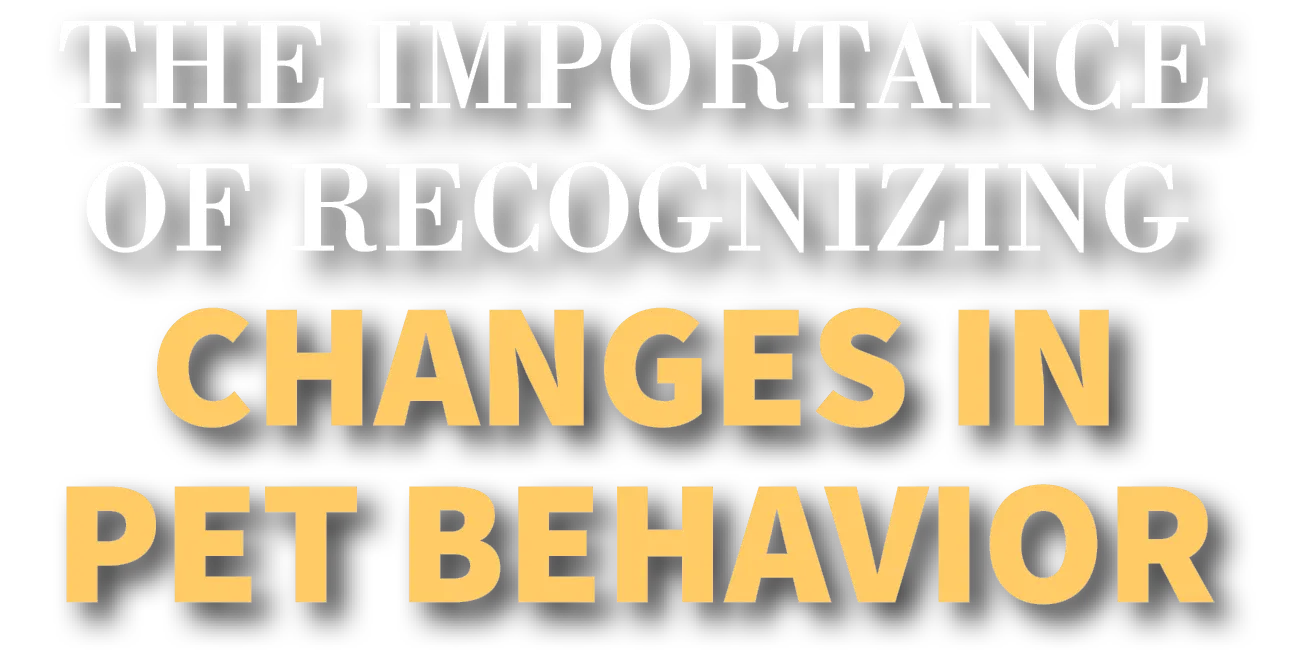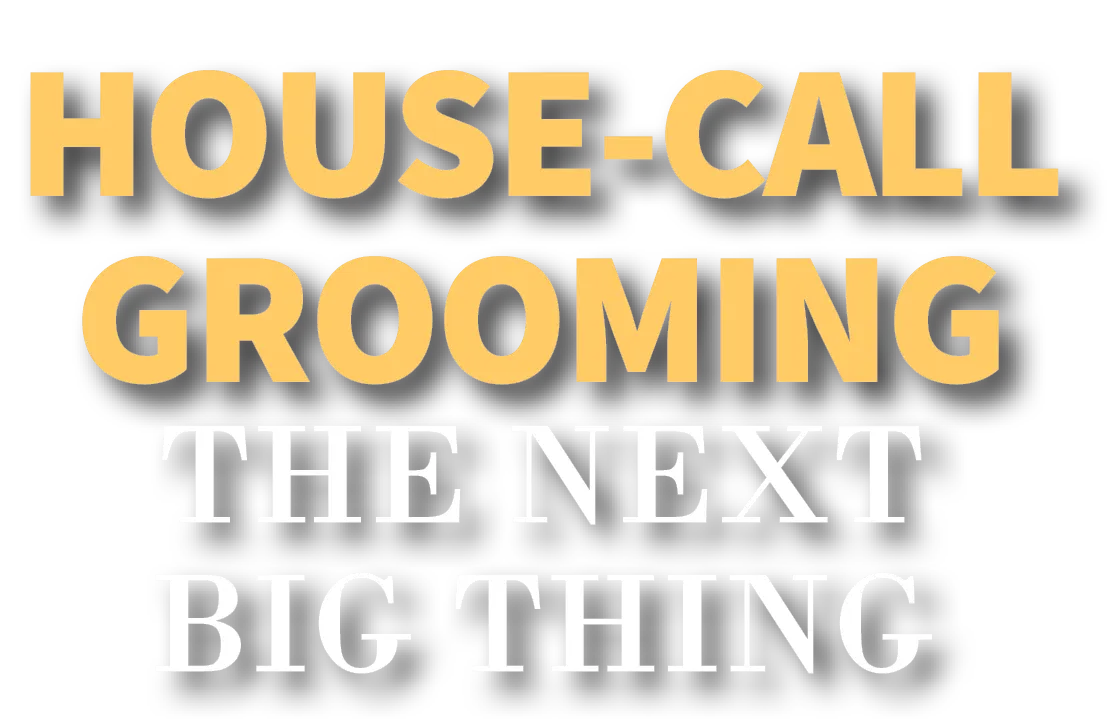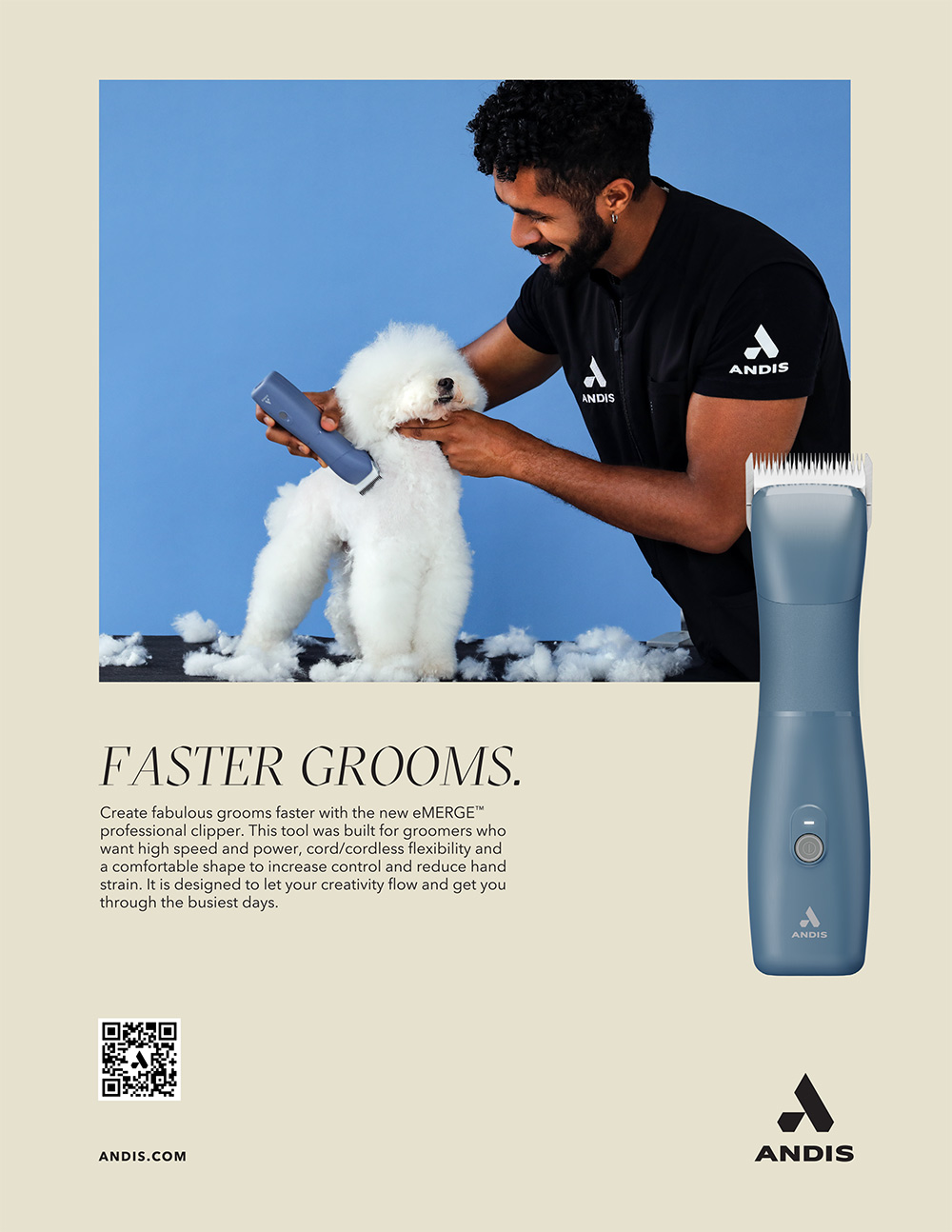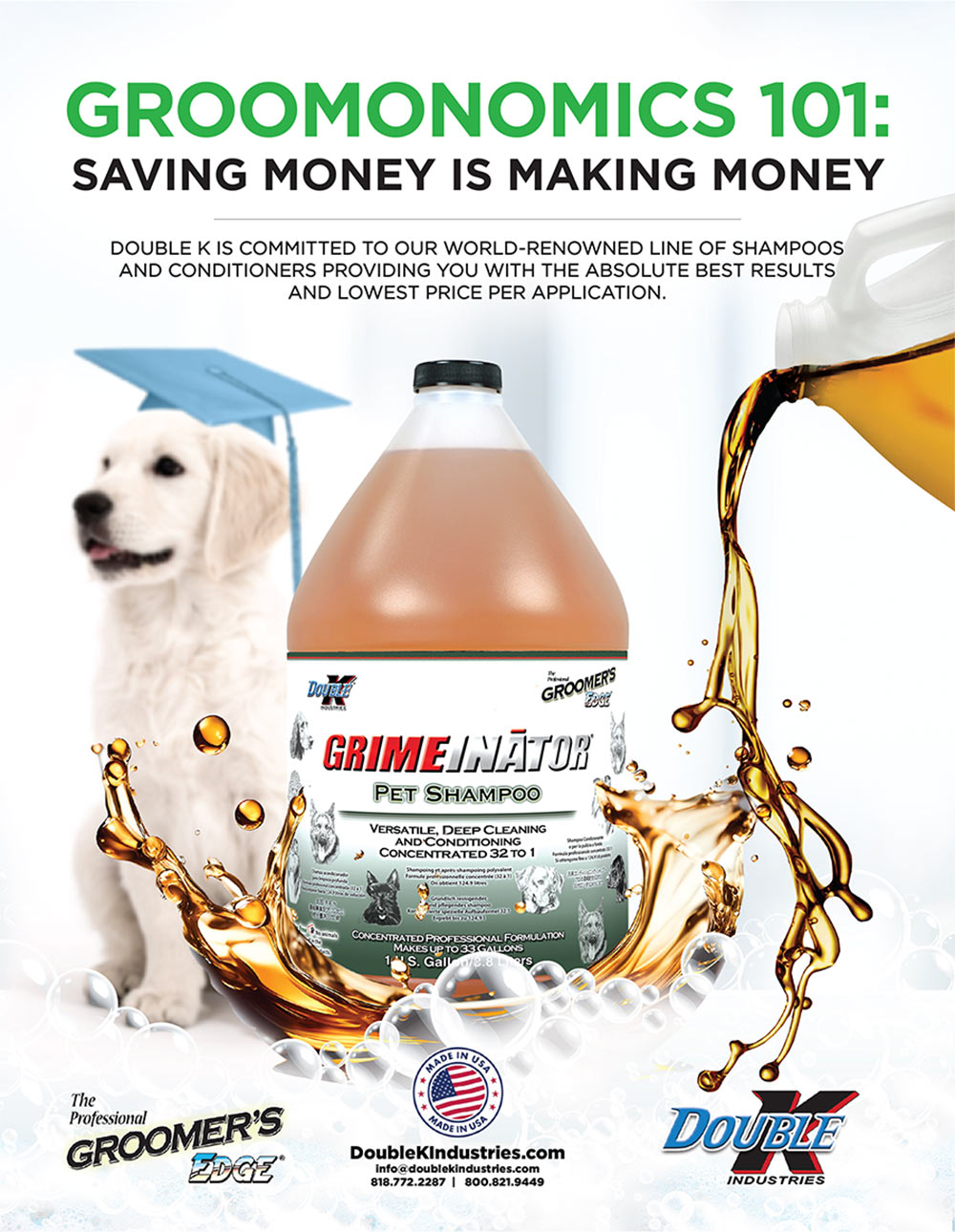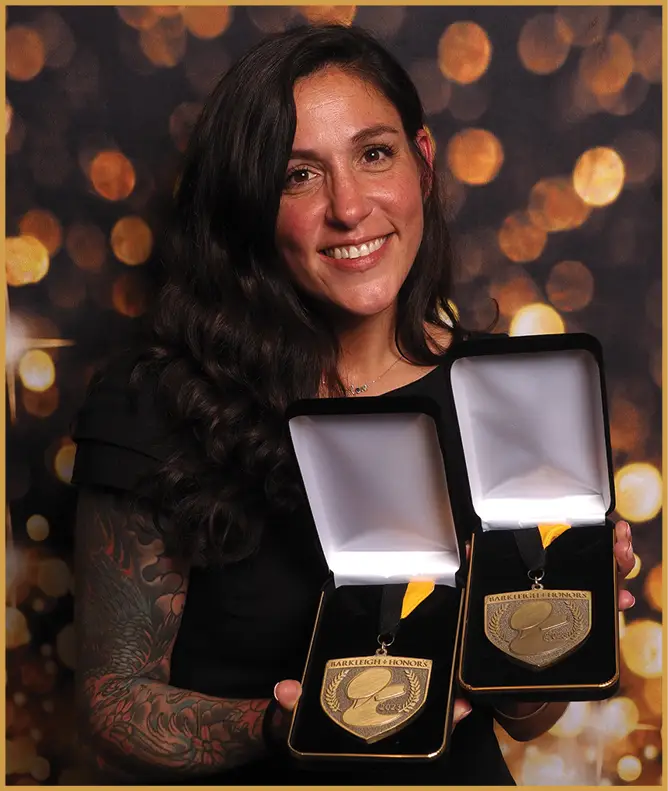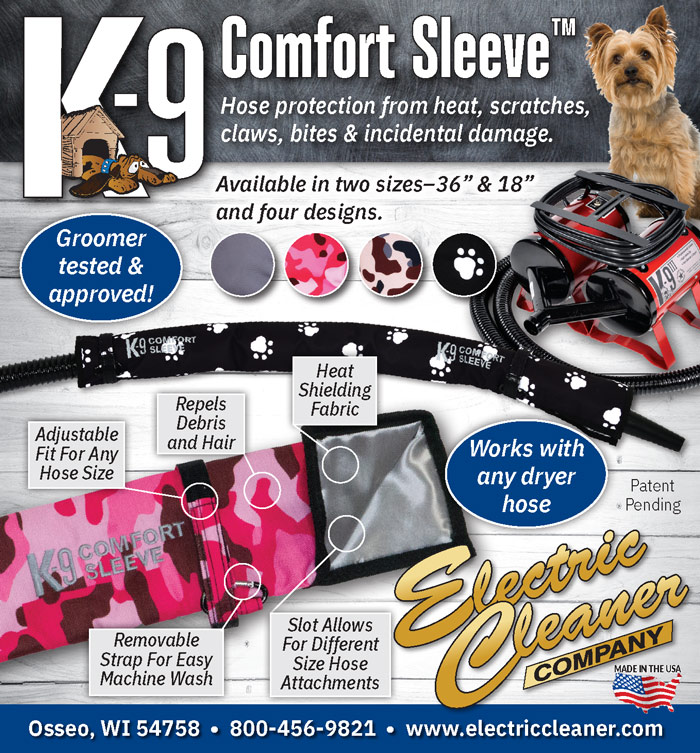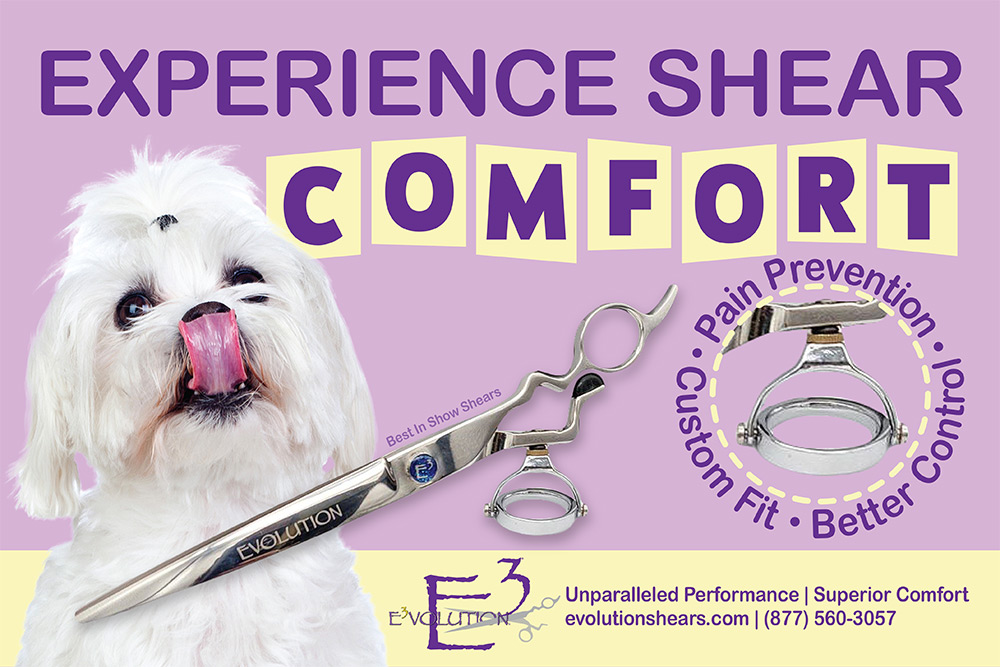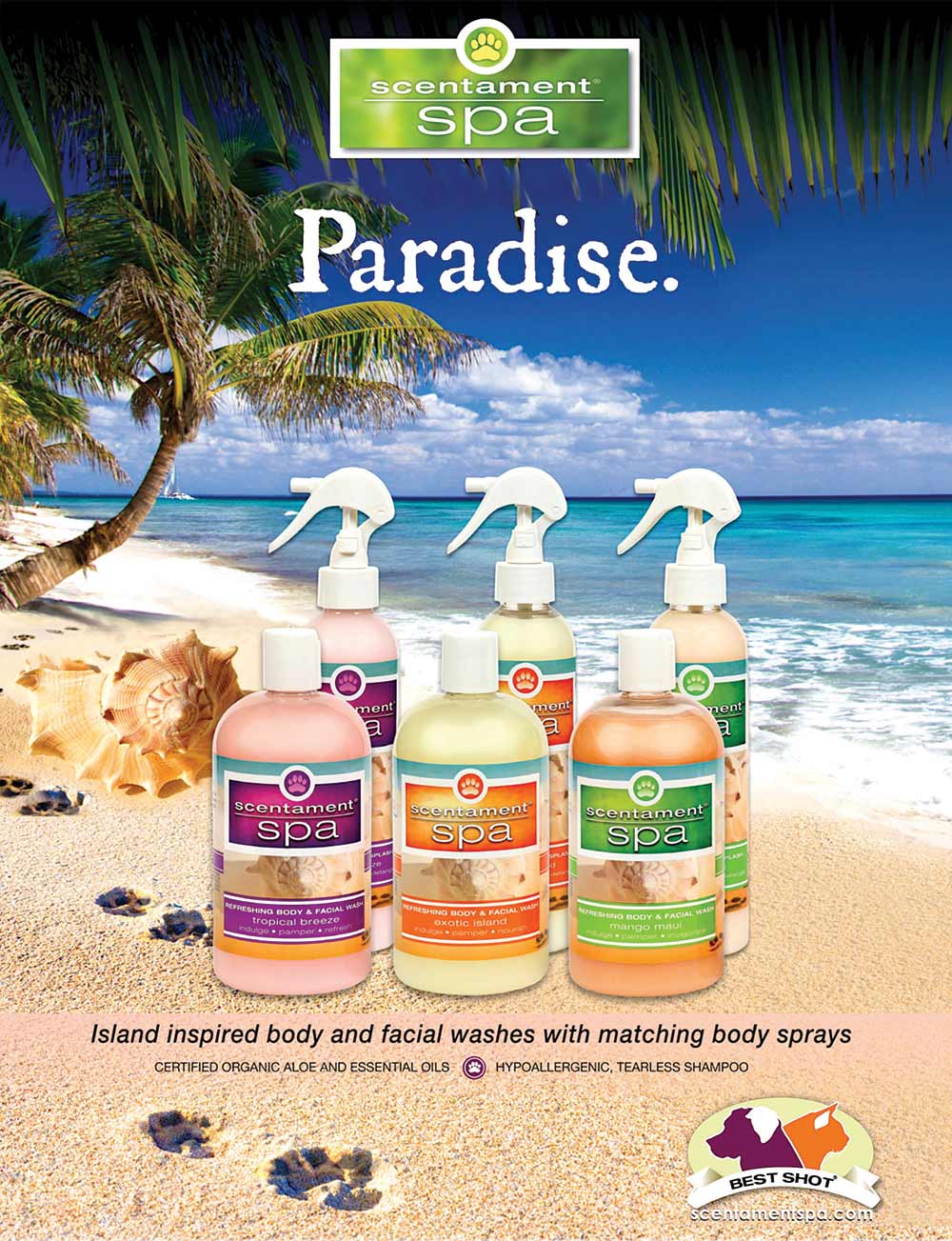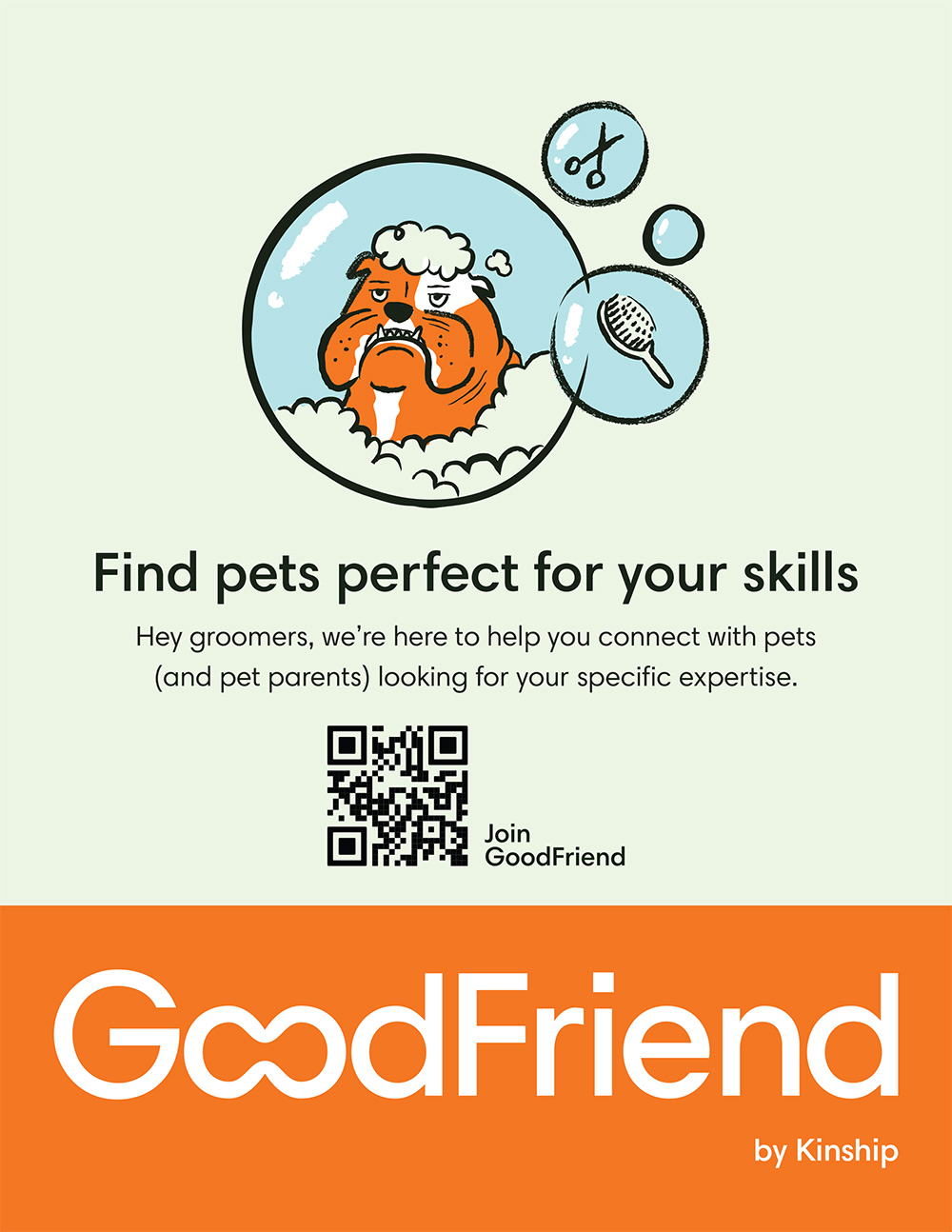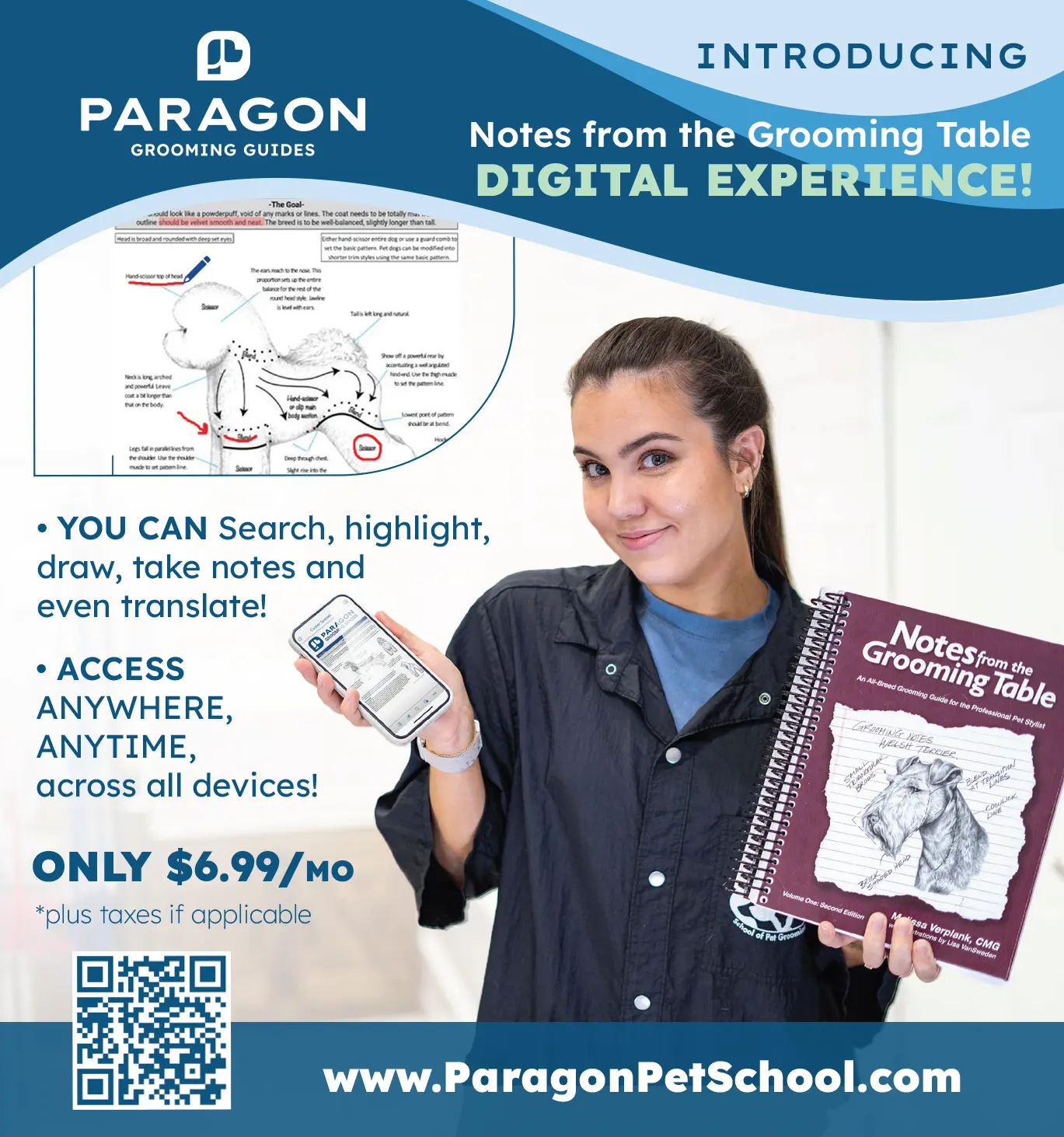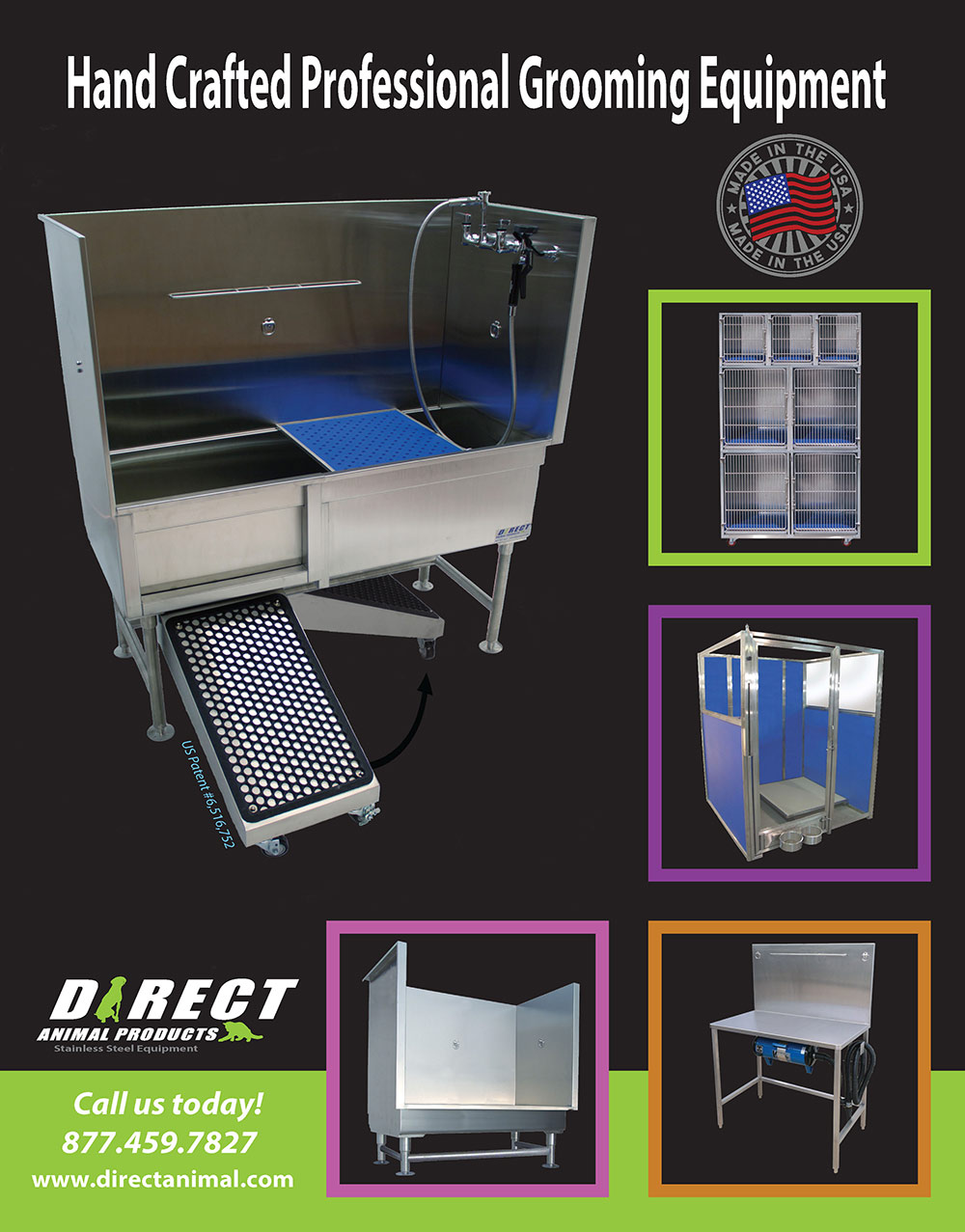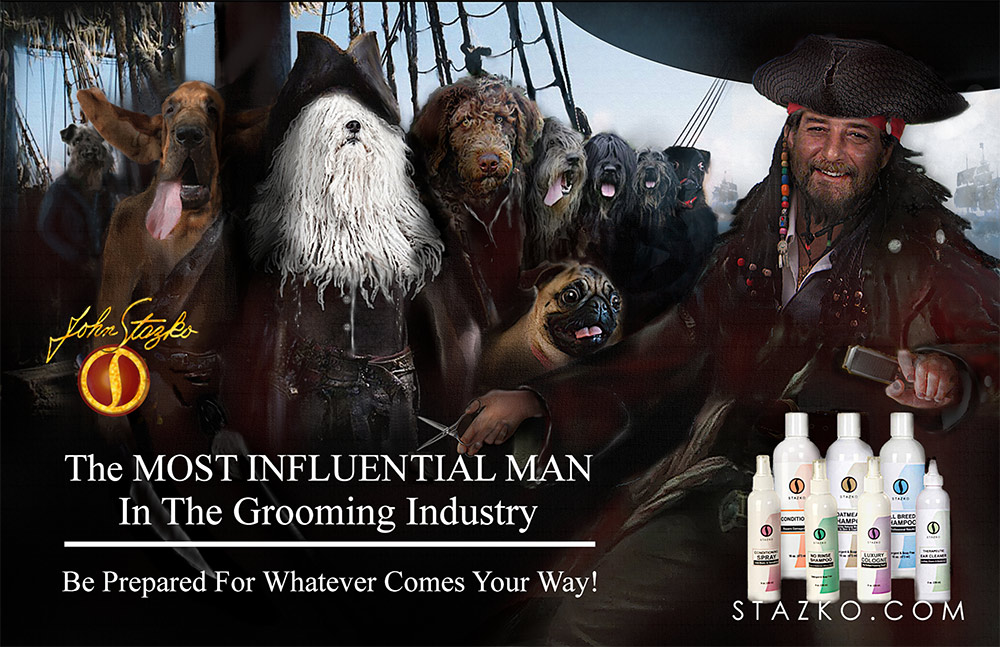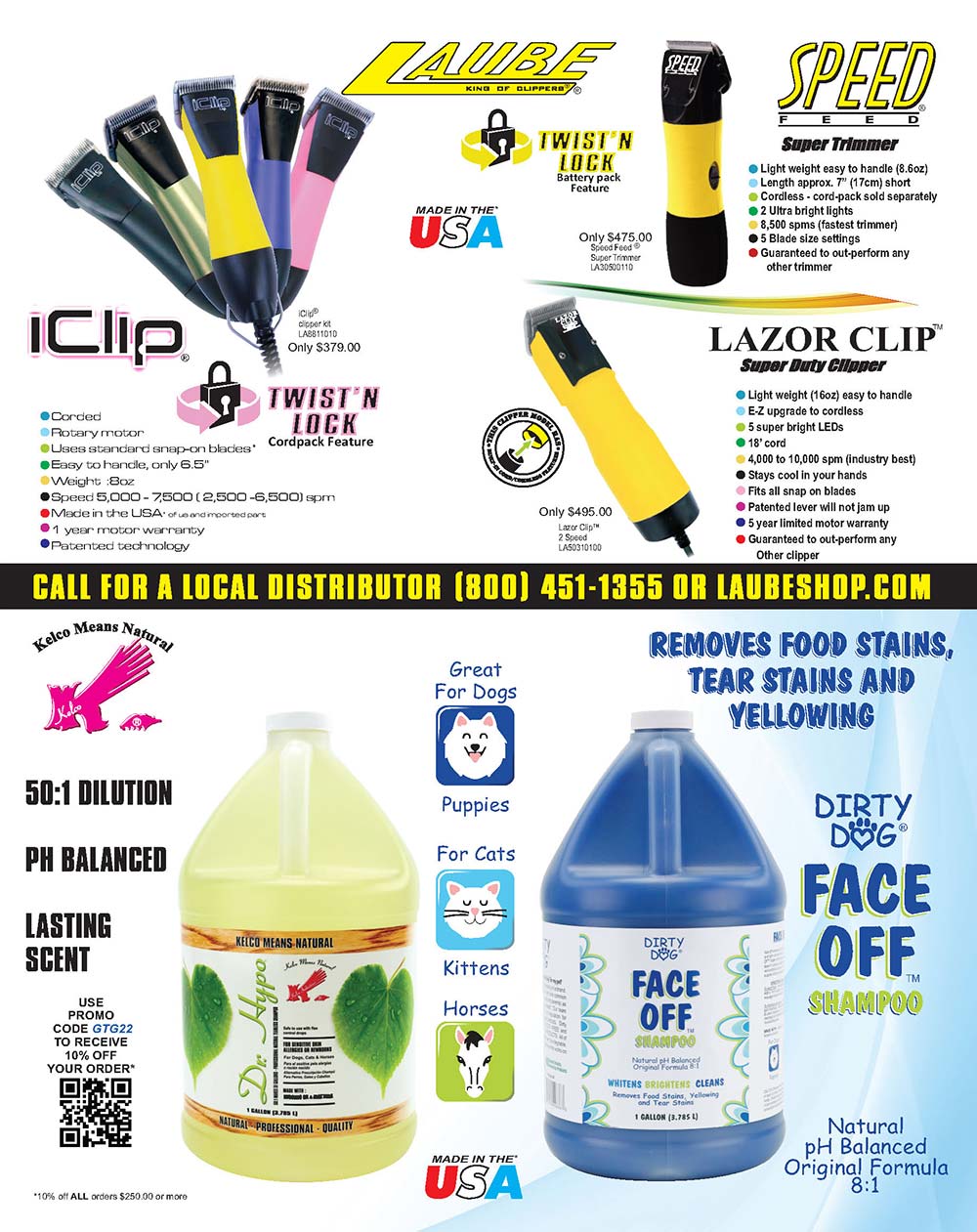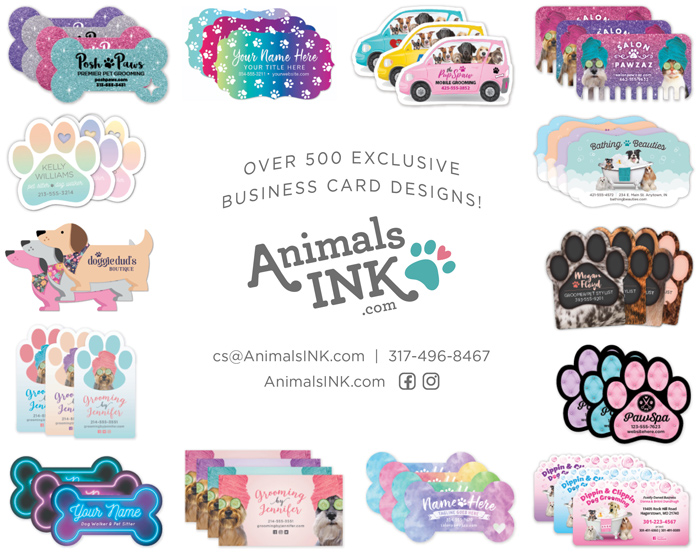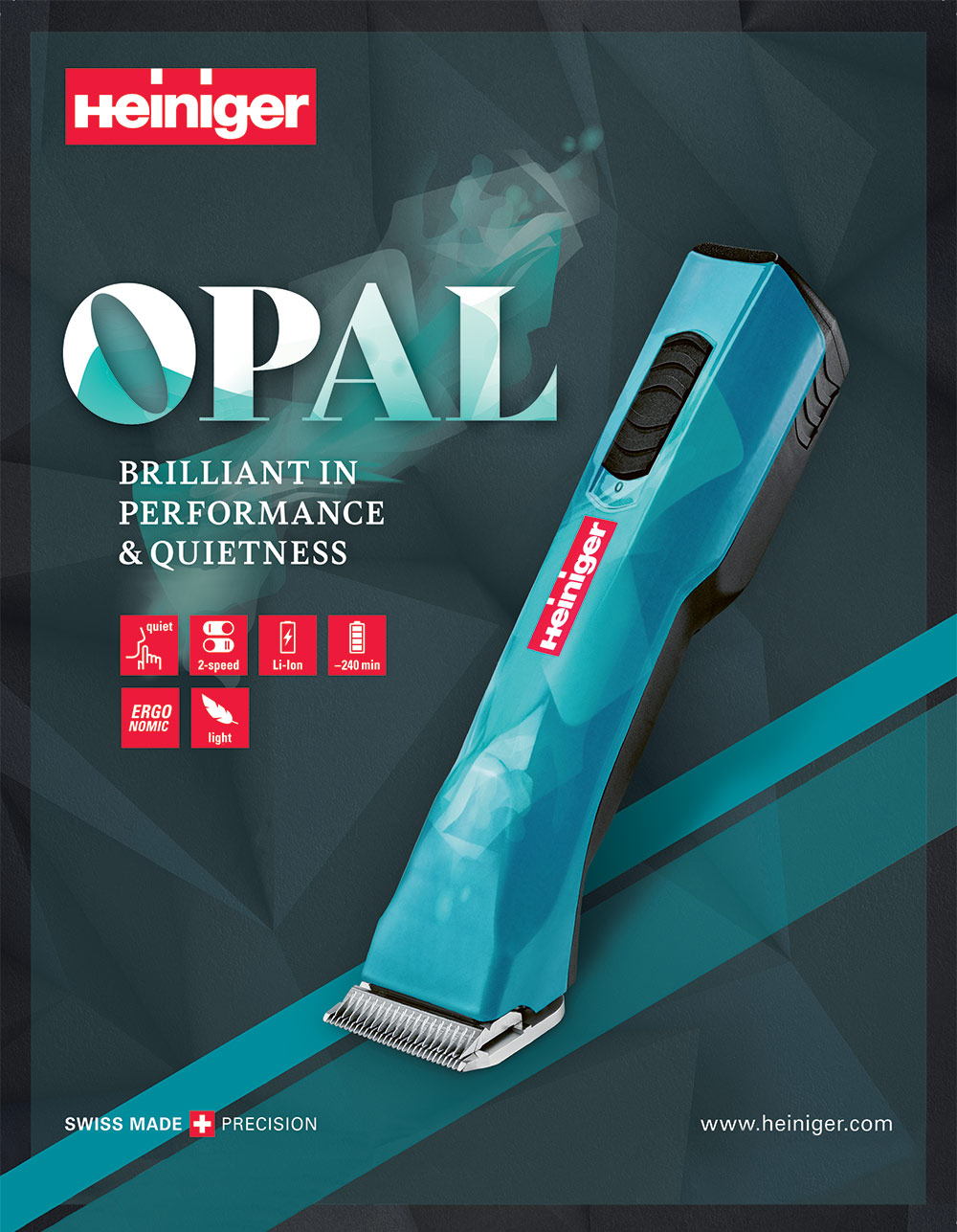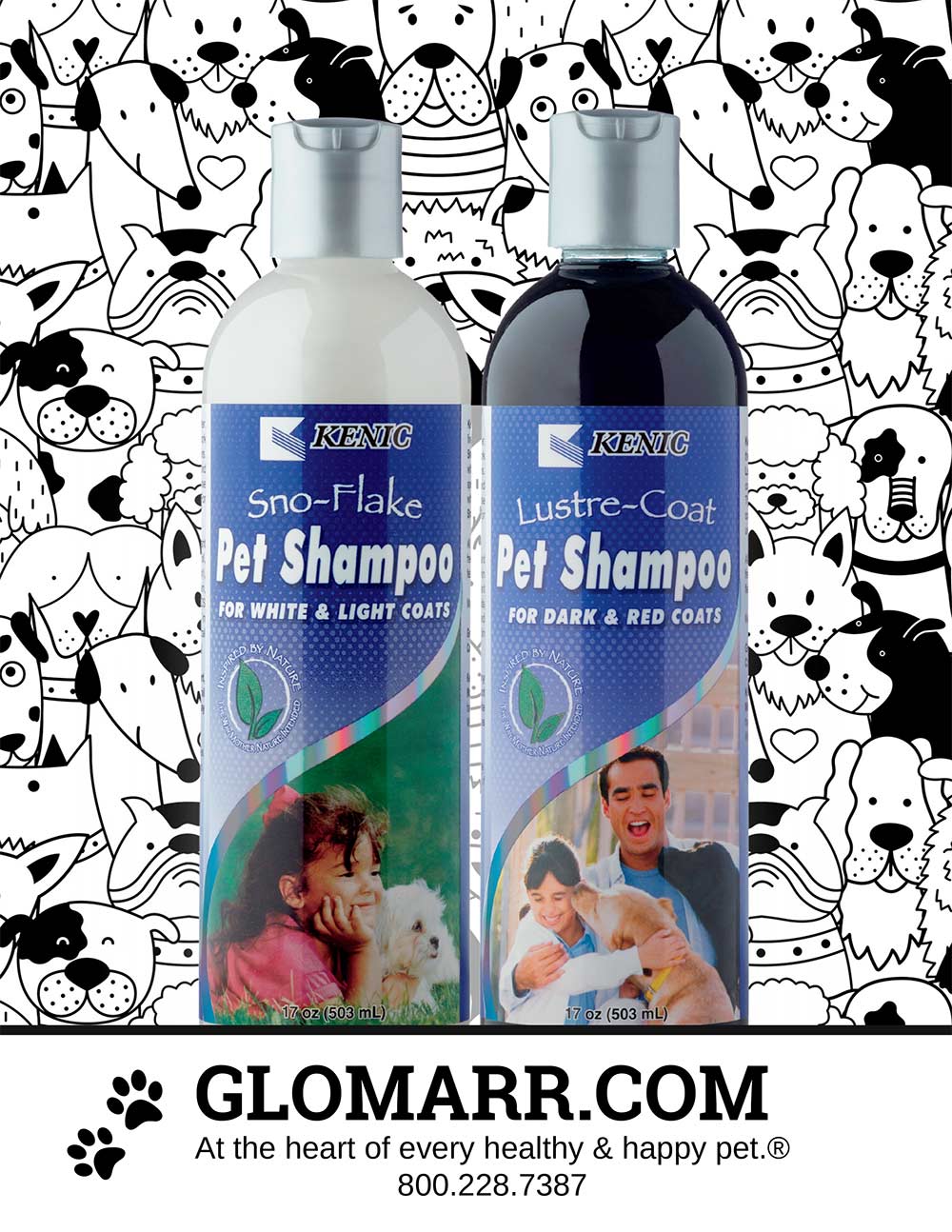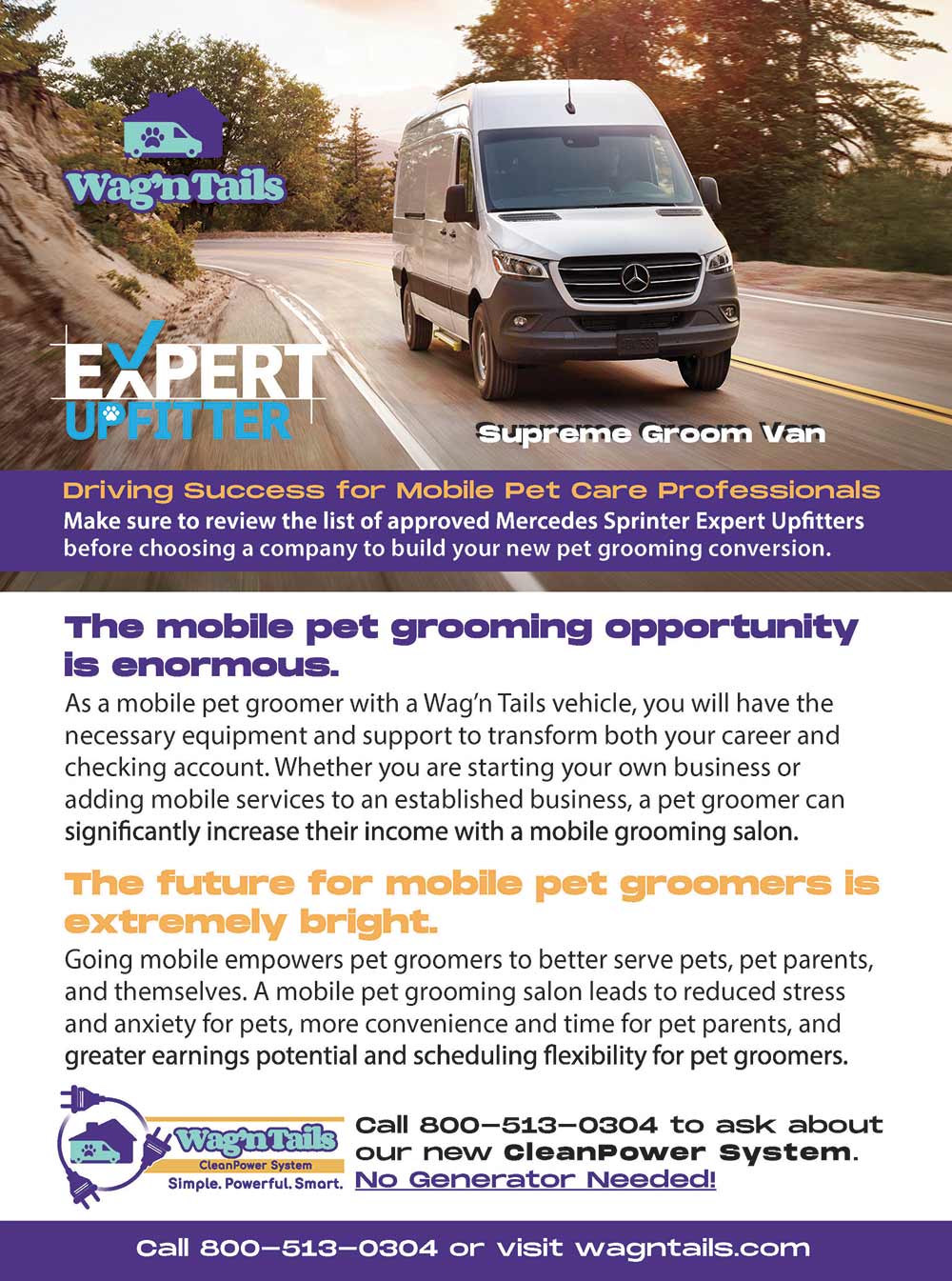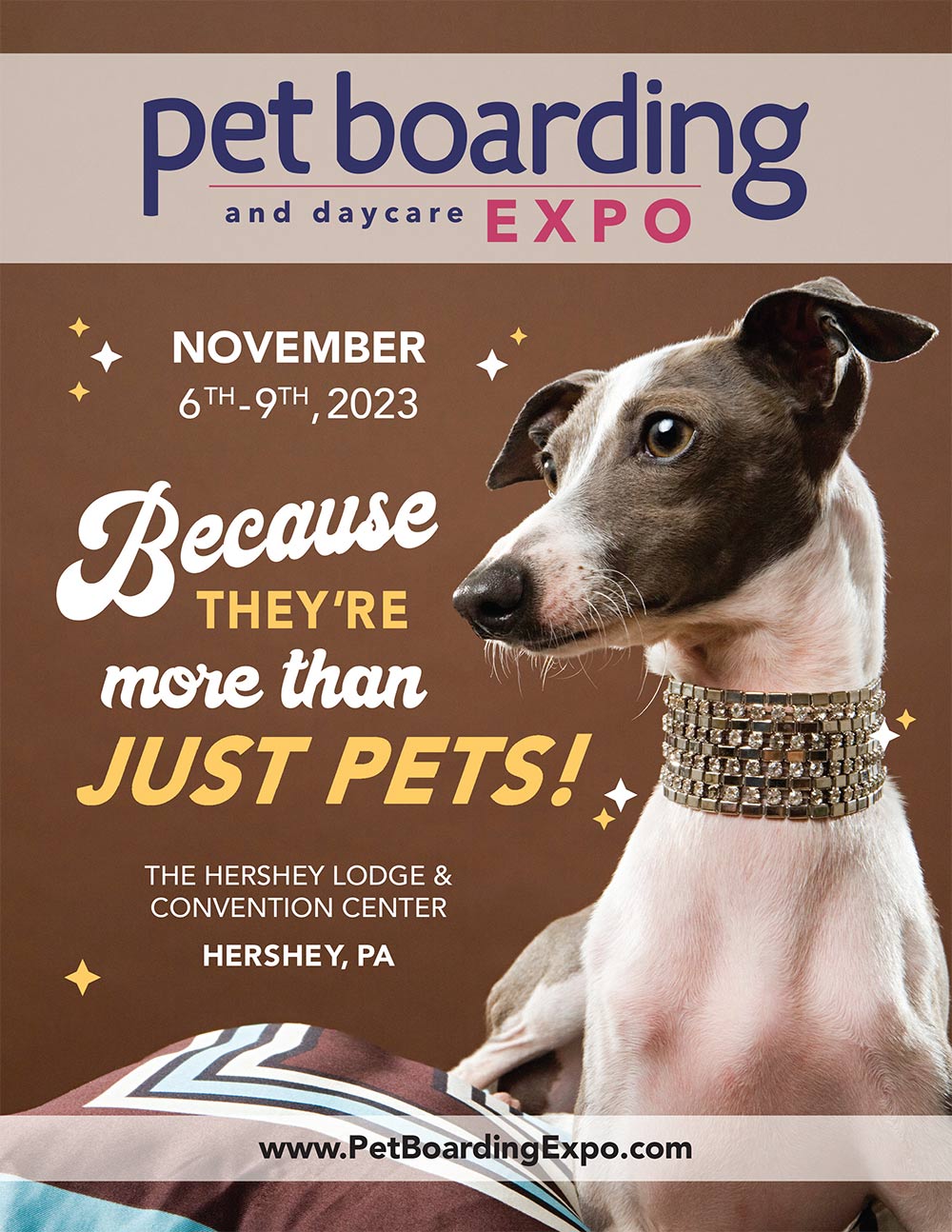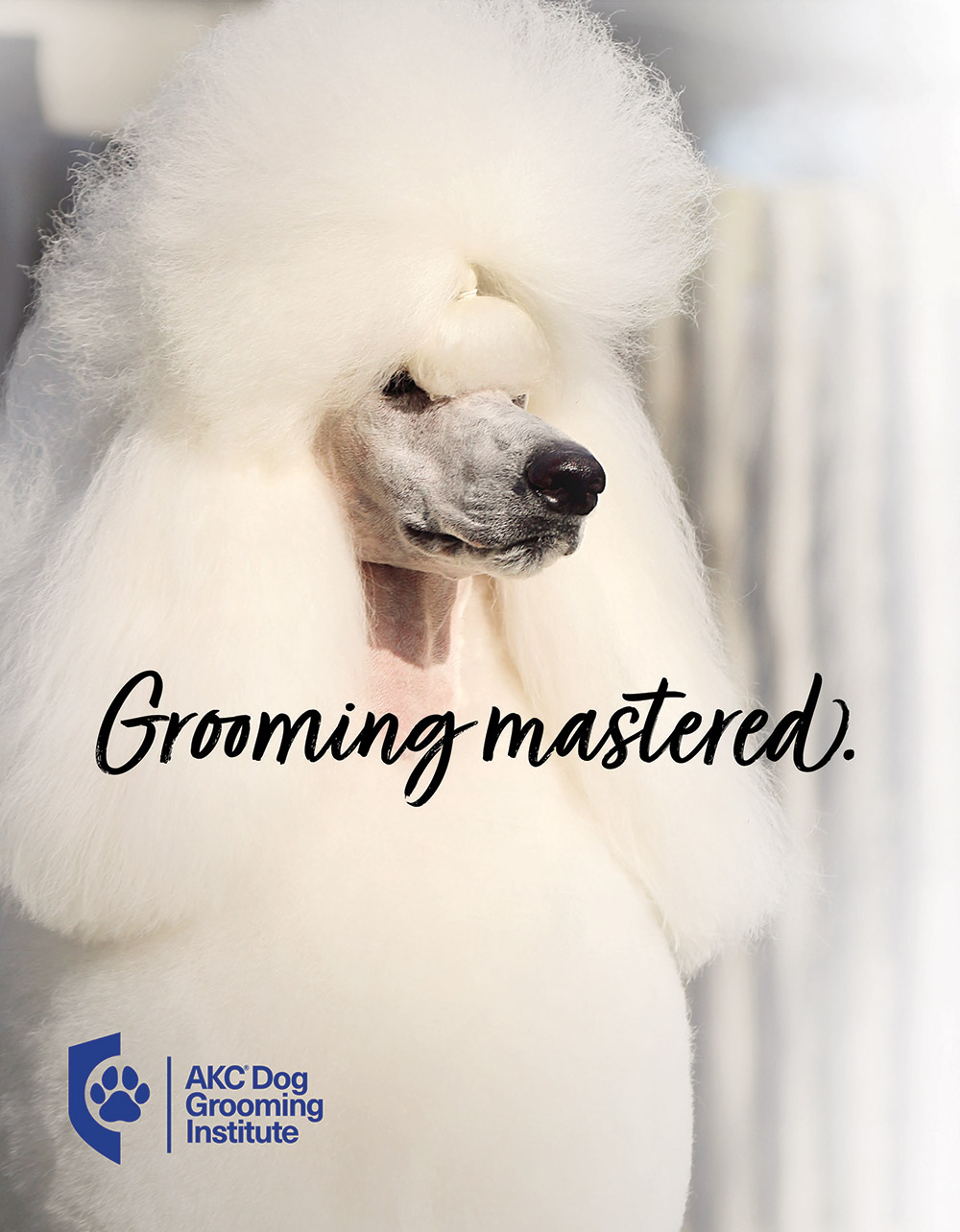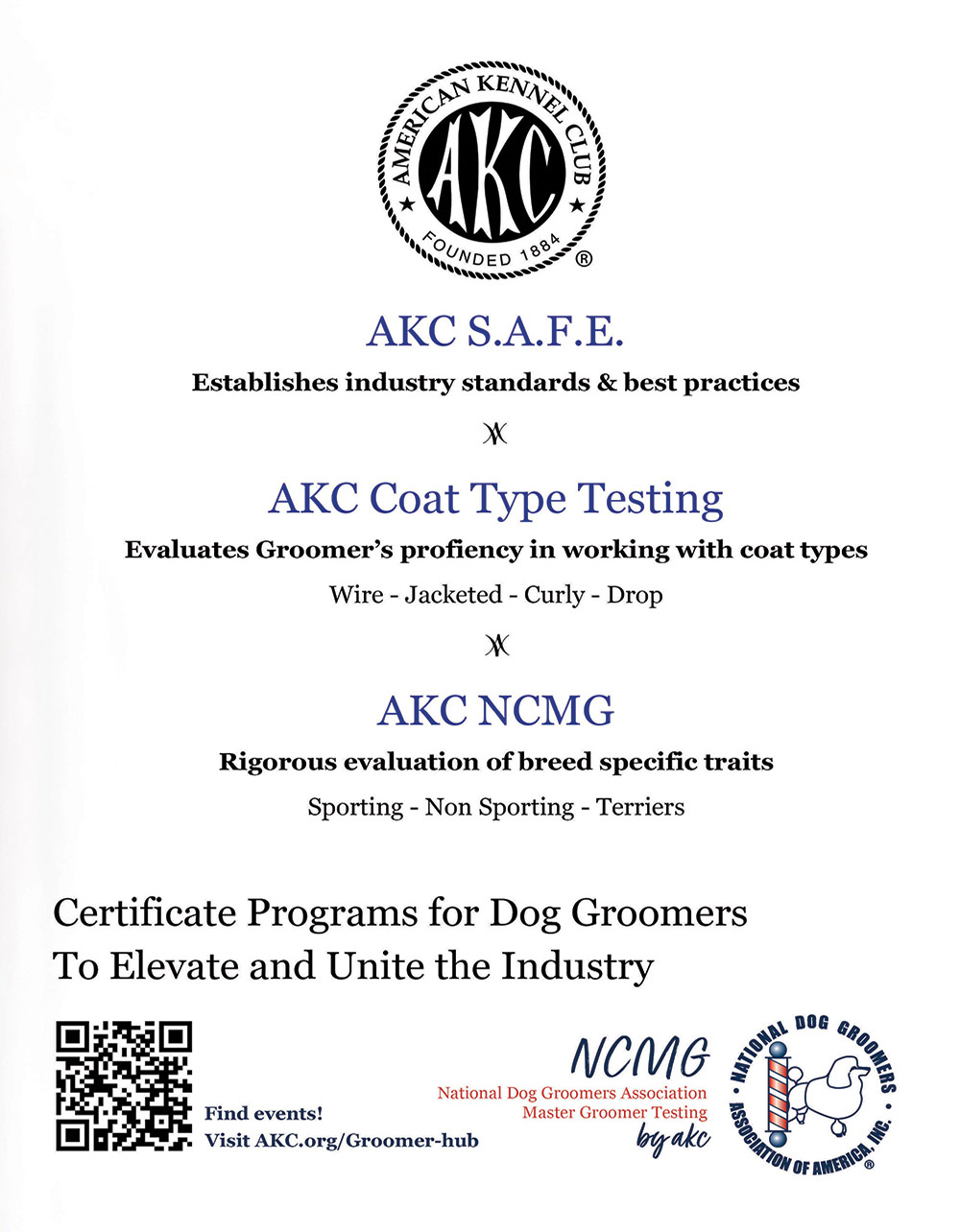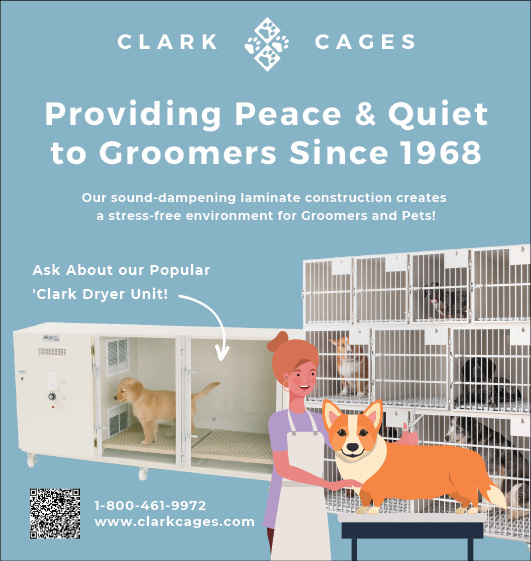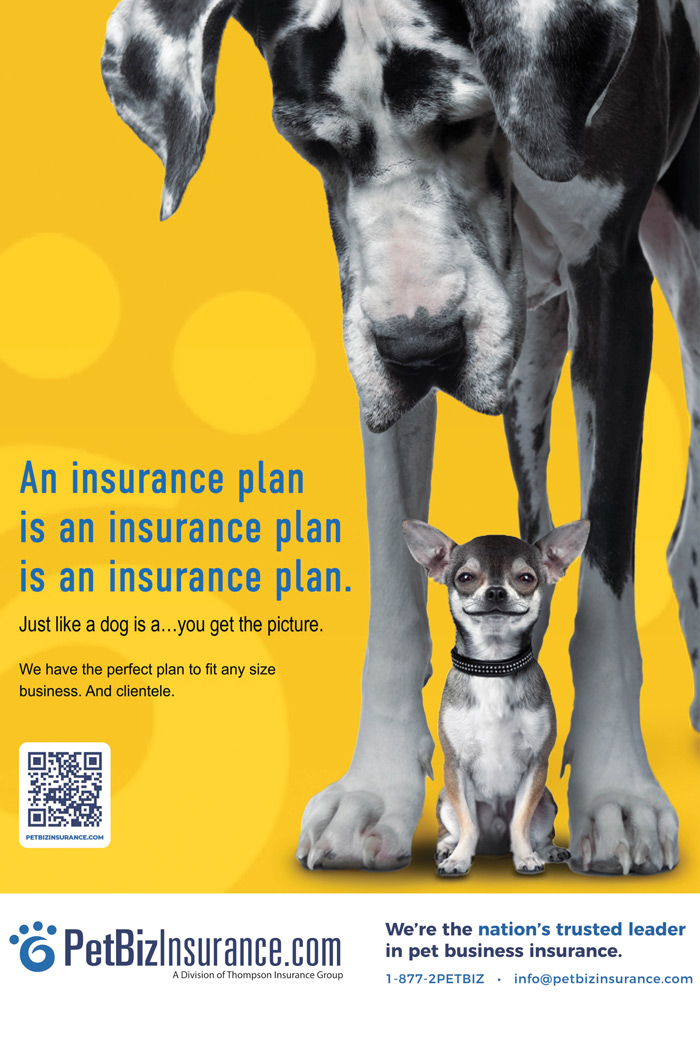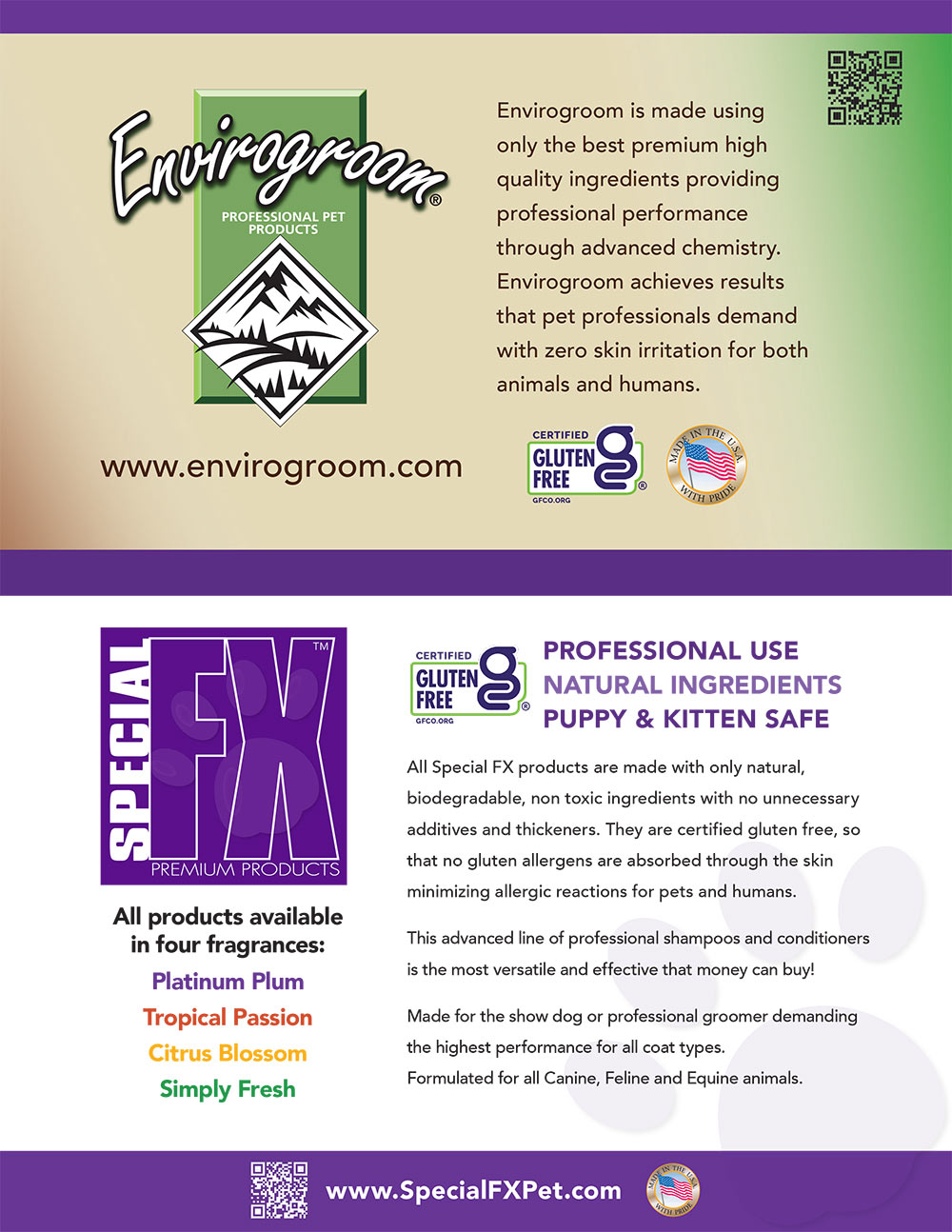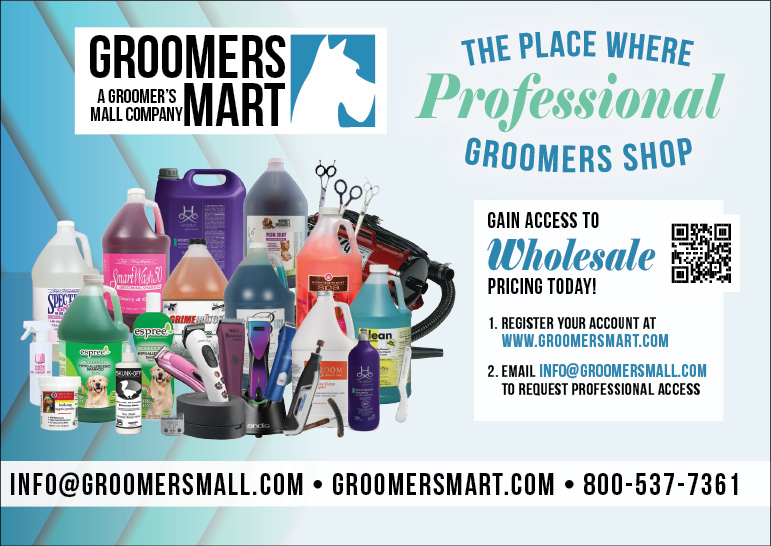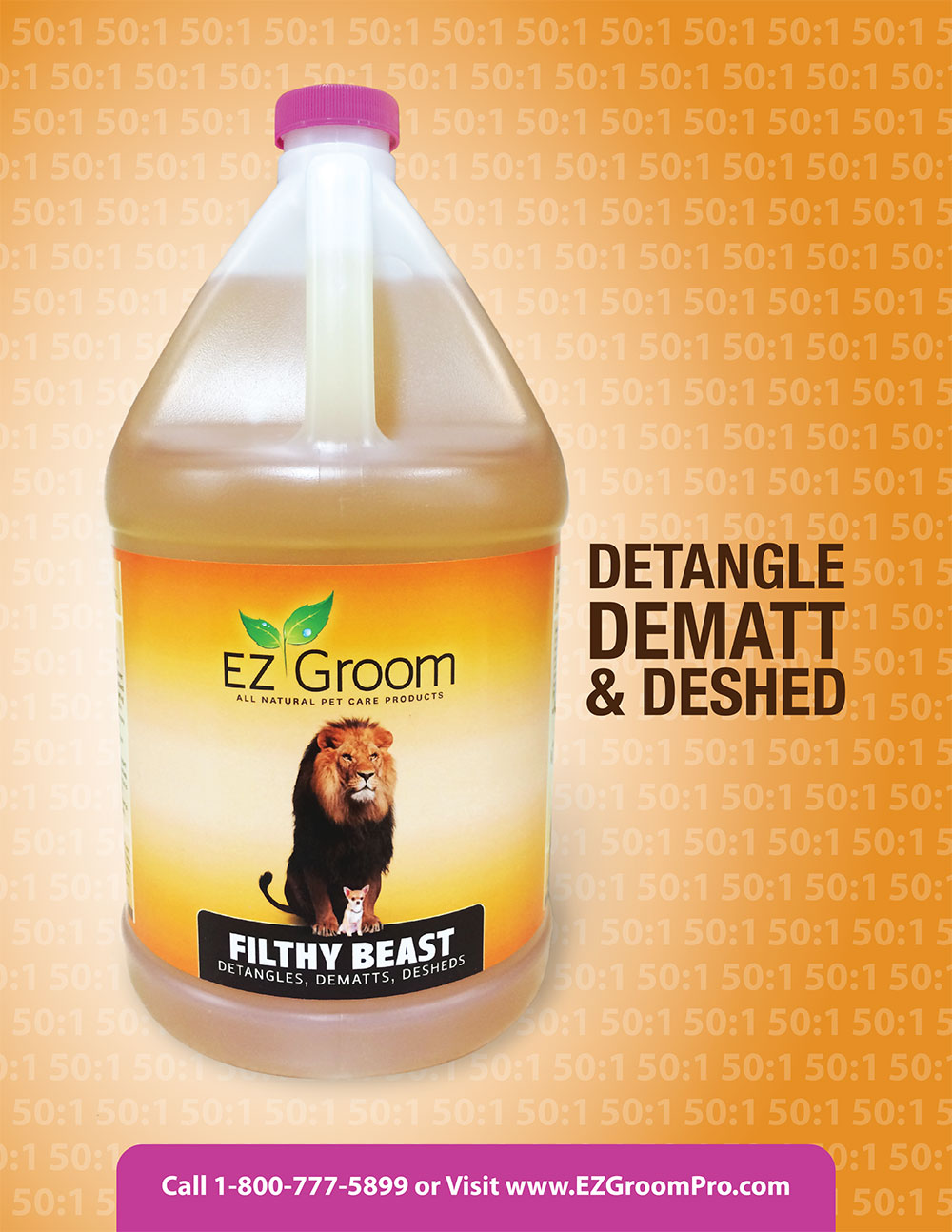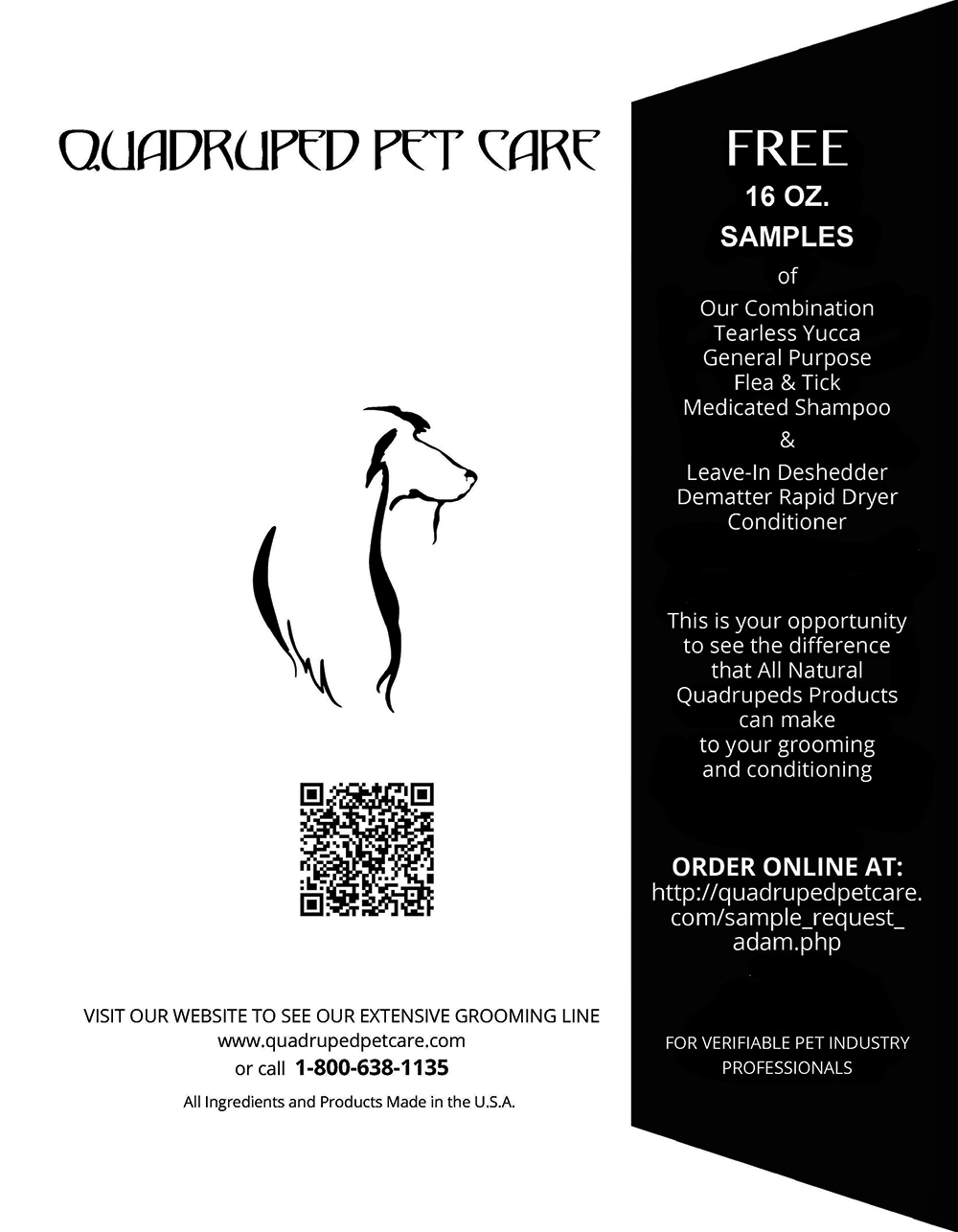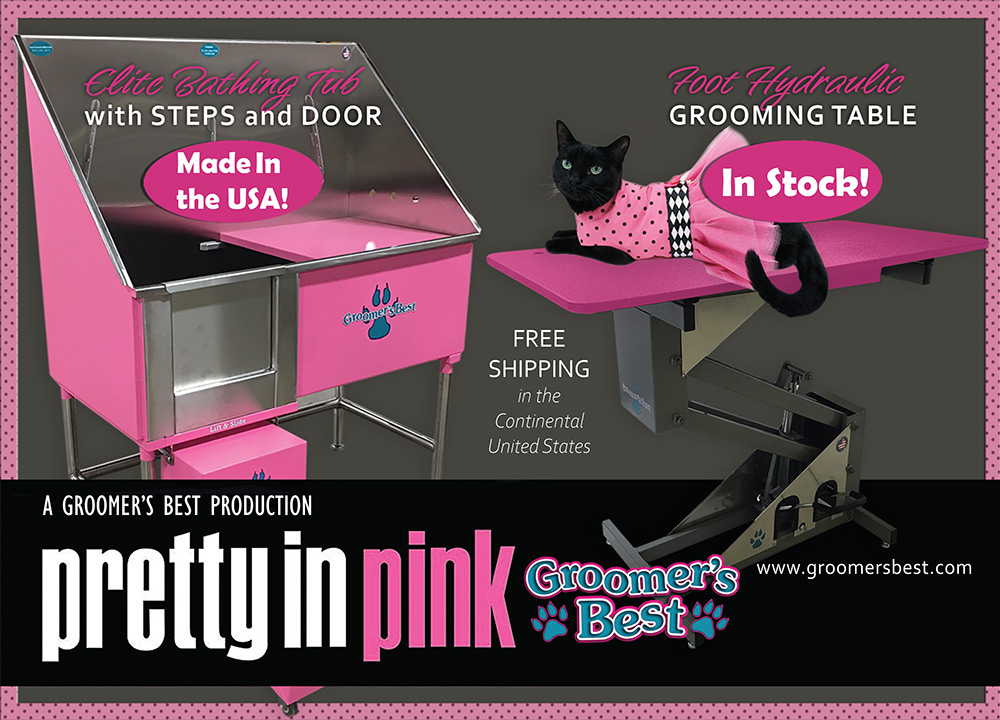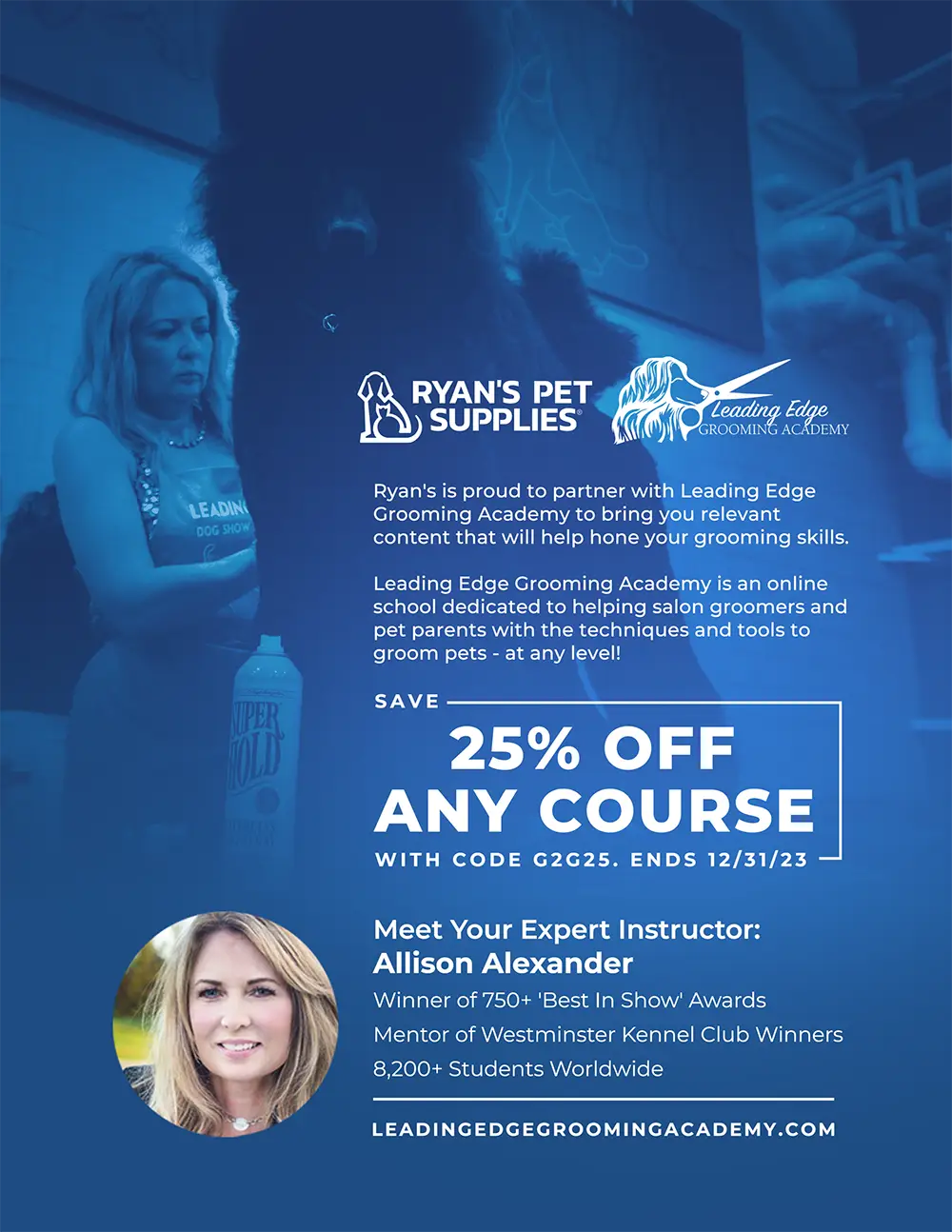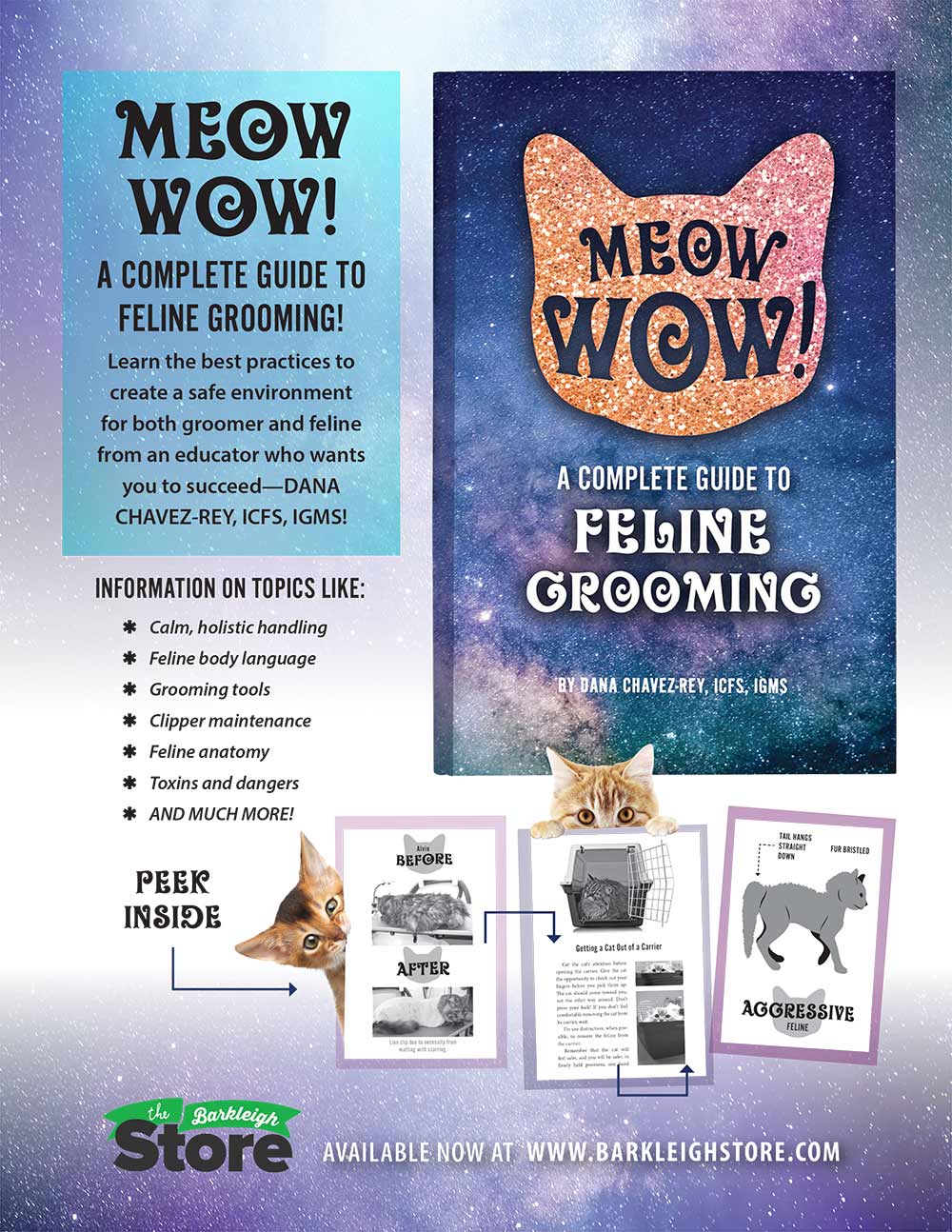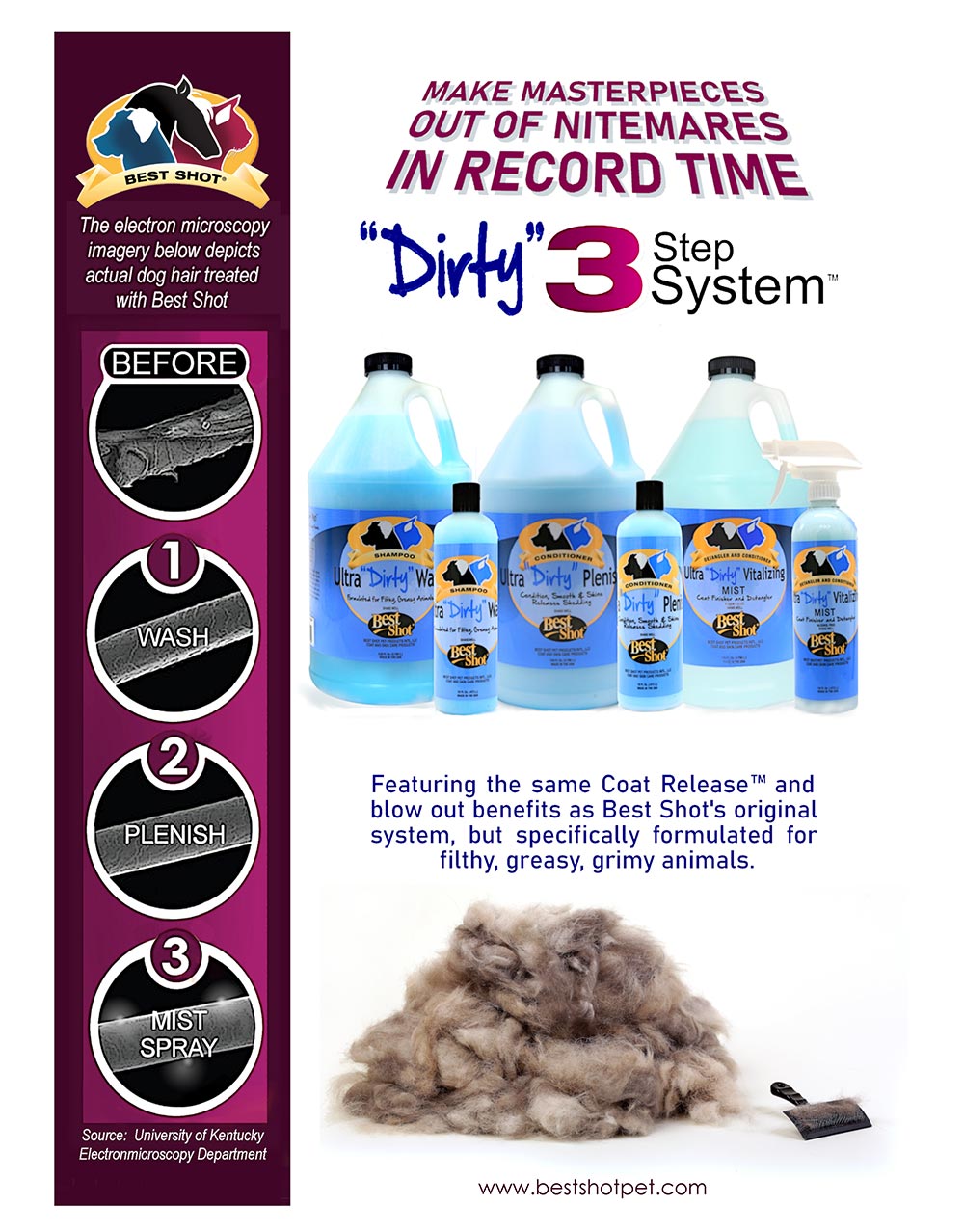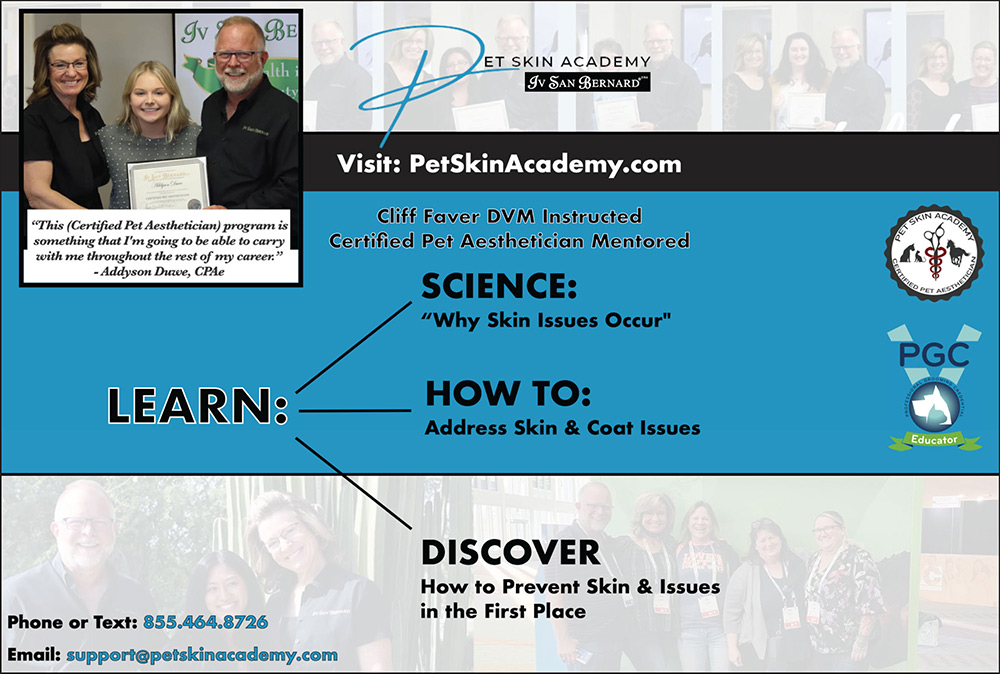Contents | OCTOBER 2023
ALSO INSIDE
todd@barkleigh.com
adam@barkleigh.com
gwen@barkleigh.com
rebecca@barkleigh.com
luke@barkleigh.com
laura@barkleigh.com
brandi@barkleigh.com
carlee@barkleigh.com
evan@barkleigh.com
cassidy@barkleigh.com
allison@barkleigh.com
james@barkleigh.com
karin@barkleigh.com
britany@barkleigh.com
Daryl Conner
Jonathan David
Dr. Cliff Faver
Blake Hernandez
ALSO INSIDE
ON THE COVER

it’s advertisers for their continued support.
- American Kennel Club34
- Andis2
- Animal Photography52
- Animals Ink25
- B Bold Shears32
- Bandanas Unlimited21
- Barkleigh Pet Pro Cruise4
- Best Shot13
- Best Shot55
- Clark Cages38
- Cool Dog Wash Tubs53
- Cosmos Bathing Systems44
- Direct Animal Products19
- Double K Industries3
- Electric Company10
- Envirogroom36
- Evolution Shears12
- EZ Groom41
- Glomarr29
- Groomer's Choice16
- Groomers Mart42
- Groomers's Best48
- Heiniger27
- Kinship17
- Laube23
- Learn 2 Groom Dogs26
- Metrovac49
- Pet Biz Insurance39
- Paragon PetDigital Only
- Pet Boarding and Daycare Expo33
- Pet Lift43
- Pet Skin Academy58
- Precision Sharp30
- Puppy Playground60
- Quadruped Pet Care45
- Ryan's Pet Supplies68
- Ryan's Pet SuppliesDigital Only
- Shor-Line54
- Special FX Pet36
- Stazko22
- Stone Mountain Pet Products18
- The Barkleigh Store47
- The Barkleigh Store51
- The Barkleigh Store59
- The Barkleigh Store61
- The Barkleigh Store62
- The Barkleigh Store63
- The Barkleigh Store64
- Thera-Clean11
- Tool Klean9
- Wag'n Tails31
- Zolitta15










Handling It
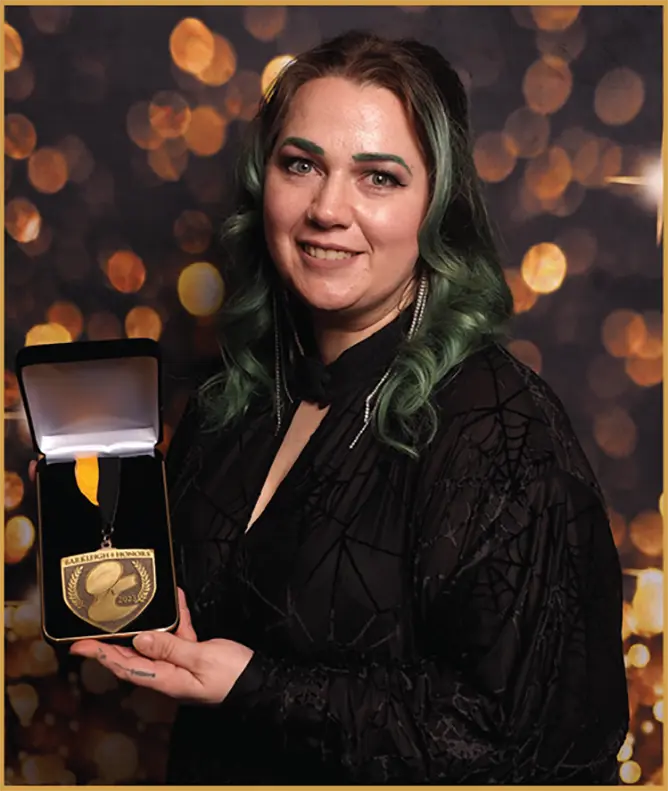



When the Husband Picks Up


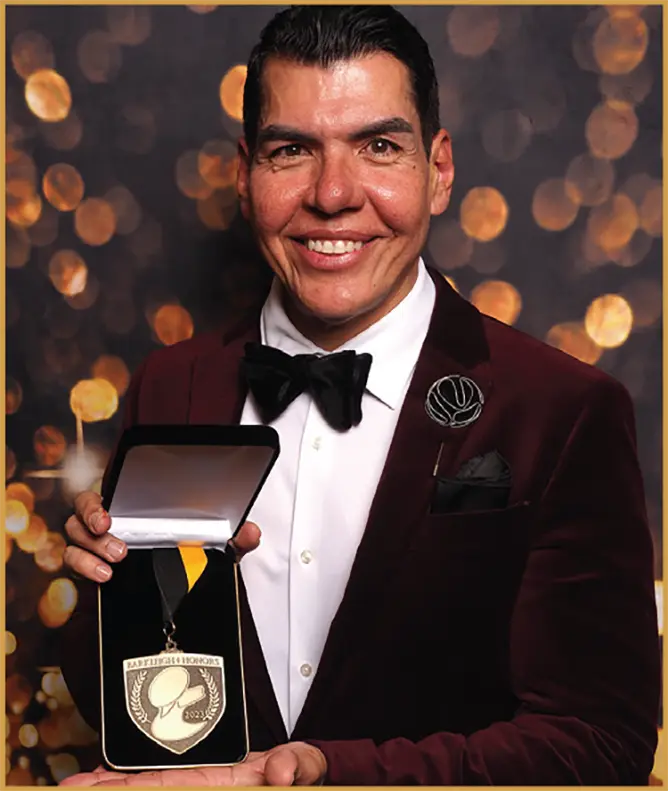

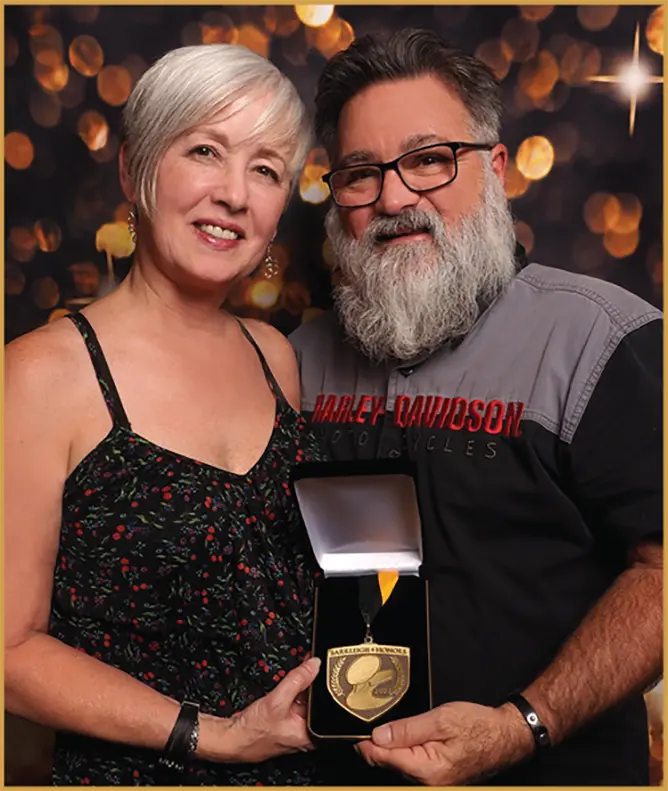

Animal Photography


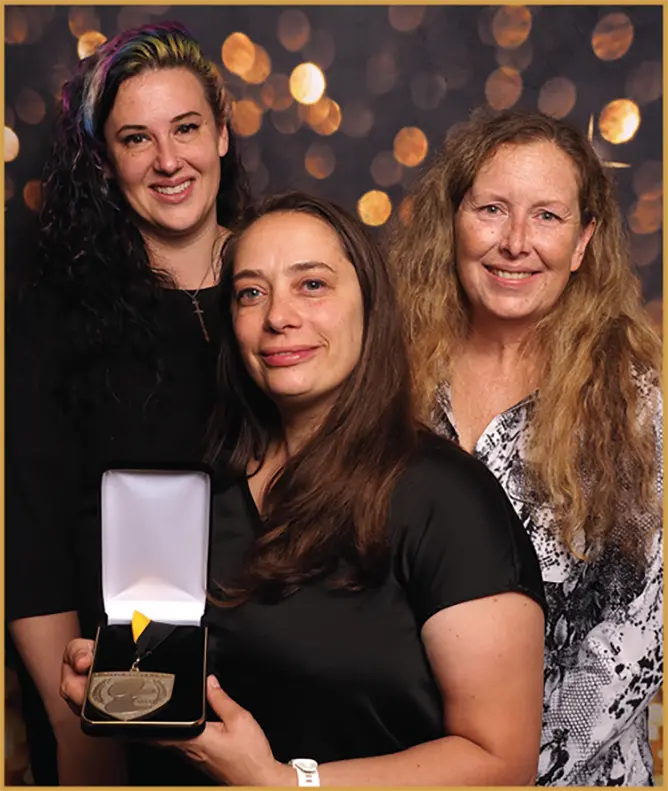

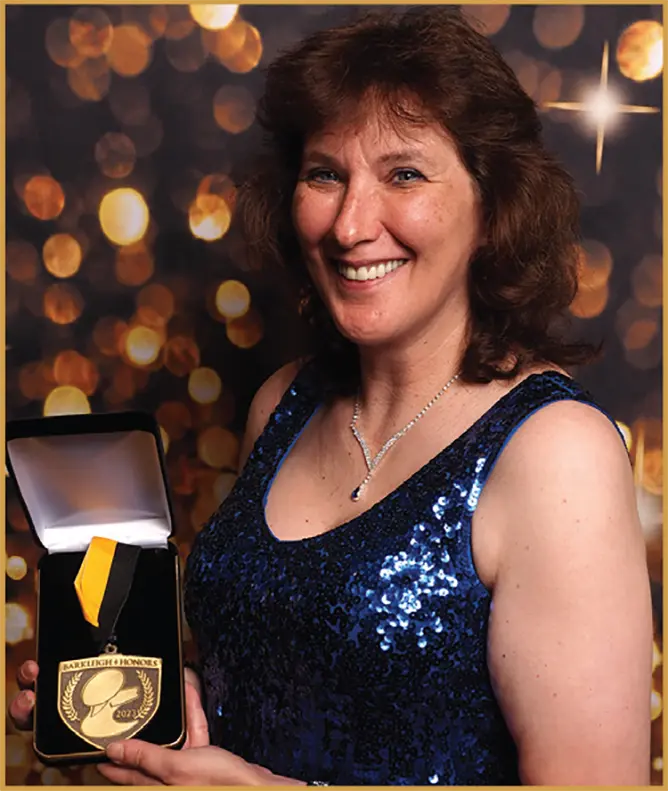

The Quintessential Rabbit
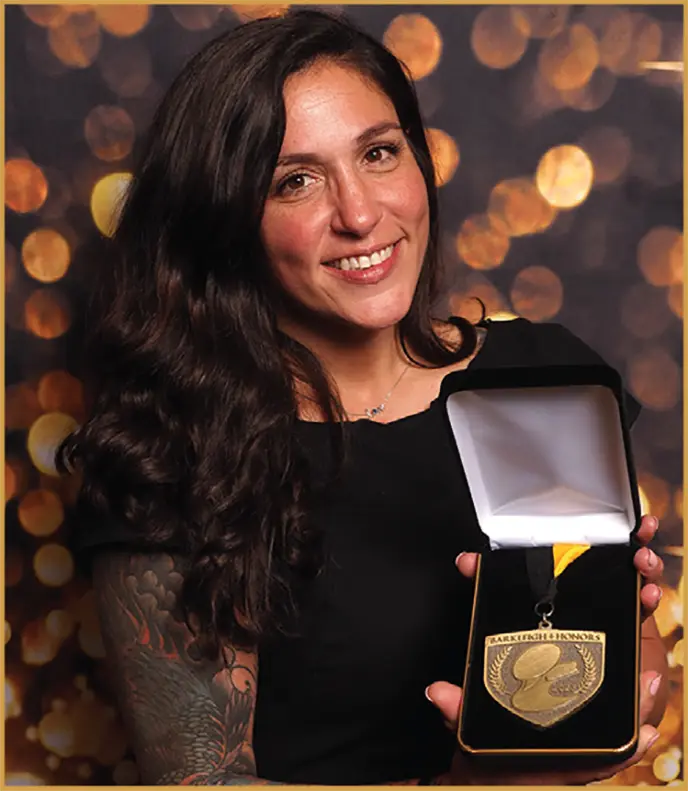

American Cocker
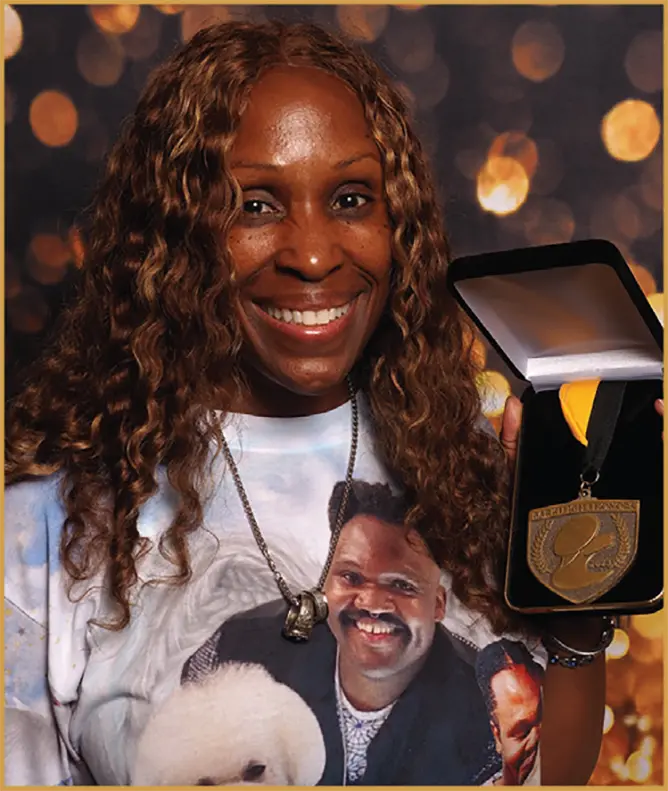



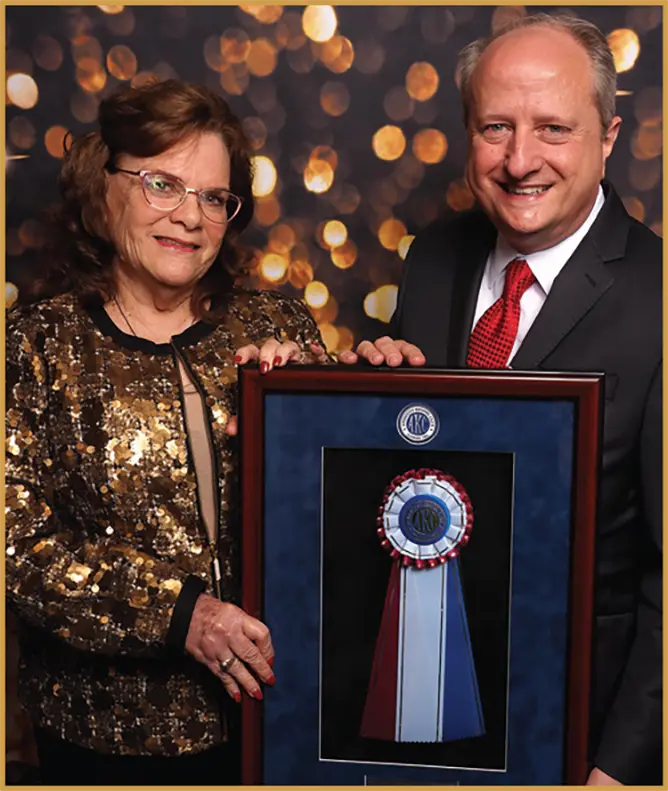



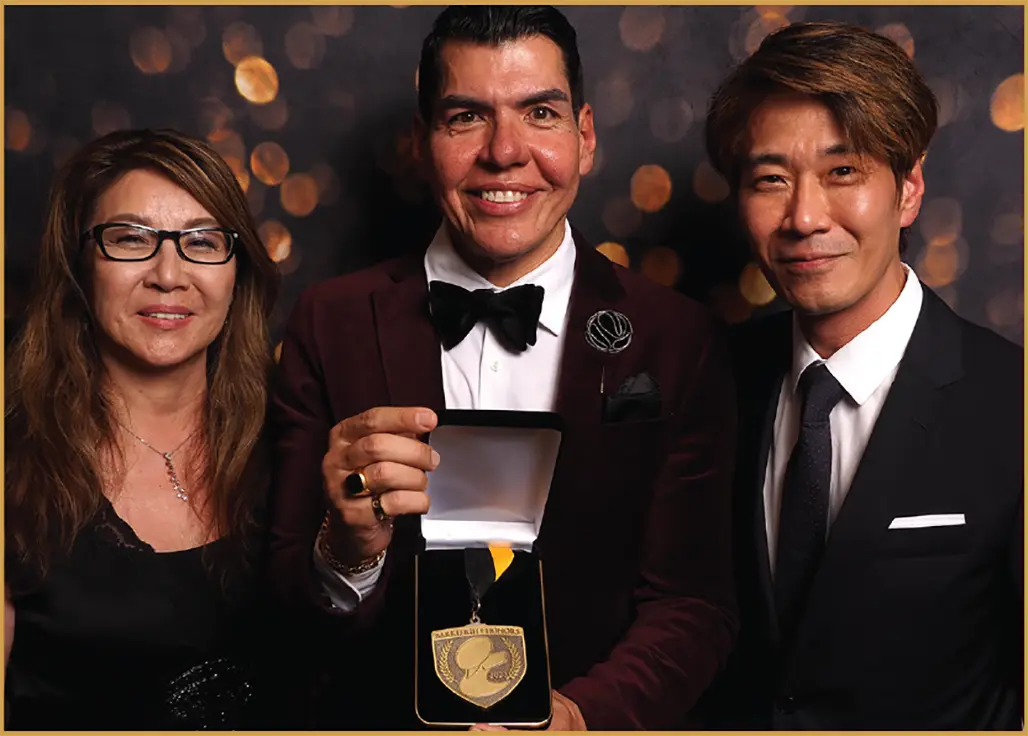

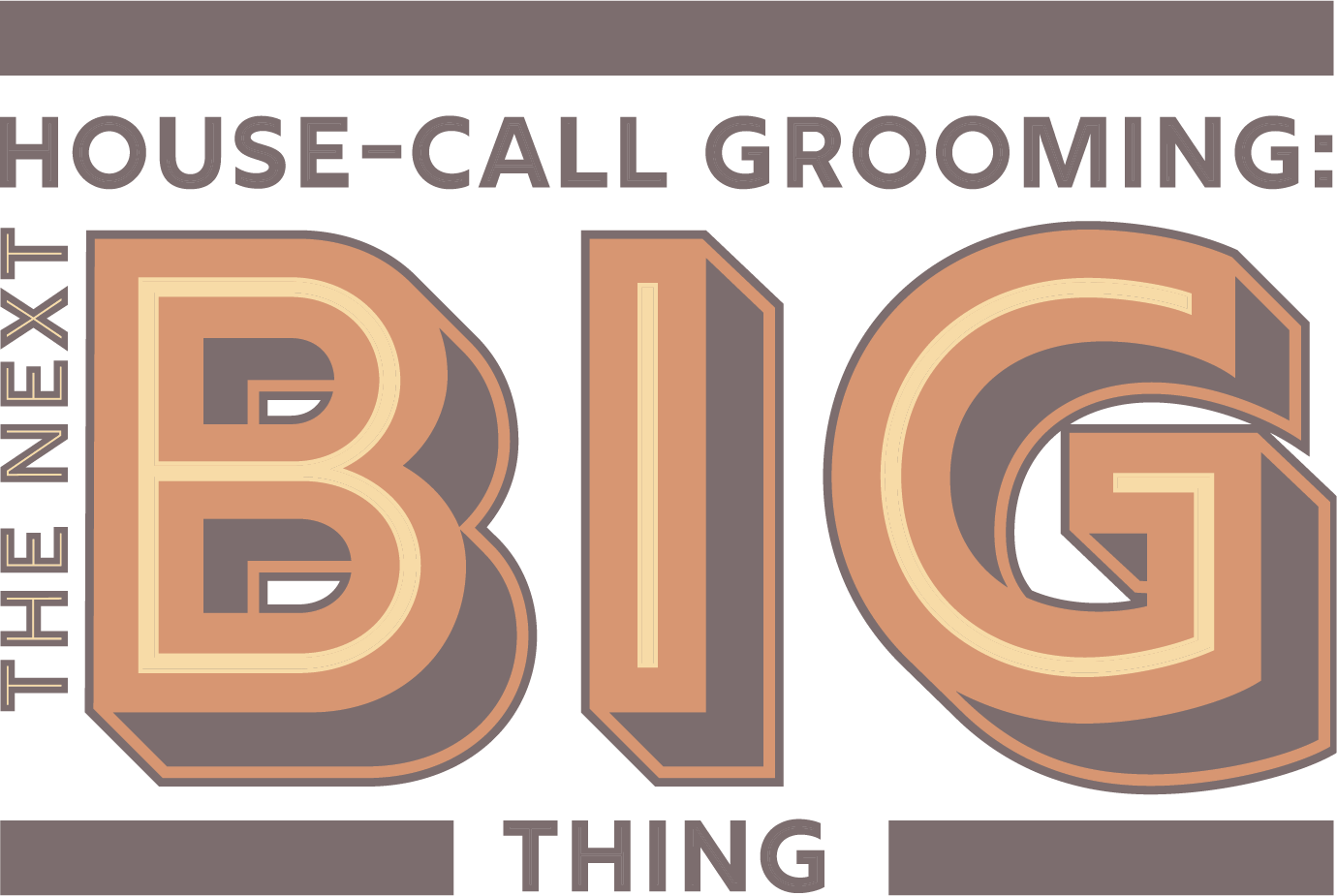
 ouse-call grooming has been around for a long time, but in the last few years it’s really come into its own, especially with the onset of the COVID-19 pandemic. Have you ever wondered how house-call grooming works and if it could be the right choice for you?
ouse-call grooming has been around for a long time, but in the last few years it’s really come into its own, especially with the onset of the COVID-19 pandemic. Have you ever wondered how house-call grooming works and if it could be the right choice for you?
I spoke with veteran house-call groomer Chris Anthony who, along with her many other accomplishments, teaches classes on the house-call model. I also contacted some other house-call groomers from around the country. Here they share some advice, pros and cons, and experiences they’ve had working in this unique model of grooming…
“Some people have the misconception that house-call grooming is not as professional as salon or mobile, or that it’s for groomers who can’t hack it in a salon,” says Chris Anthony. “Nothing could be further from the truth. House-call is a luxury service that is 100% a business.”
The other groomers I spoke with had many reasons why they chose house-call over other business models:
“There were no house-call or mobile groomers in my small town,” shares Kayla Callicotte. “I decided to take the leap. It was the best decision I could have made.”
“I wanted to have my own business and needed the option with the least overhead,” says Tasha Yvonne. “Most of my clients are so welcoming and they treat me like family.”
“I wanted freedom to make my own schedule and choose the types of dogs that I prefer to groom,” Christine Pasieka shares. “I originally wanted to purchase a mobile van but didn’t want the added monthly expense and van upkeep, especially in winter months.”
House-call grooming is not easy. It can be very challenging physically and mentally, but also very rewarding. If you think you have what it takes, how do you get started?
First you decide the size and weight limit of the dogs you will accept, and if you want to groom cats. Next you’ll map out where your service area will be. It’s best to start with a small area before you branch out.
You’ll also need to get business insurance from a company that deals with professional groomers. They can write a policy that will cover everything from a pet injury to a scuff on a client’s wall that happens when you are bringing your equipment in. And, since you will be carrying most of your equipment with you in your vehicle, you want to make sure you have adequate coverage for the vehicle and everything that is in it, should it get totaled or stolen.
When it comes to tools and styling products that you’ll use in your house-call business, try to keep it simple. Remember, you have to carry all of your equipment into the client’s house and then back out to your vehicle.

“I looked into a durable rolling bag,” Leticia Ybarra shares. “The one I decided on not only fits everything I need, but it has cup holders and seconds as a seat for me during the groom, which is a must! I put all my tools including shampoos and conditioners inside. I attach my high-velocity dryer on top and secure my table arms in the pockets. Then I can make one trip (table in one arm and rolly dragged by the other).”
“When you set up in someone’s home, try not to be near fragile knick-knacks or papers on a desk—anything that your dryer could blow off,” Chris Anthony warns. “And, when you choose your dryer, be conscious of how many amps it uses. Some are so powerful they will trip the circuit breaker in your client’s home.”
“I least like the cleanup,” Alysse Bowman says. “But I use equipment that makes it easier on me, like my 2-in-1 dryer and vacuum cleaner. Now I have less stuff to carry and a quicker clean up.”
“It’s perfectly acceptable to say to a client, ‘If you leave out your vacuum, I will clean up after myself,’” Chris Anthony adds. “You can also say, ‘I try to clean up very well, but there might be some hair left over.’ Some of my clients schedule their pet’s grooming the day before their cleaning lady comes.”
“I’m in Florida and groom big dogs, which clients prefer to do outside,” says Leticia Ybarra. “So for me, the heat is the hardest. I’ve started to find little ways to make it more tolerable for myself and the pups with multiple fans and even a cooling pad for the dog to be on during the groom.”
Another advantage of having your own house-call business is that you can set your own rules and policies.
“I don’t wash dogs in people’s homes,” says Christine Pasieka. “My policy is that the client bathes their dog the day before the appointment. I’m strictly haircut, nails, and ears.”
With house-call grooming being a female-dominated profession, going by yourself into people’s homes can be scary, but you can do things to protect yourself.
“Most of my clients are by referral,” says Molly Dunham. “When someone reaches out to me through social media, I will usually look into their profiles and see if I can get a feel for what kind of person I may be dealing with. I trust my gut. If something feels off, it’s a no go.”
“One of the least appealing things about house-call to me is the initial anxiety of new clients and having to vet them before going to their home,” Erika Tesnow shares. “I screen my clients by doing a deep Google search. I’m checking all the socials and their family’s social media accounts as well to make sure the person is legit. My state also allows for open records on arrests so I’m able to check if a person has any criminal record.”
“I’ve been lucky enough to keep most of my old salon clients, so I feel really safe and confident,” Alysse Bowman says. “For new clients, I do a $20 consultation where I travel to the home, meet the dog and owner, and discuss grooming details, etc. My significant other has my location on these occasions and if I do not feel it’s a good fit, I will not book an appointment and refer them elsewhere.”
“Your safety is paramount,” Chris Anthony adds. “Always let someone know where you are. It’s a good idea to make the call or text right in front of the client, such as, ‘I have arrived at Mary Perkins’ at 123 Main Street. I will be here for approximately one and a half hours. I’ll call you when I’m on my way to the next client.’”
“If there’s any piece of advice I could give, it would be to know your worth,” advises Autumn Onopiuk. “Surprisingly, my least favorite part of house-call isn’t cleaning up, packing, etc. I would say my least favorite is dealing with clients who don’t value my time.”
“House-call is the most convenient for the customer and the most inconvenient for the groomer. A lot of people don’t realize that you need way more ‘people skills’ when you are house-call,” shares Chris Anthony emphatically. “In a salon, you may have a receptionist and you never even speak with the client. In mobile, you talk with the client at pick-up and drop-off. The rest of the time you are alone in your van. With house-call, you are right there in their kitchen, etc. If you are not comfortable making small talk as you work, that might be a problem.
“Oftentimes, clients want to talk and talk—especially those that are homebound. You can factor in the chat time when you are pricing your services,” Chris continues. “Depending on the client and circumstances, they can pay me for the extra ‘chat time’ with money, or with cookies and a hug.”
In this day and age, the house- call groomer is no longer “alone.” There are many Facebook groups, podcasts and groomers associations to keep you connected.
“House-call grooming is so worth it,” Savana Everett says. “You have a closer relationship with dogs and their owners than you ever would in a salon. I get to see new things everyday. And, I get mental breaks between the grooms.”
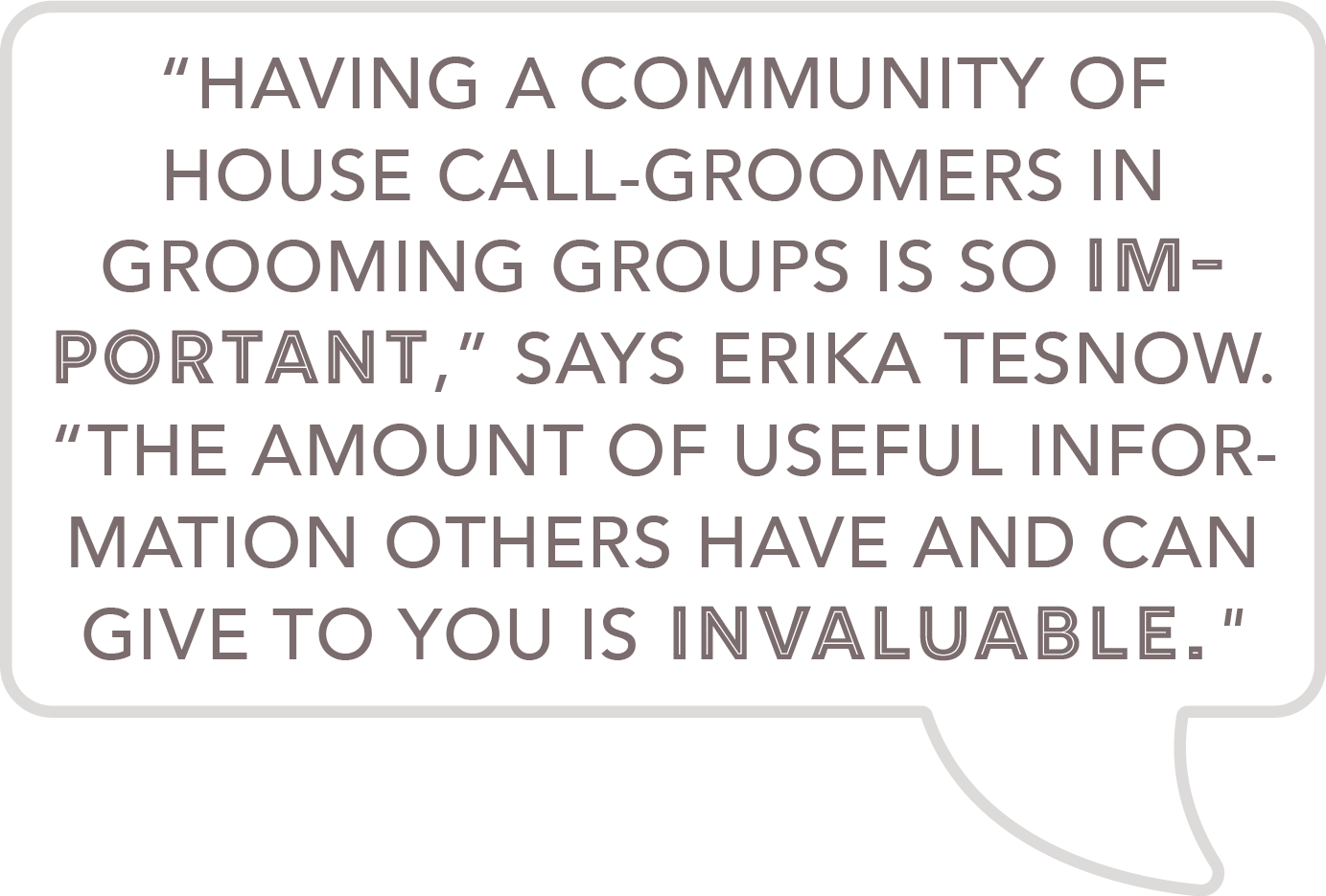
“What I enjoy most is assisting animals who are afraid to be groomed in unfamiliar environments,” shares Hannah Gibson. “I’ve had numerous dogs who can’t be groomed at commercial salons, but when I’m set up in their house, I have no problems at all. After realizing how many dogs I am really helping, and seeing how happy their owners are, I don’t think I could go any other path.”
House-call grooming—are you ready to get in on the next big thing?
by Jen Phillips April
Photos by Morgan Pereira, Untamed Hearts Photo Co.
Photos by Morgan Pereira, Untamed Hearts Photo Co.
’ve always been known for my patience, but since I’ve gone mobile, I try to focus on keeping the experience as low-stress as possible,” says McKenna Rimmer, owner of Pawsitively Elegant Dog & Cat Grooming.
“I have clients with a level five heart murmur, and I keep them safe, clean, and calm. They may have a less gorgeous haircut, but they’re happy and comfortable. That’s why ‘Pawsitive’ is in my name,” she adds.
McKenna just celebrated her second year in business on July 6, 2023. “For years, people have told me I should have my own business, but once I had a one-and-a-half-year-old and my husband started an LLC for me, I had the push I needed. It was one of the best decisions I’ve ever made.”
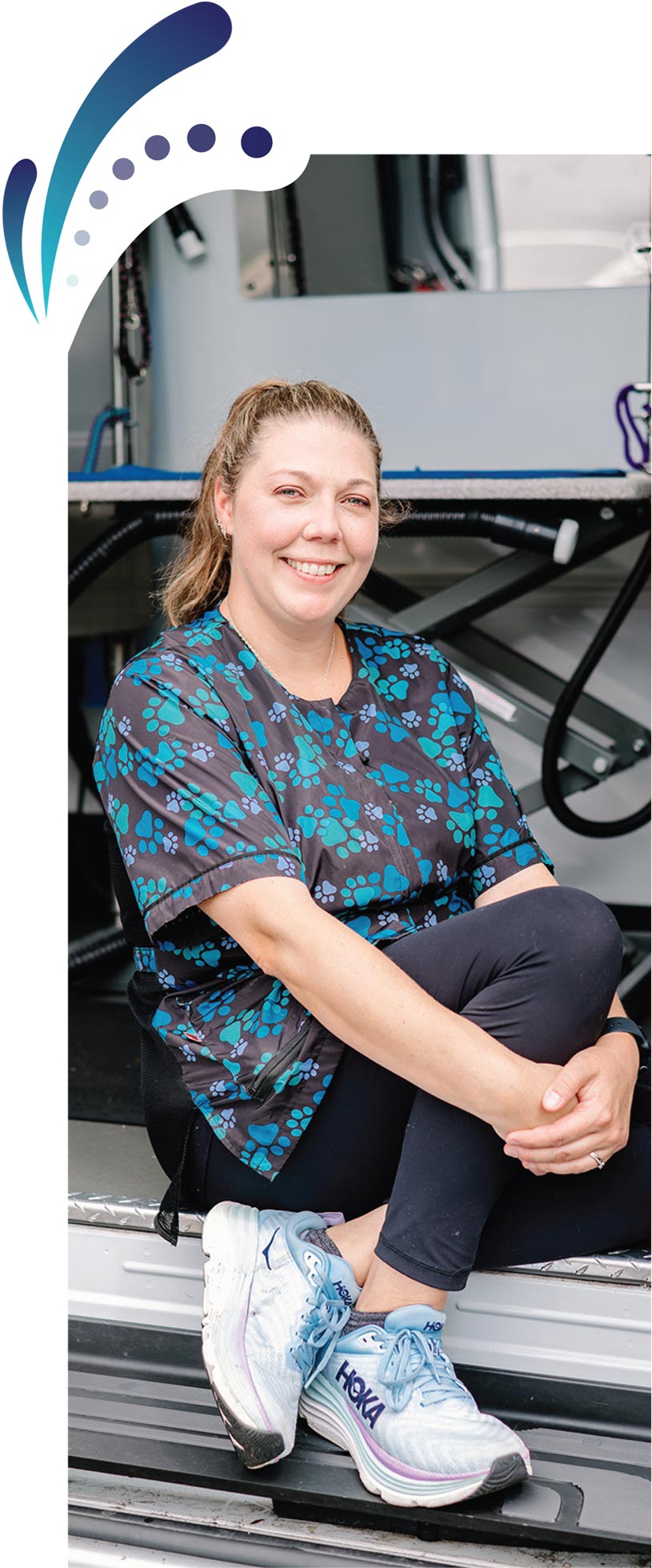
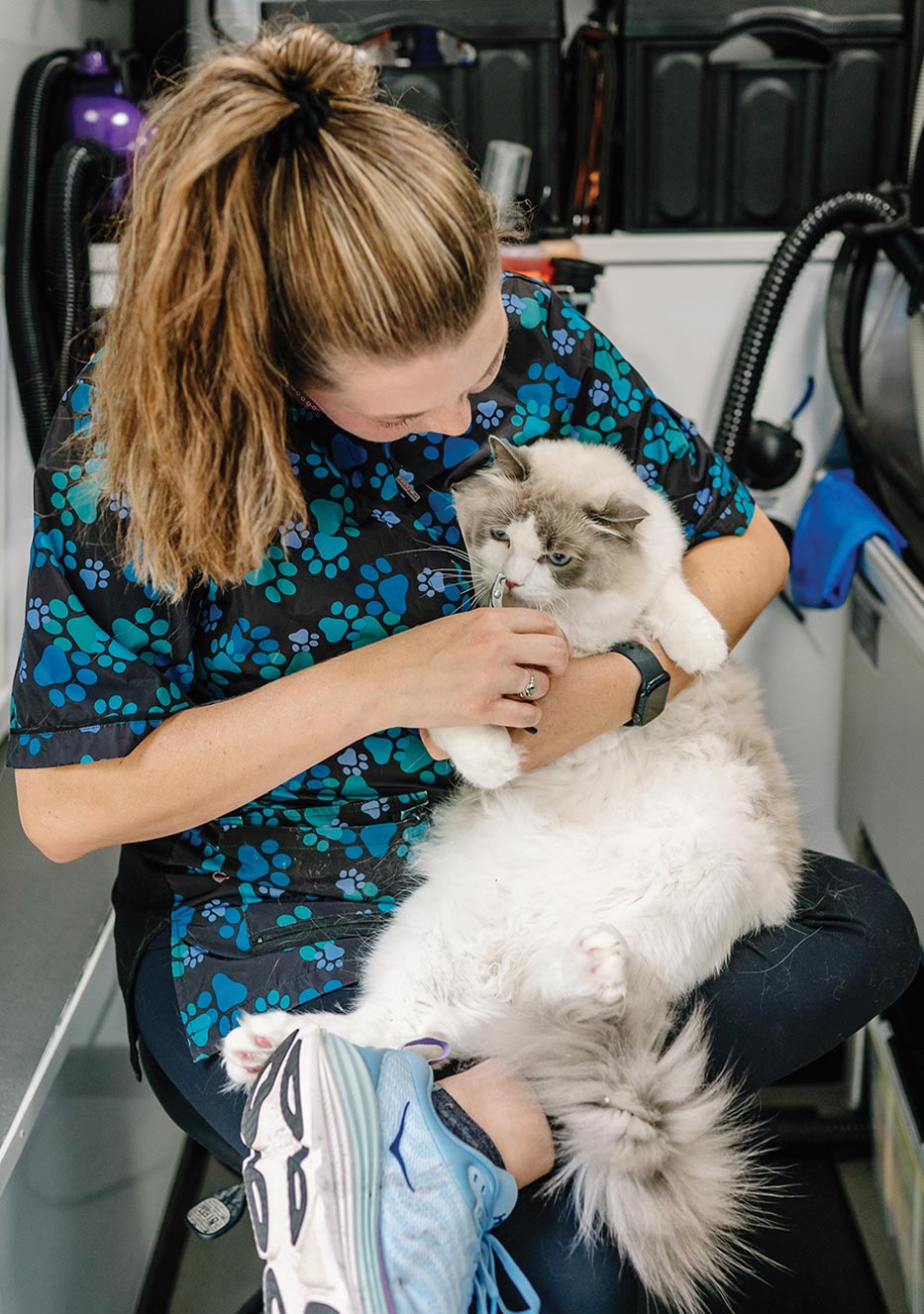
In the Spring of 2021, McKenna started shopping for mobile grooming vans. “I got in right before the pandemic-related van shortages and expenses increased. I was originally told my van would be a six-to-eight week wait, then it was pushed to a 10-12 week wait. Once I had it, I cut back to part-time at the salon where I worked to build my business on the side. I was up to full-time with my van within three months. I was lucky my boss was kind enough to be generous in that way.
McKenna’s mobile spa serves the Gainesville, Virginia area. “We’re about an hour from Washington, DC; it’s one of the last major suburban areas before Front Royal, Virginia, with plenty of shopping and golf communities. I was lucky to set myself apart right away because I do cats and hand-stripping, and I have a knack for those aging pets who may not be able to go to their previous groomer anymore,” she adds.
McKenna got her start in grooming at very young age. “I always say I grew up tableside. My mom was a groomer, and I spent my earliest years in the playpen next to the grooming table. I started as mommy’s little helper/bather from the age of nine. I’ve always been comfortable with animals.
“Later,” McKenna continues, “I went to college and considered becoming a veterinarian. I was a Biology major. Then my parents got divorced, and things were tough financially. I took a semester off and worked as a baby groomer with my mom in a veterinarian’s office. I’d bathe the dogs, and at the end of the day, I’d groom any dogs left. Then I got a job working for a Master Groomer in Tampa, and I decided if I was going to do this, I was going to do this right. I’ve always worked in the nicer salons in the nicer parts of town.”
Many long-time groomers suffer repetitive stress injuries as they get older. Additionally, because mobile pet grooming vans tend to be smaller and a one-person operation, it makes sense to limit pet size. McKenna only grooms pets under 45 pounds.

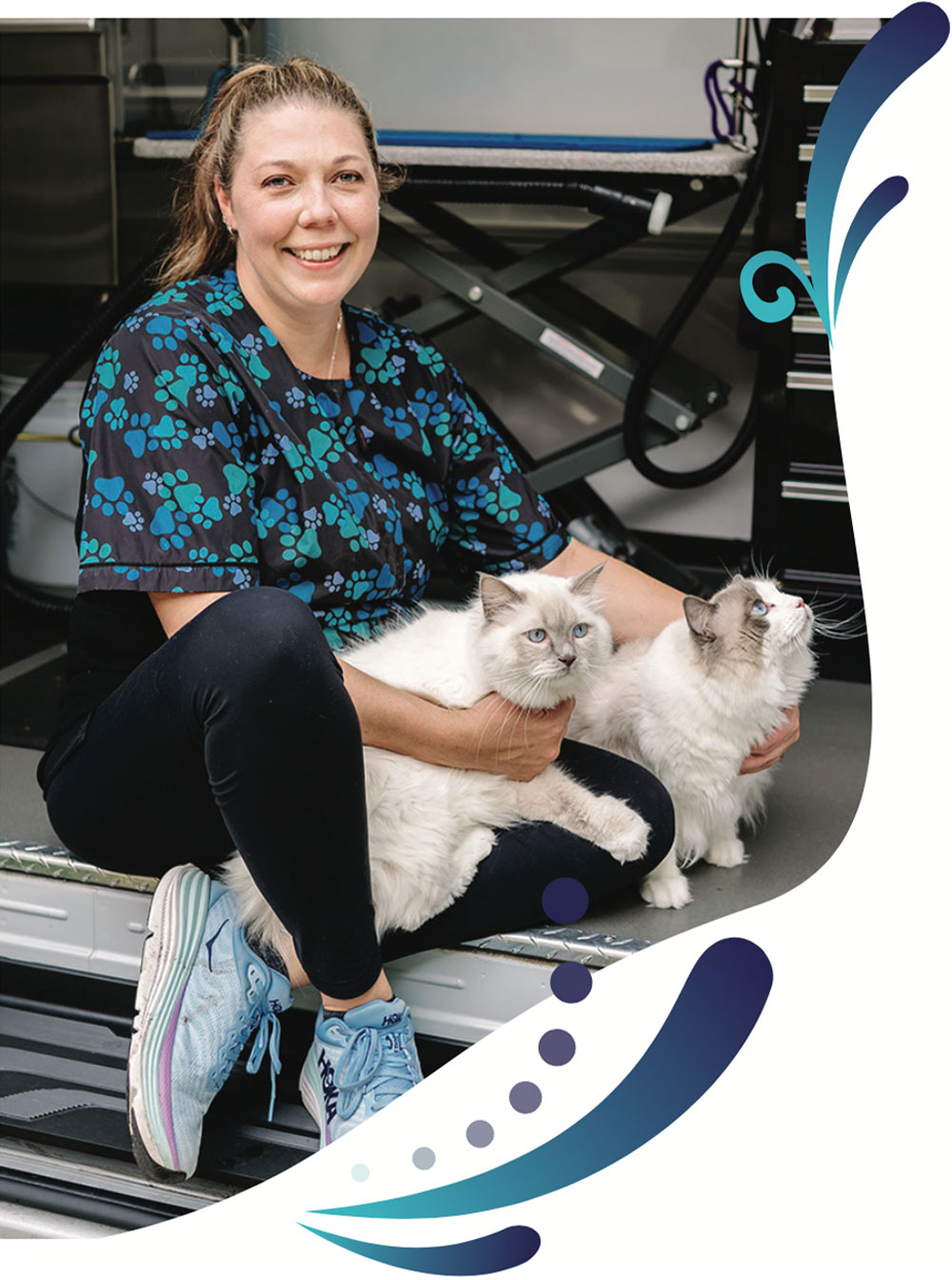
In addition to dogs, Pawsitively Elegant also caters to cats. But we all know cats are not dogs. McKenna says body contact makes a big difference for the cats she grooms.
“There aren’t that many mobile groomers who take dogs up to 45 lbs. in my area. Many of them only take 25 lbs. There’s no assistant in the van, and as the dogs get older, it can be harder for them to get in and out of the van. And the tubs and tables are a bit smaller in the van. I want to prolong my career, and I have physical limitations,” she says.
“With cats, I groom in my lap a lot or against my body somehow,” she shares. “I really have to read body language and pay attention to cues. I stay calm, and that seems to help. Some cats are nine years old, have never been groomed, and are matted. I find a big part of it is keeping them in contact with me. After the bath, I can wrap them in a towel and cradle them in my lap so I can get every cat dry, and they don’t freak out.”
McKenna usually grooms six to eight pets in an eight-hour day, which can include as many as four cats in one day.
Keeping with the customized experience theme, she uses different types of dryers according to the pet she is working with. “I have four or five different dryers in my van depending on what I need for the day, including one that’s quieter than a human dryer. I have also different tools and tricks. It really depends on the cat.”
She says she’s glad cat owners are overcoming the stigma that cats groom themselves. “If they see the bath water, they know that’s untrue. Now there’s more awareness and programs devoted towards teaching pet owners about the importance of cat grooming.”
McKenna says her favorite part of pet grooming is making a difference. “I like it when the pet is excited to see me. I like the response and surprise from the owners when their dog is happy and smells clean. I can take a pet who’s nervous, and because I’m calm, they can relax and maybe even enjoy it,” she concludes.



 s groomers, we see clients’ pets on an average of every six weeks. This schedule is the perfect time to notice something owners may miss because they see their pets daily. When interacting with a pet daily, what may be a minuscule difference in behavior will appear huge to a groomer who has not seen this pet in weeks. A behavior change can be one of the early signs of an underlying medical condition. And remember, early detection means early intervention, and early intervention can increase survival rates or decrease recovery time.
s groomers, we see clients’ pets on an average of every six weeks. This schedule is the perfect time to notice something owners may miss because they see their pets daily. When interacting with a pet daily, what may be a minuscule difference in behavior will appear huge to a groomer who has not seen this pet in weeks. A behavior change can be one of the early signs of an underlying medical condition. And remember, early detection means early intervention, and early intervention can increase survival rates or decrease recovery time.
Let’s take Brownie for example. Brownie was a sweet, lovely Shih Tzu. I could do anything to this boy. On one occasion, he was snappy. Very snappy. I called the owners to come pick him up and reschedule him. Brownie’s owners informed me that their home was burglarized the day before, and the intruders terrorized Brownie. The owners thought a change of scenery with someone he loved would be better than staying home. Brownie was suffering from PTSD. We stopped grooming and let him hang out with us while the owners cleaned up the mess at home. The following grooming, he was back to his usual self.
Brownie’s behavior change had to do with stress outside of the grooming facility. Other examples of outside stress could include events in the pet’s home such as death, divorce, medical issues, problematic children or the addition of a new pet.
An opposite example of Brownie is MacBeth. MacBeth, a Miniature Schnauzer, hated grooming. He always let me know how distasteful the entire process was…except for the day I came to groom him while all the grandchildren were visiting. Just imagine, one six-year-old girl who was dressing him up and five boys ranging in age from 7-10 running around the house, as only young boys can. MacBeth jumped in my arms, begging me to get him away and to take my time. He was in no rush to get back to those kids.
Any medical problem can cause a behavior change. Medical changes in behavior could also include incontinence and aggression. Conditions such as epilepsy, brain tumors, infections, and immune and degenerative diseases can all directly affect a dog or cat’s nervous system and, therefore, its behavior. In older pets, aging can directly affect the brain, leading to cognitive dysfunction and senility.
I loved grooming Casey. He was such a good boy for grooming. He was a large Golden Retriever and, typical of goldens, a total goofball who eagerly looked forward to my arrival, as it was another human to pet him. When he looked a little withdrawn and cautious around his legs, I told the owners that it wasn’t like Casey not to be wagging his tail the entire time he was here. The owners took Casey to the veterinarian, who started him on joint supplements, and by the next groom, he was better.



Owners don’t always make the connection between teeth in bad condition and the fact that this pet’s mouth hurts. I’ll ask the owners if they have ever had a toothache to make it relatable. After they nod their head, I ask how they would feel if they took an electric toothbrush to their painful tooth. They will generally grimace, and then I add that our clippers vibrate in the same manner as an electric toothbrush does. And that the pet in question knows it hurts and is anticipating pain, so they will want to protect themselves. I usually can see the light bulb go off over their heads, and now we can discuss what we can and cannot do.
Just because you can pinpoint a reason behind a change in behavior does not mean you have to continue this groom. It may not be safe for you or the pet, for that matter. Knowing when to stop a groom is in everyone’s best interest.
It is imperative to pay attention to subtle changes in the behavior of the pets we groom. The owners I mentioned in this article noticed no changes in any of their pets. And the longer a health issue goes undiagnosed, the less likely there is to be a full recovery.
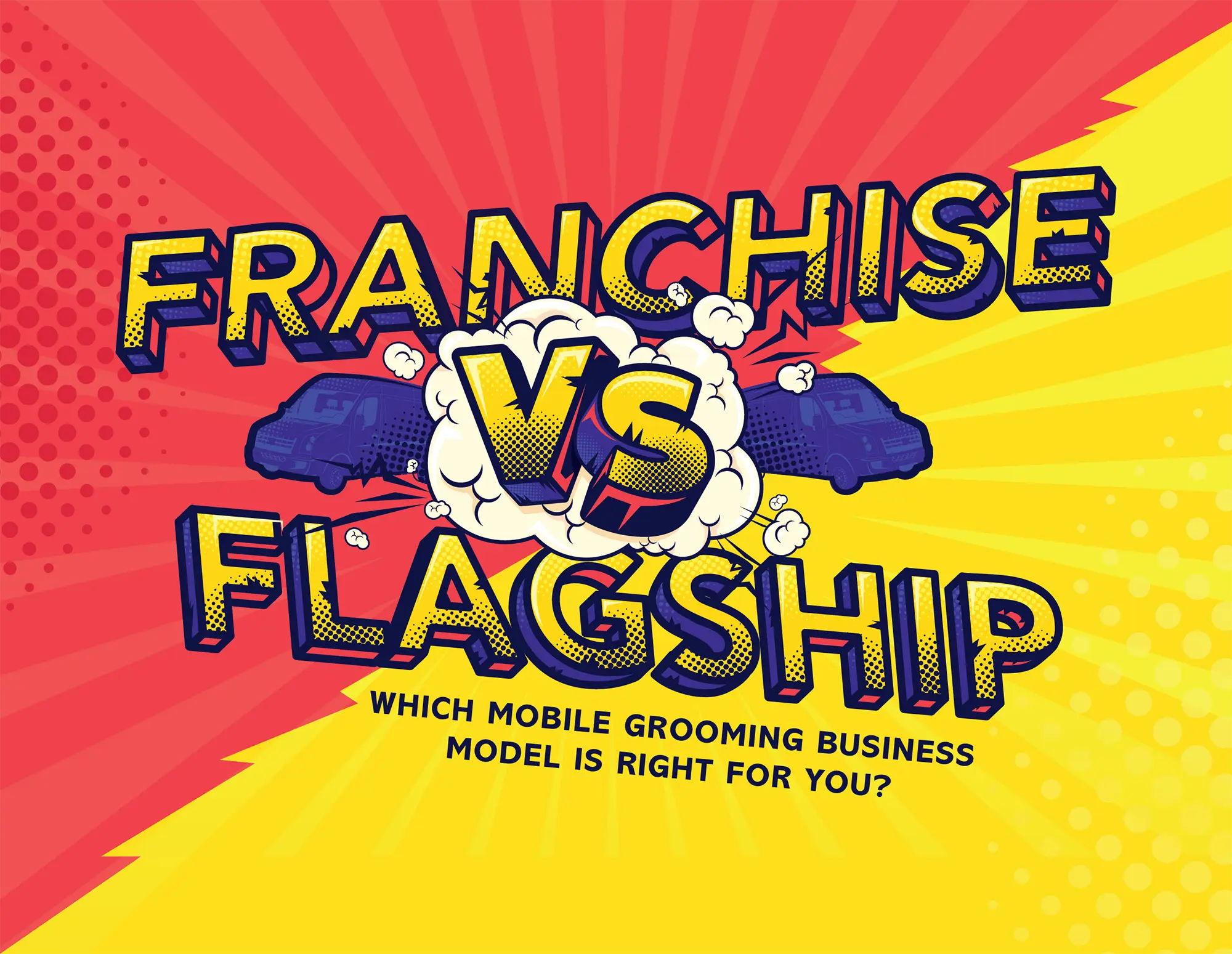
 ow more than ever, pet care professionals have seen increased demand for elevated and personalized pet care. To no surprise, this goes beyond exceptionally pampering pets during visits. Gone are the days of cookie-cutter pet care; understanding breed-specific differences now lays a foundation for providing proper treatment. With this newfound demand for personalized care comes opportunities for pet care professionals to enter new communities and reach new clientele.
ow more than ever, pet care professionals have seen increased demand for elevated and personalized pet care. To no surprise, this goes beyond exceptionally pampering pets during visits. Gone are the days of cookie-cutter pet care; understanding breed-specific differences now lays a foundation for providing proper treatment. With this newfound demand for personalized care comes opportunities for pet care professionals to enter new communities and reach new clientele.
Mobile grooming has become increasingly popular in recent years. The boom can be credited to the COVID-19 pandemic, as it was one of the ways pet care services were able to operate under lockdown restrictions. Credited as essential in many states, one-to-one grooming proved lucrative for many in 2020 as operations went uninterrupted. Since then, this has given mobile business owners peace of mind and has contributed to the growing popularity of the business model.
For those just beginning their mobile grooming journey, the decision to buy a franchise or invest in your own mobile van is not one to make lightly. There are various factors to consider, including personal goals, preferences, finances and risk tolerance. Both options have their advantages and disadvantages, and what might be a better choice for one groomer may not necessarily be the right fit for another.
Franchises are tried-and-tested business models. Unlike mom-and-pop shops, they have existing practices in place franchisees can benefit from. Franchises often provide the best tools to ensure their franchisees’ success, including elevated training sessions, networking opportunities, established marketing tactics, up-to-date equipment and supplies, advanced technology, safety protocols for the groomer and pets in their care, proper insurance and ongoing support.
Additionally, franchising leverages the buying power of a larger franchise system, which helps reduce expenses for franchisees who may be unable to secure preferred pricing on their own. All these factors can prove beneficial for groomers new to pet care, business ownership or franchising in general.
In working with an established brand, a groomer may also have lower risk when it comes to investing. A proven concept and business system offer reduced risk compared to starting an independent business from scratch. As part of a franchise, groomers can learn how to hire the right people and grow both the business and team with proper guidance. Franchises also have a cohesive strategy to scale and manage their businesses. Once a common goal and vision are established, eventually franchisees have the option to take a backseat in the business and can be set up for long-term success.

In many cases, starting a mobile grooming business can be more cost effective compared to buying a franchise, which typically involves higher upfront fees and ongoing royalties. Mobile grooming vans allow lower initial investments, ideal for groomers just starting out in the industry. Unlike franchises, independent groomers are also not tied down to franchise-wide offerings or promotions.
While there are many benefits for groomers to own their own mobile vans, there are a few challenges to keep in mind. Working independently typically does not allow businesses to scale as quickly or cost-effectively compared to franchising. When starting a business from scratch, the groomer is solely responsible for everything involving the business, which can be intimidating. This includes, but is not limited to, finances, insurance, payroll, scheduling and van maintenance. That is why it is common for startups to go through a much slower process of setting up and receiving profit than franchises.
When working independently, there is also a lack of company culture. Grooming is a physically demanding job as it is, so being the only person to run an entire company can be tiresome.
Being on wheels can also help increase brand awareness at key community spots, including dog parks. A groomer’s ability to have a presence at an event can create additional revenue opportunities. For groomers owning and operating mobile businesses, vans should be thought of as traveling billboards. Treating company vehicles as a form of advertising acts as a strategic business approach, helping to increase brand visibility and potentially attract new customers.
When operating any business, customer service is a key factor in determining success. Independent businesses require top-notch customer service, as the owner becomes the face of the entire company. Being in a van allows for direct, one-on-one customer interactions, which can lead to stronger customer relationships and loyalty.
Mobile grooming also offers unparalleled convenience for pet owners. For clients constantly on the go, mobile grooming services can help lessen the burden by eliminating the need for pet owners to wait around at appointments, pick up and drop off their pets. Mobile groomers offer services at their clients’ doorsteps, saving them time and effort.
It is important to consider how factors such as initial investment costs, ongoing fees, support and training, the level of independence, and financial risks will impact the business decision. It is also a good idea to talk to current franchise owners and mobile grooming van operators to gain insights into their experiences and challenges.
Amy Addington has been President of Woofie’s since January 2022, and was a Co-Founder and Co-Chief Executive Officer from Woofie’s inception until then. She has been the Co-Founder and Co-Chief Executive Officer of Woofie’s, LLC, which merged into Woofie’s Ashburn, LLC in January 2022, since its inception in March 2004. She was also the Co-Founder and Co-Chief Executive Officer of Woofie’s Mobile Pet Spa Services, LLC, a position held from its inception in January 2017.


 n the surface, giving a dog or cat a bath might seem relatively straightforward—get the pet wet, apply shampoo, rub shampoo around a little and rinse. But professional pet groomers know that there is so much more to it than that. The foundation of a good groom is built on how clean the pet is when it comes time to trim and style it. And getting dogs and cats clean is a more involved process than the steps outlined above.
n the surface, giving a dog or cat a bath might seem relatively straightforward—get the pet wet, apply shampoo, rub shampoo around a little and rinse. But professional pet groomers know that there is so much more to it than that. The foundation of a good groom is built on how clean the pet is when it comes time to trim and style it. And getting dogs and cats clean is a more involved process than the steps outlined above.
First, a good groomer must know which shampoo to choose for each pet. For instance, the chubby Yorkshire Terrier with lank, oily fur needs a degreasing shampoo to ensure its coat will be clean and flowing, with each strand of hair separated and not clumping limply on its body. And that little beige Westie would probably benefit from a whitening shampoo to restore its proper color. But beyond choosing which carefully designed product to use on which animal, we also need to select a method of utilizing those products.

This method of bathing was time-consuming, challenging and sometimes ineffective. In addition, it invited groomers to waste both water and expensive shampoo. Another problem was that if too much shampoo or conditioner was diluted and left unused overnight or over a weekend, bacteria (most commonly Pseudomonas aeruginosa) could grow in the bottles, potentially causing skin problems in pets when it was used later.
Thankfully, professional pet bathing systems were developed. There are currently three basic types of bathing systems available to groomers: recirculating systems, siphon systems and freshwater pressurized systems.

There is a misconception among some groomers about this type of system. They believe pets cannot get clean because they are being washed in “dirty” water. However, this is untrue, as fresh water is used on every animal. This cleaning method can be compared to washing clothes in a washing machine or dishes in a dishwasher. The cleaning product and water work together to clean pets, clothes and dishes similarly. It must work, or we’d be walking around in grimy clothes and eating from dirty dishes. This type of system works well for people who do not have good water pressure. And it conserves both water and products.


Because siphon systems use the force of water from the tap to operate, it is best used in places with good water flow. For example, if your faucet can fill a gallon container with water in under 12 seconds, this type of system could work well for you.

Some of the benefits of professional bathing systems include:
- They eliminate the need for scrubbing, making the bathing process more ergonomically friendly. (Hands, wrists, arms and shoulders get a break!)
- There is no need to pre-wet the pet.
- Groomers can clean heavily soiled areas without getting their hands dirty.
- Dogs and cats both seem to enjoy the massaging action of the water as it pulsates on their skin.
- Getting pets clean takes dramatically less time, reducing labor costs and leaving more time for styling pets.
- Water usage is reduced.
- Less product is needed per pet, which is a saving that visibly adds up.
Perhaps best of all is that bathing system technology produces superiorly clean pets. As one of my regular customers quips, “My dog hasn’t been bathed until he’s been bathed by a professional.” But, of course, this professional relies on her bathing system.


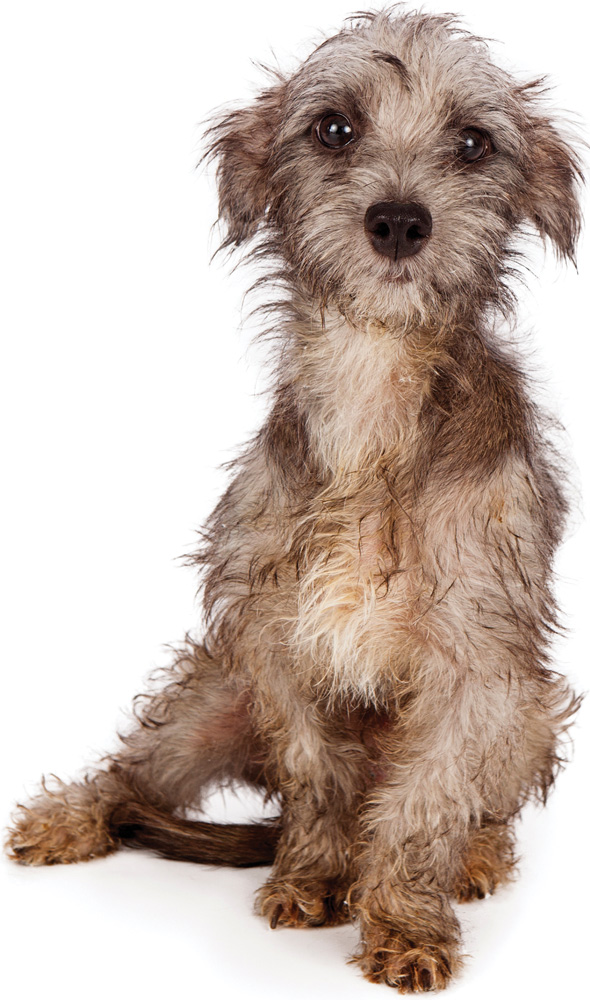
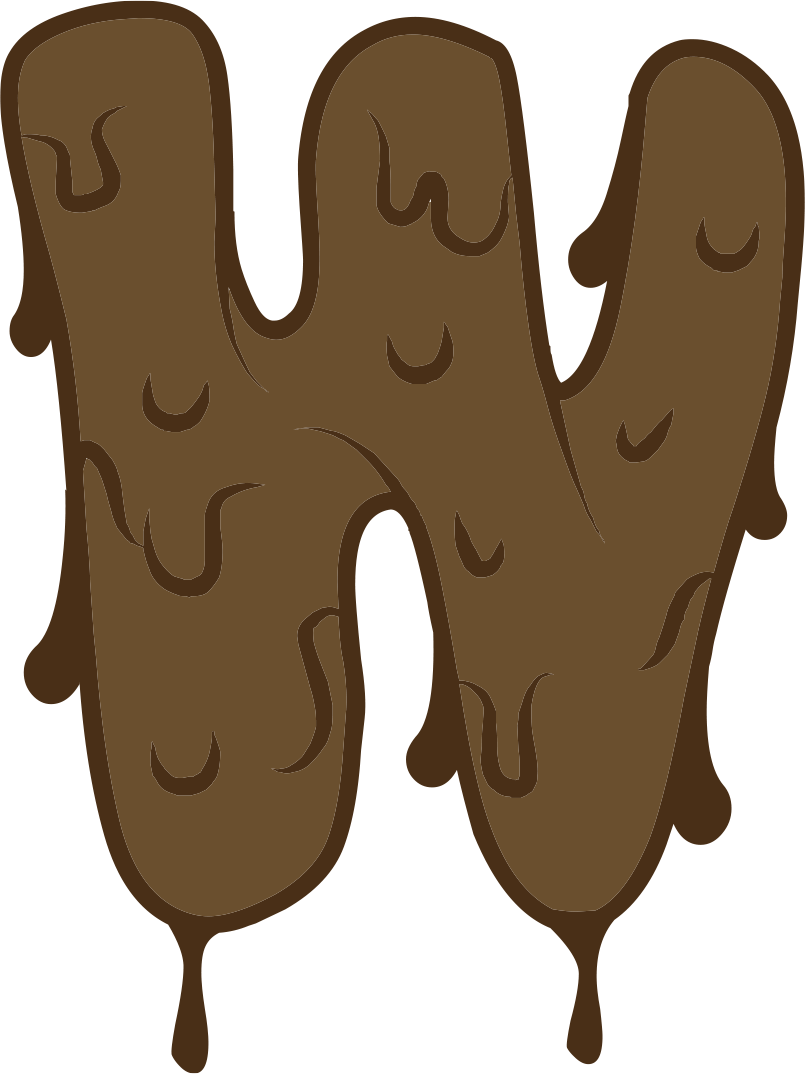 e are often presented with pets that are greasy or appear wet, like they are sweaty. Why does that occur and what do we do to fix it? The basic answer as to why it happens is simple: overactive glands. The tricky question is, why are they overactive?
e are often presented with pets that are greasy or appear wet, like they are sweaty. Why does that occur and what do we do to fix it? The basic answer as to why it happens is simple: overactive glands. The tricky question is, why are they overactive?
Some of these animals are born with over-active glands that would lead us to believe there may be a genetic (passed on by parents) or congenital (occurred in the womb) factor involved. If true, these individuals could face a lifelong maintenance-type issue, including frequent baths with the proper technique and products to minimize or control the secretion. More commonly, though, we see individuals that develop the condition later in life, which can be associated with multiple conditions, but usually follows a common theme: inflammation of the glands.

Some conditions that will cause the inflammation include harsh products, degreasing, lack of conditioning, metabolic disease (like thyroid disease, Cushing’s, Addison’s, diabetes, liver or kidney disease) and environmental issues. Checking bloodwork on these pets is always a good starting point, especially if the pet is over seven years of age or the problem is recurring. If the problem is coming from an internal source, it will be tough to control it without addressing the internal source.
Producing excess fluids/oils is the body’s way of dealing with irritation, making defining the source of irritation an essential aspect of dealing with the issue to avoid constant reoccurrence. It is similar to the eyes producing mucous when dried out or infected. Considering the body is trying to compensate for this irritation explains why “degreasing” a pet is contraindicated, as it dries and irritates the skin, sending the body into shock by removing its protection. The body will then produce more fluids/oils to alleviate the additional dryness. Unfortunately, degreasing remains the most common approach to this issue.

In some of these cases, allergies may be the root cause. If that is the case, being proactive before allergy season and using this technique before things progress can be very helpful, if not prevent the issue altogether. Low-grade fungal or bacterial issues are also a common source, so using the close-open-close technique and including antibacterial and antifungal shampoos can help. This is especially true in hot and humid climates that tend to produce a lot of yeast-type infections.
Cats are famous for this problem because we typically rely on cats to groom themselves at least part of the time. Once cats get a little dry or irritated and matted, they often stop grooming, and the oils/grease will become problematic. This often leads to shave-downs and ongoing issues if not correctly handled.
Understanding the issue and choosing your products wisely is crucial to your success in dealing with these pets. Using an emollient (especially in the second close) on greasy pets is adding to the issue, not solving the problem. If you already have extra grease or oils, it doesn’t help to add more grease or oils. The coat must be conditioned to break the cycle. Therefore, it is imperative that you use a humectant-type conditioner that will hydrate, which will soothe the skin. Remember, the source of irritation on many of these pets is dry skin or hair.
If you were taught that degreasing is the answer to this issue, then it may be time to rethink this and try new approaches to work for resolution versus just helping the problem in the short term. Happy skin is healthy skin. Unhappy skin produces more skin debris.

Photo by Animal Photography
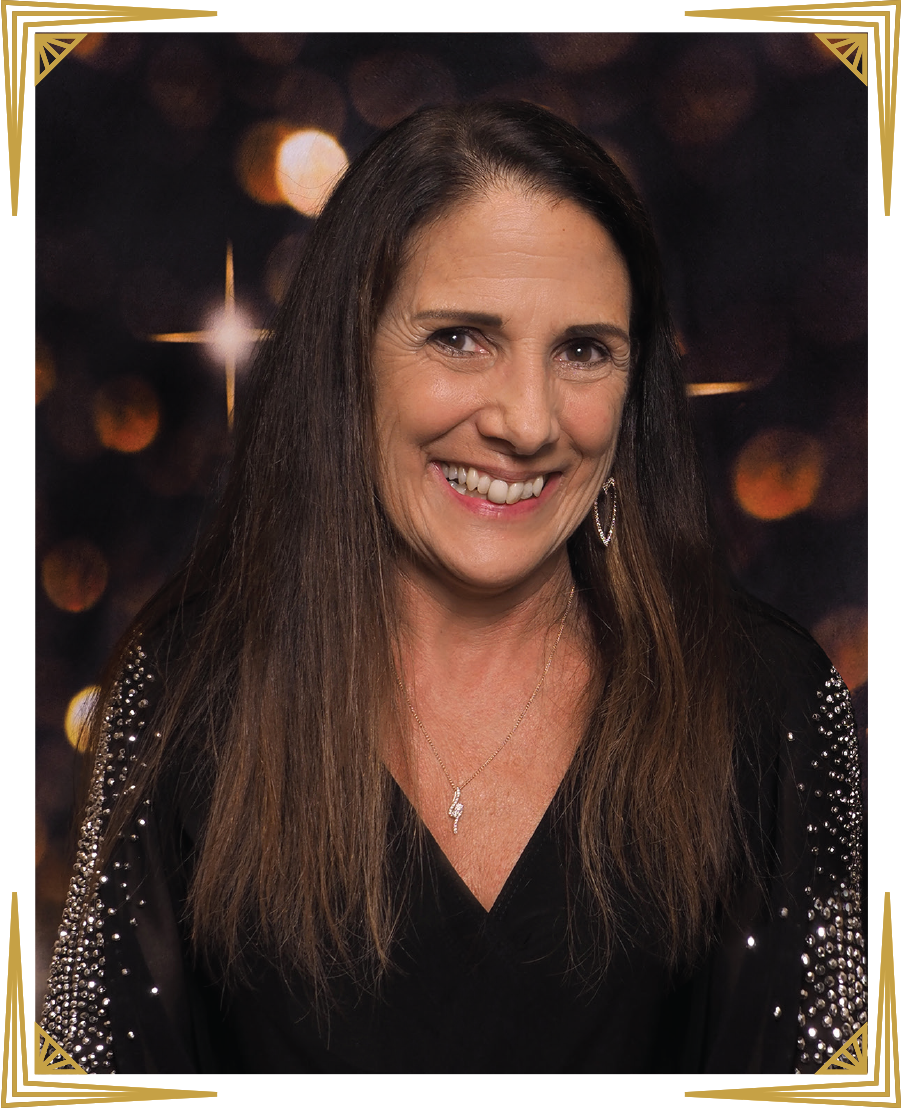
 ue Zecco has become one of the most recognizable names in the pet grooming industry. Her legacy in the world of dogs stretches around the globe and her accomplishments are nothing short of amazing. Her impressive career began as a competitor on GroomTeam USA, including representing her country at the world competition in Europe, and eventually came full circle to being a judge at that very event. Proving herself as a strong businesswoman, Sue has owned and operated the largest pet grooming salon in Massachusetts since 1977, and her “Super Styling Sessions” educational video series with Jay Scruggs boasts one of the largest educational video libraries available. Sue took some time from her busy schedule to chat with me so I could share her incredible journey.
ue Zecco has become one of the most recognizable names in the pet grooming industry. Her legacy in the world of dogs stretches around the globe and her accomplishments are nothing short of amazing. Her impressive career began as a competitor on GroomTeam USA, including representing her country at the world competition in Europe, and eventually came full circle to being a judge at that very event. Proving herself as a strong businesswoman, Sue has owned and operated the largest pet grooming salon in Massachusetts since 1977, and her “Super Styling Sessions” educational video series with Jay Scruggs boasts one of the largest educational video libraries available. Sue took some time from her busy schedule to chat with me so I could share her incredible journey.
Jonathan: Hi Sue, thanks for chatting with me. Let’s talk about where it all started. Where did your journey in the pet grooming industry begin?
Sue: My journey in the pet grooming industry began when I was in high school working in a local boarding kennel. The man who owned the kennel needed help and threw a clipper in my hand and a dog on my table with absolutely no training. I was scared to death, but I got it done. So I guess my grooming career actually started in 1975. In 1977, I opened my own salon, The Pampered Pet, and shortly after that I went to my first professional grooming show. That show was run by the Massachusetts Association of Professional Dog Groomers which later changed to the New England Pet Grooming Professionals. I instantly became hooked on learning from all the seminars I went to. Then I tried the grooming contest and got second place in a large class of beginners. It was pretty awesome.

Sue: Being on GroomTeam USA was truly a huge thrill for me. I’m a competitive person and I would like to consider myself a perfectionist as well, so going to competitions and getting critiques helped me so much. I would say in the first year of competing, my grooming improved 110%. I have so many wonderful memories of the years that I competed on GroomTeam, but my favorite memory that means the most to me was winning Intergroom’s “International Groomer of the Year” in 1998. Winning Intergroom was something I dreamed about every year. My mom used to say, “If you can see it in your dreams, it can come true!” I seriously used to have my Intergroom dream every year about a week before the show. After competing there for several years and never placing in the Poodle class, that year, not only did I place first, but I also won “Best American Groomer,” “World Champion Poodle Groomer” and “International Groomer of the Year!” But the very best part about this win was that my mom and my sister drove four hours to watch me compete and were there when I won. I distinctly remember the feeling when they called my name and I saw the look of pride on my mom’s face. She passed away two weeks after that show. Winning that day will always be my very special win, because of her.
Jonathan: Wow, that’s such an amazing memory! So you’re a successful salon owner and a global speaker, judge and educator. What fuels your continued success in this industry?


Jonathan: And that’s why you’ve won multiple congeniality awards! Speaking of awards, you’ve received many awards individually, as well as for your collaborative educational videos with Jay Scruggs. What does being recognized for your success mean to you, and is there one award that stands out the most?
Sue: I think every person has the need to feel validated in what they do. Being a dog groomer is not just a job for me, it’s my career. I put my heart and soul into what I do because I love the animals. I love what I have received from this industry, and to be recognized in any way is truly a huge honor for me. One award that I never expected to receive was given to me in Barcelona, Spain by the Arteros, a “Lifetime Achievement” award. I felt very blessed and honored to receive that. That was awesome validation! I have to say, every award I’ve received truly means a lot, but winning “Judge of the Year” is a special one because I feel it’s a very important job. I really do my best to be knowledgeable, honest and fair. It’s a tough job, but I’m always happy to give critiques because those are the steppingstones that make groomers better and better every time they compete.
Jonathan: So, judging is clearly a passion for you, but you also have a well-known passion for Standard Poodles. How did you get into the breed and what is it that captured your heart?
Sue: Don’t even get me going on my Poodles because I just go on and on! When I was a kid, I never in a million years thought I would own a Poodle. But, then along came my grooming career and my competition career, and the need to have a Poodle to practice on. I never dreamed they were the most wonderful breed in the world! Poodles give me so much love, joy, pride and happiness. I think it’s because they’re everything I could possibly want in a dog. They’re intelligent, funny, elegant, protective and totally devoted. I could not live without this breed in my life.
Jonathan: Your love for animals doesn’t end with dogs, you have a mini farm at home made up of your animal and human family. Tell me about life when you put the scissors down.
Sue: I grew up in the city of Worcester, Massachusetts, and always wanted to live in the country on a farm. Shortly after my husband, Ray, and I got married, we bought a piece of land in the country. On that piece of land, we eventually built the house of our dreams—a beautiful log home—and a barn for my beautiful Quarter Horse, Ahyoka. My sister and her husband live on one side of me, and on the other side are my son, his wife and my two grandchildren, Emily and Anthony, who are truly my greatest joy. There is nothing on earth like spending time with them. We call our little piece of heaven the “Zecco Compound.” I have dreams of a lot more animals whenever I get around to retiring. I would love goats, alpacas, a dairy cow and maybe even some chickens. Someday I believe it will happen; like my mother used to tell me, “If you can see it in your dreams, it can come true.”

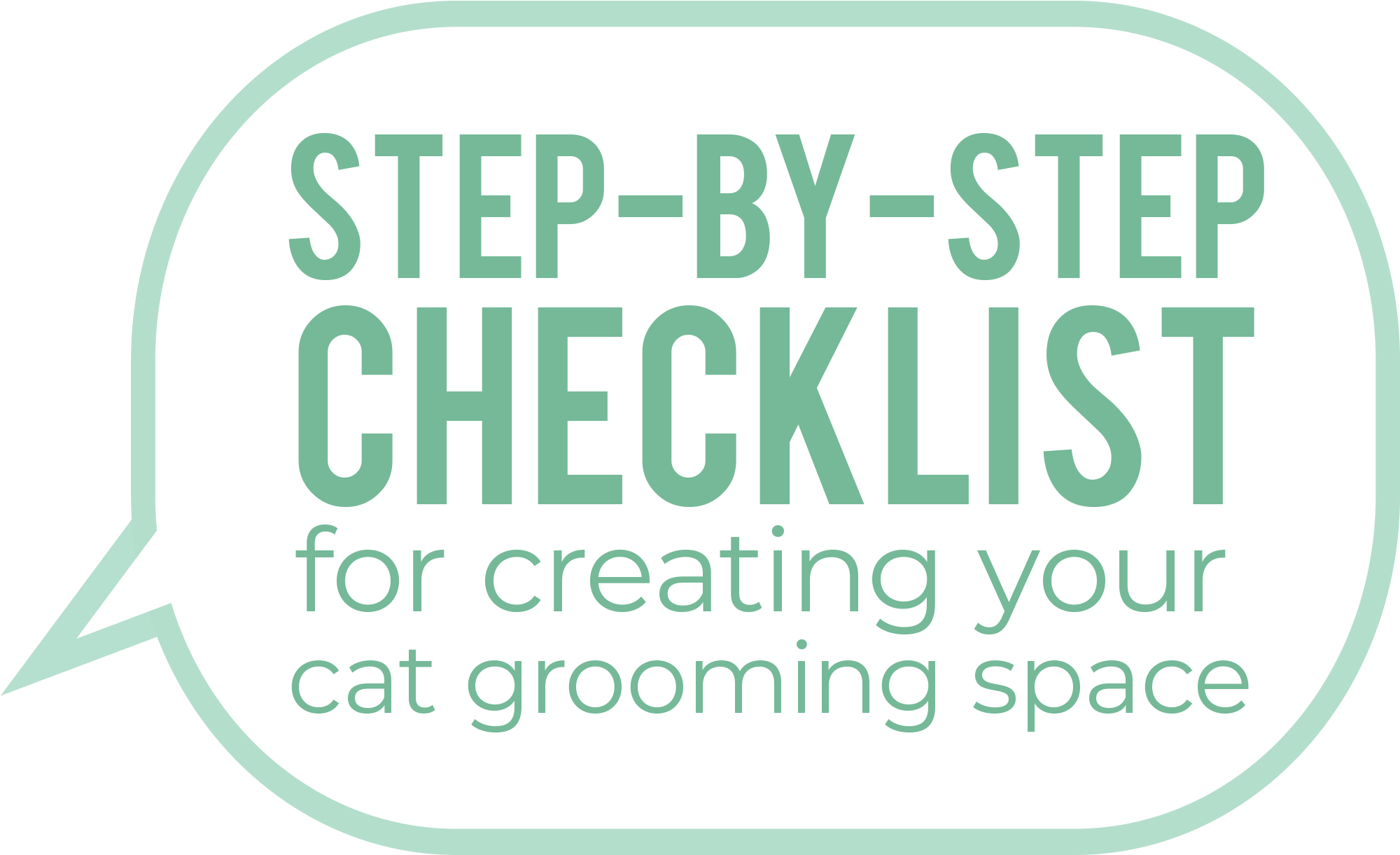

mbarking on the journey of opening a new cat grooming business or adding cats to an existing grooming business can be exciting, but also a daunting task! As the demand for professional cat grooming services continues to soar, creating a space that is safe, efficient and pleasant to work in is essential for both cats and groomers. This comprehensive guide outlines the must-have necessities for starting your very own cat grooming business, setting you on the path to not only meet but exceed the grooming needs of your feline clientele.
- Grooming table or surface with smooth top
I prefer a fixed-height table with a smooth or stainless steel top, positioned in a corner in order to prevent cats from jumping off the table away from me. - Two sets of clippers and chargers
Invest in one primary set of clippers, but plan to purchase a second set to use as backup or for heavy-duty clipper work. - Several sets of #10 blades (or 5-in-1 if using that style clipper)
- Comb attachments for your style of clippers
- Combs for body and detail work
- Nail trimmers
- Styptic powder
Use only for quicked nails. Cornstarch can also be used in a pinch. - Organizer for nail caps, applicator tips and glue (if offering this service)
- Elizabethan collar and/or muzzle as appropriate
I keep any handling tools, towels, restraints or gloves within arm’s reach from my grooming station so that they can be grabbed quickly for protection. I typically start with no additional equipment or only an e-collar unless the cat has demonstrated any aggressive behaviors.
- Grooming tub with grate and/or mat
I like to have my cats in a smaller tub, slightly elevated from the bottom with a mat on top for their comfort. - Degreasing or deep-cleansing shampoo for excess oiliness
- Clarifying/regular cleansing shampoo
- Face wash
- Hypoallergenic shampoo (for cats with any known allergies or sensitivities)
- Ear cleaner
- Washcloths and/or microfiber cloths
- Eye cleaner
- Towels
- Cat carriers
In order to prevent tripping over carriers on the floor, have a space dedicated for storing carriers to stay out of the way. This is especially important if multiple cats are arriving at the same time or if the next appointment arrives before the previous has picked up. Small carriers can easily fit into open cube storage, and small and medium-sized carriers can fit into shelving, but large or oddly shaped carriers will need floor space out of the way. - Puppy pads
Small disposable puppy pads or litter box replacement pads can be used in the bottom of cat carriers in case of any potty accidents while the cats are waiting for pick-up or while driving home. - Cleaning and disinfecting products
Cat-safe cleaning, deodorizing and disinfecting products should be kept at each station, while extras are stored in a closed cabinet or closet. Many professional products are highly concentrated and need to be diluted into spray bottles or other containers for use. - Paper towels, cleaning cloths and trash bags
- Vacuum, dust pan and brush
- Basic tools like screwdrivers, scissors, tape, zip ties, etc.
- Tools and parts for servicing equipment like your dryers, clippers, etc.
- Extra batteries, chargers and extension cords
- First Aid kit and supplies (for pets and people)
- Computer, tablet and/or appointment book
- Phone
- Notepad and pens
- Business cards, appointment reminder cards, information hand-outs, brochures, etc.
Once all the basics are covered, any additional décor, storage and backup items can be incorporated into the space to make it fit your branding and overall vision. A well-equipped grooming area, a comfortable and hygienic bathing and drying space, and a welcoming client check-in area will not only enhance your efficiency but also leave a lasting impression on your kitty clients and their human companions.
By adhering to this comprehensive checklist, you are well on your way to creating a haven of feline care where your expertise and passion for cats will shine, making your grooming business the go-to destination for all things cat!

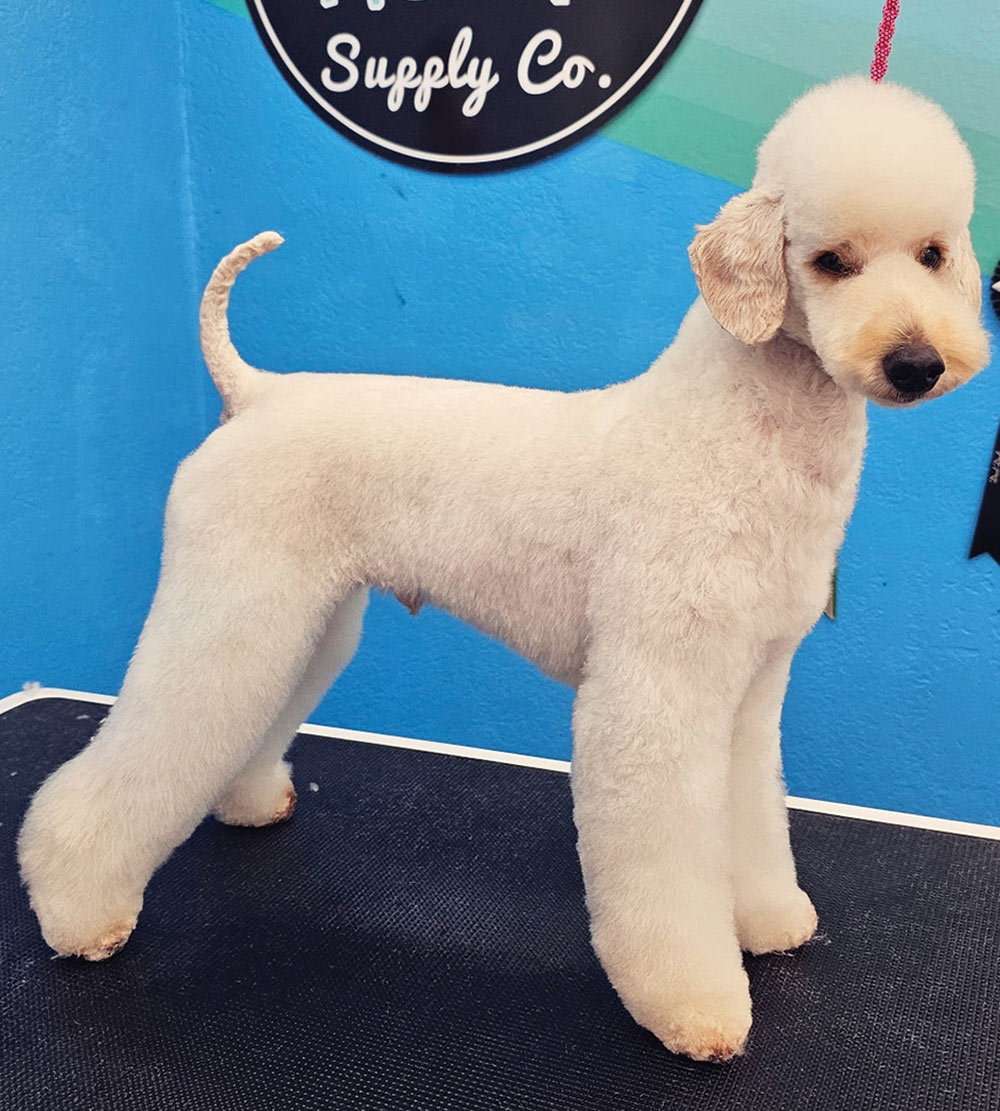

 ometimes the season changes, a dog goes viral, or maybe the owner’s partner has a request. The point is, sometimes a dog must have their entire look transformed, which means no following someone else’s pattern, or even having the comfort of following your own pattern. Instead, you have to see through the hair and know what stays and what goes. Here, I’m taking a Poodlington into a short ear and tail Teddy Bear trim.
ometimes the season changes, a dog goes viral, or maybe the owner’s partner has a request. The point is, sometimes a dog must have their entire look transformed, which means no following someone else’s pattern, or even having the comfort of following your own pattern. Instead, you have to see through the hair and know what stays and what goes. Here, I’m taking a Poodlington into a short ear and tail Teddy Bear trim.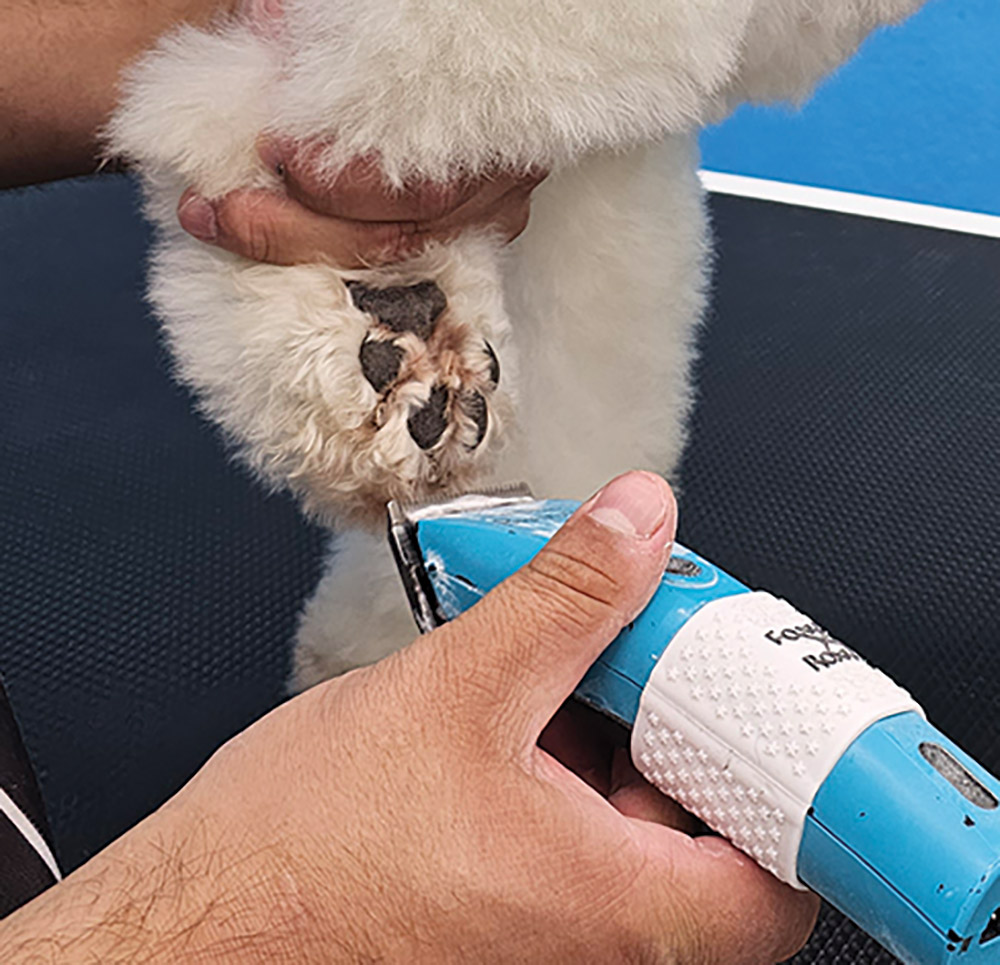

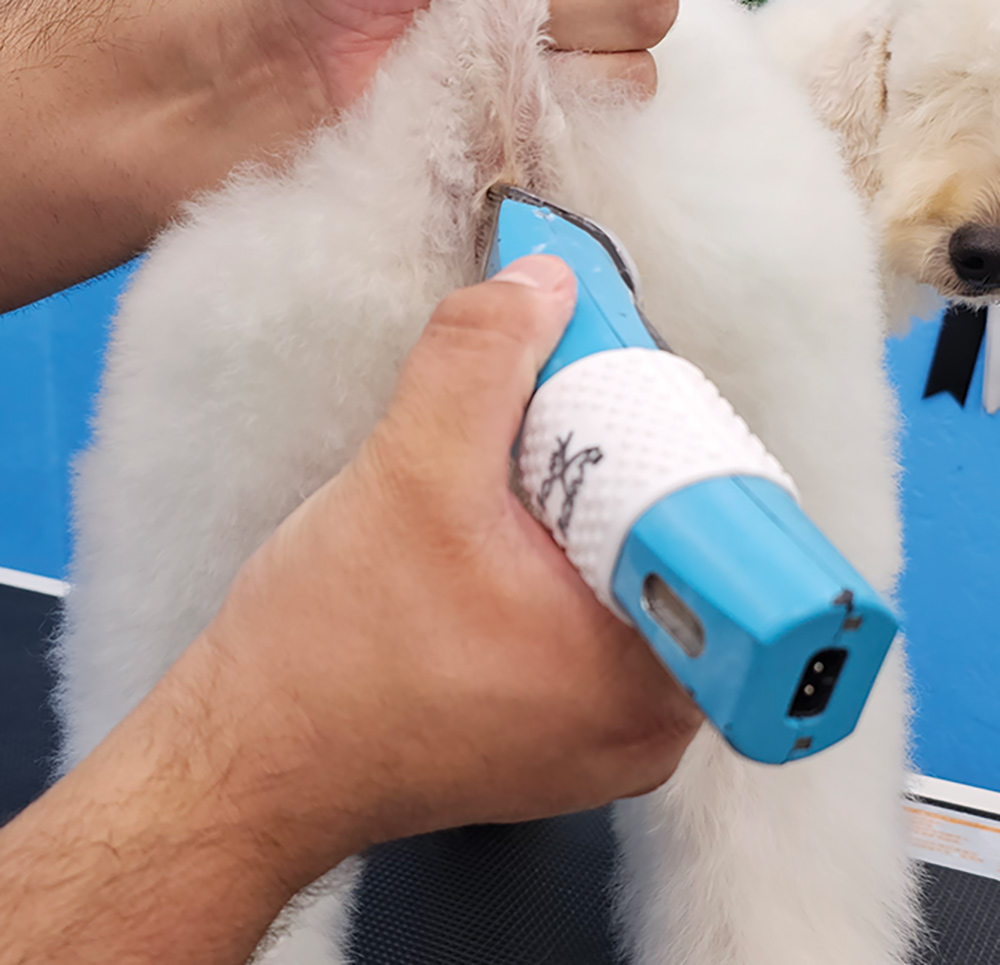
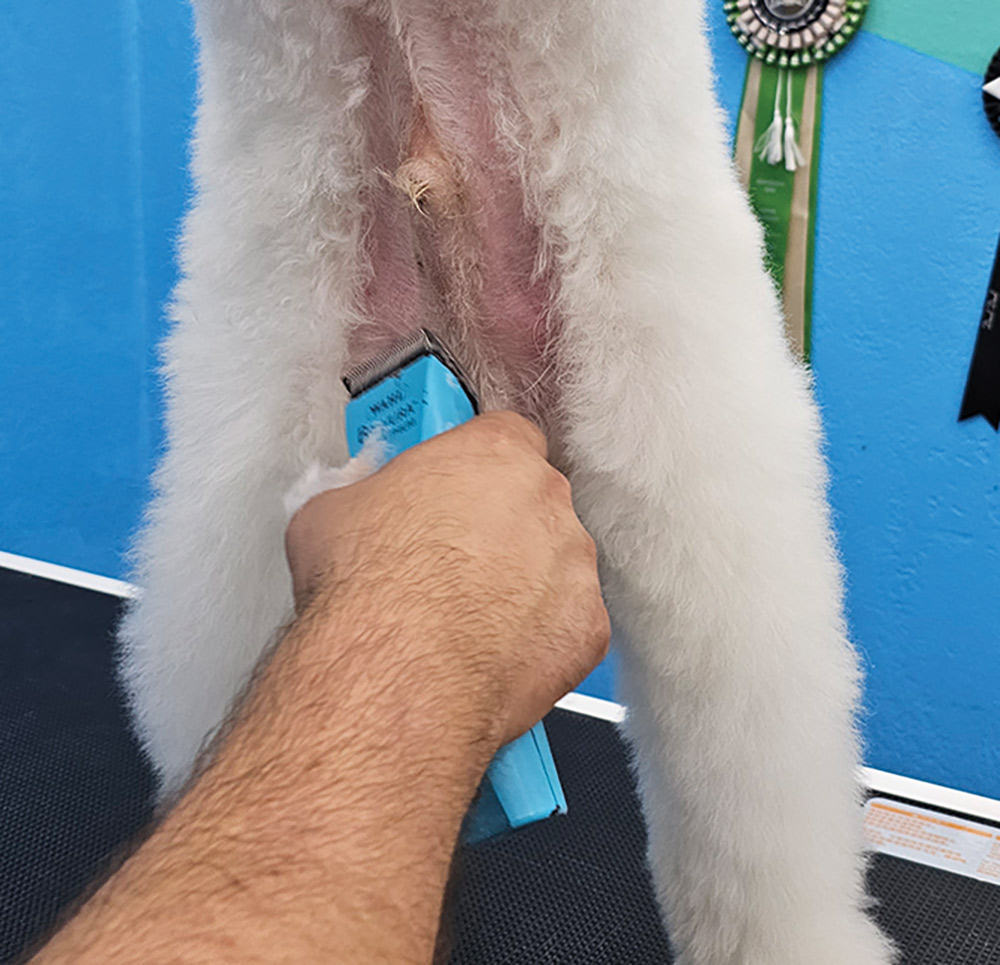
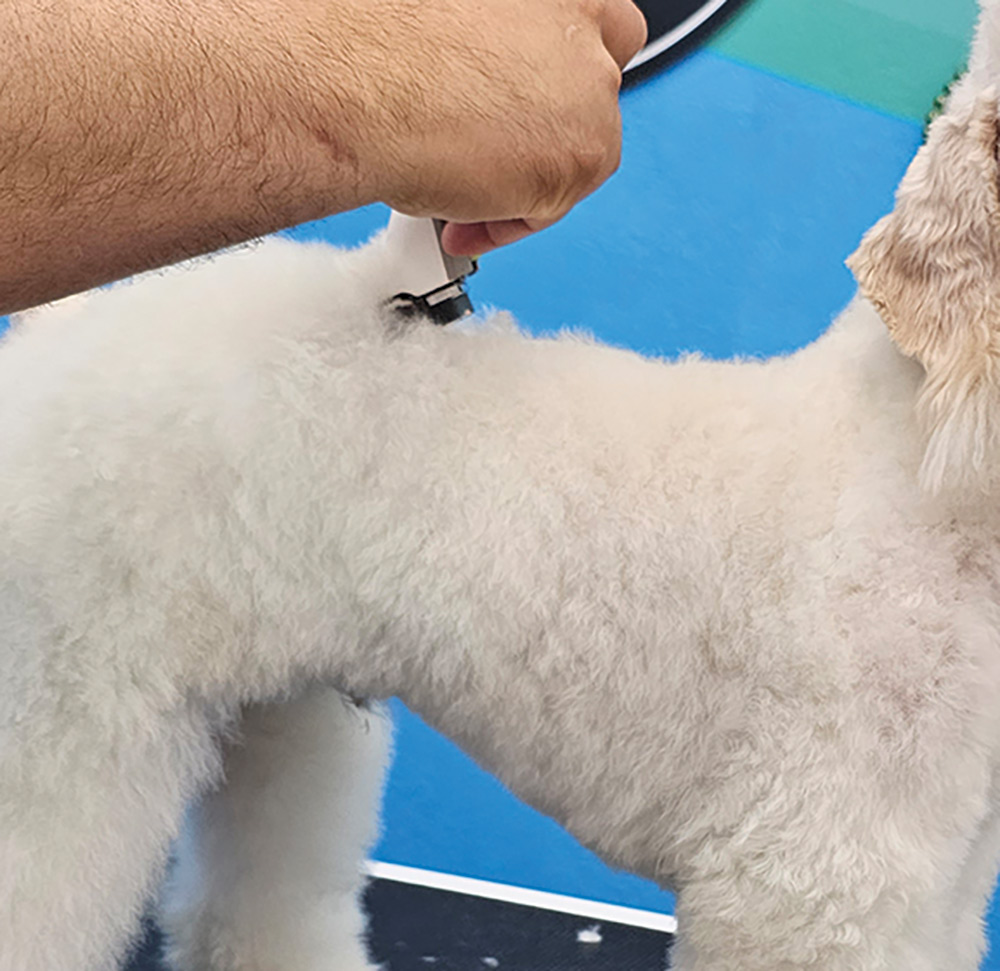
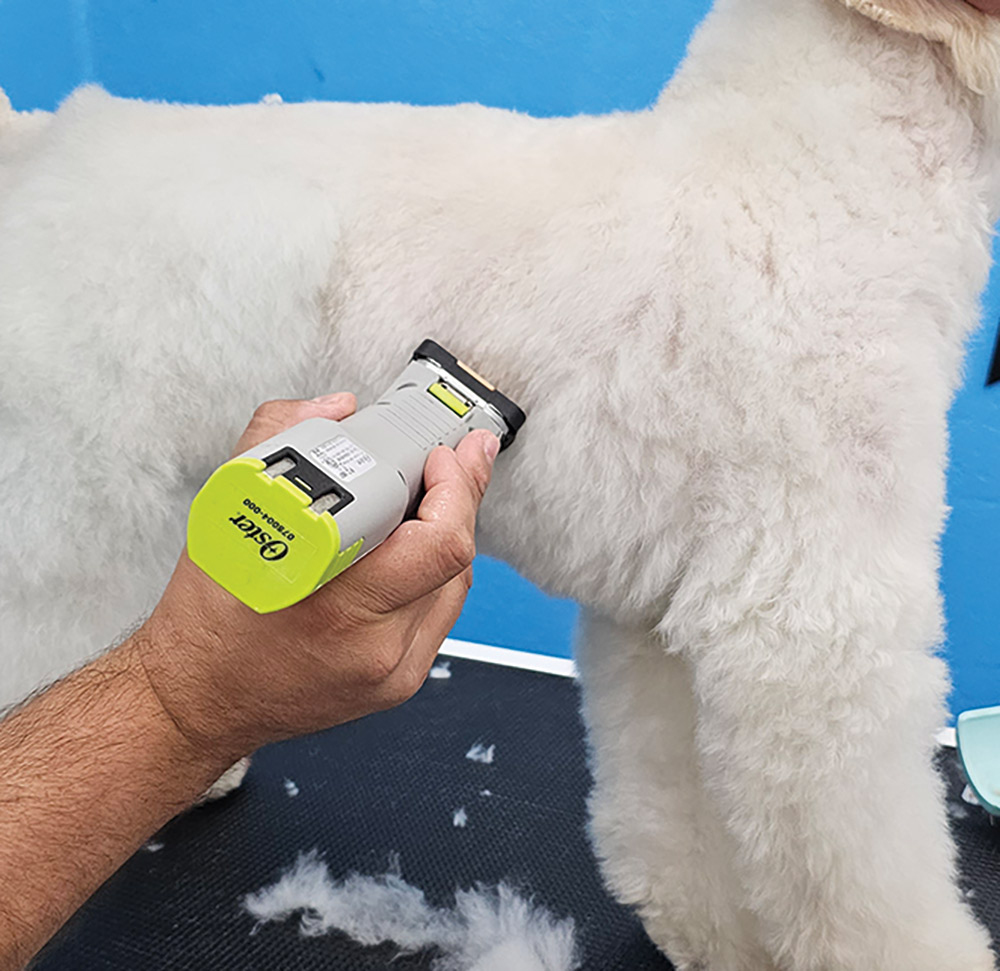
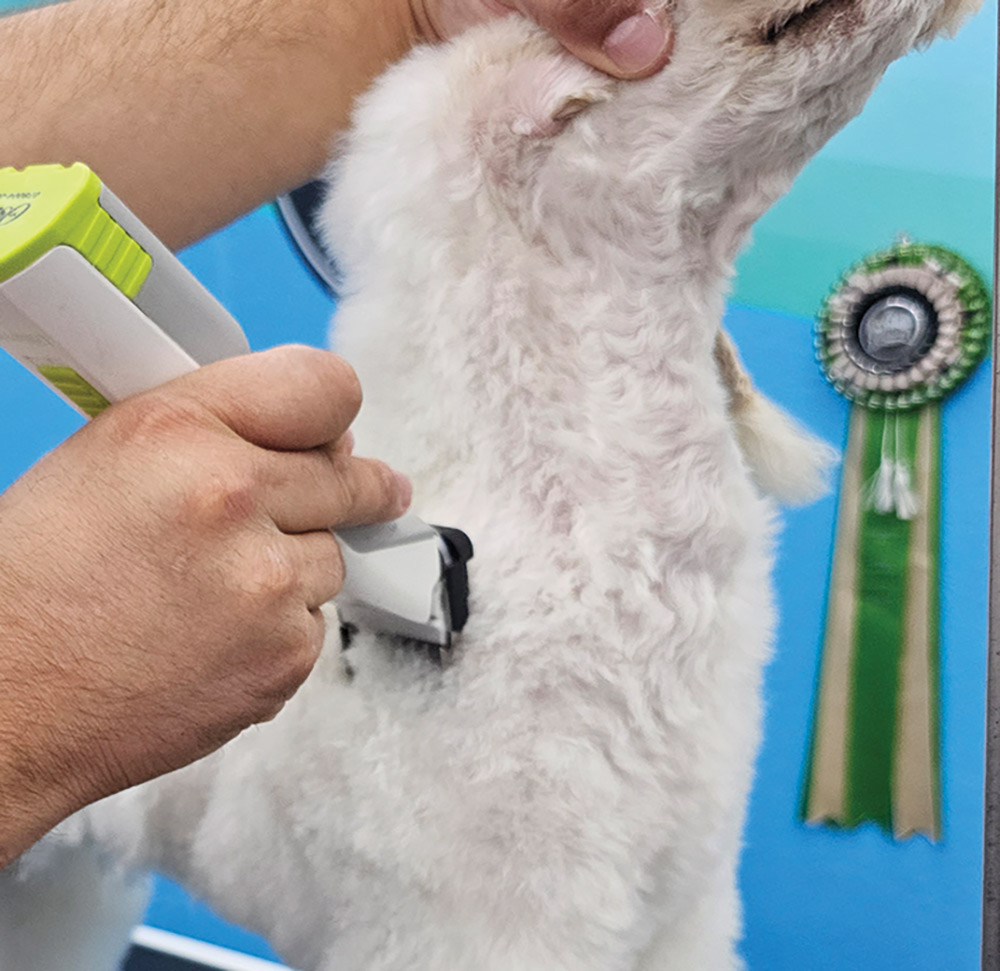
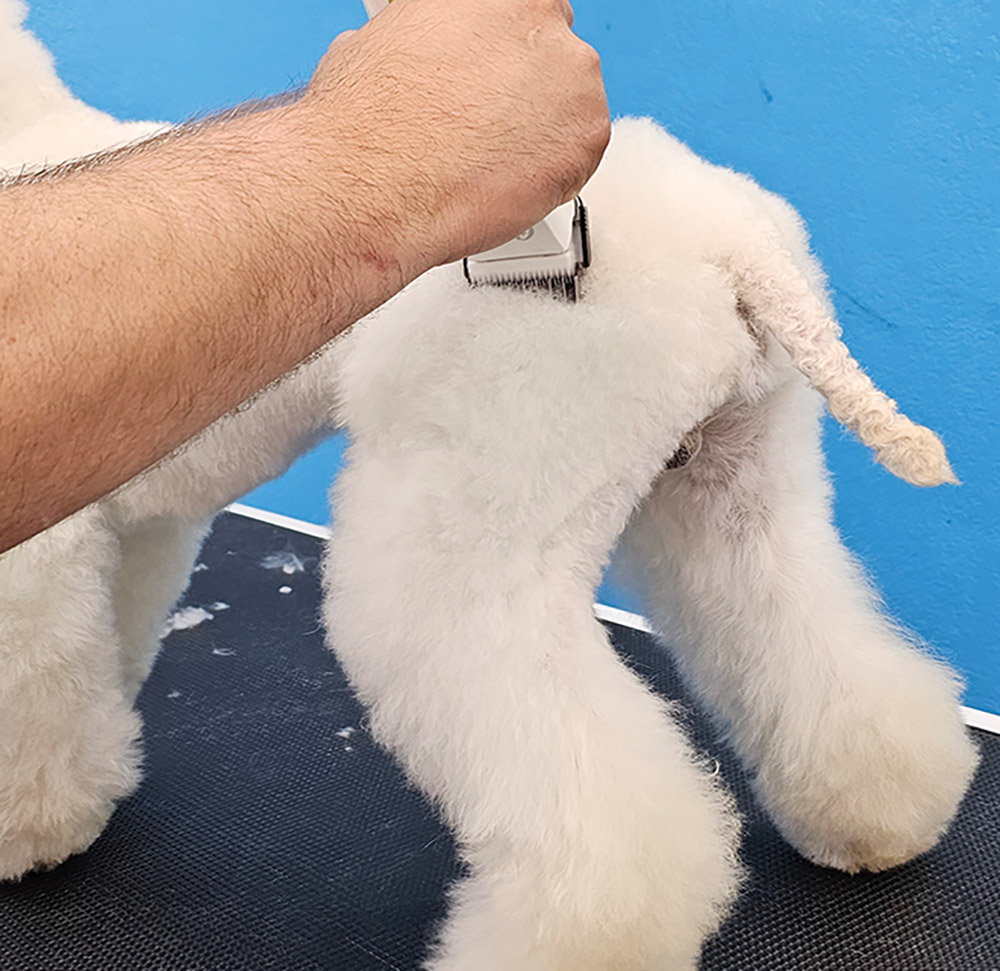
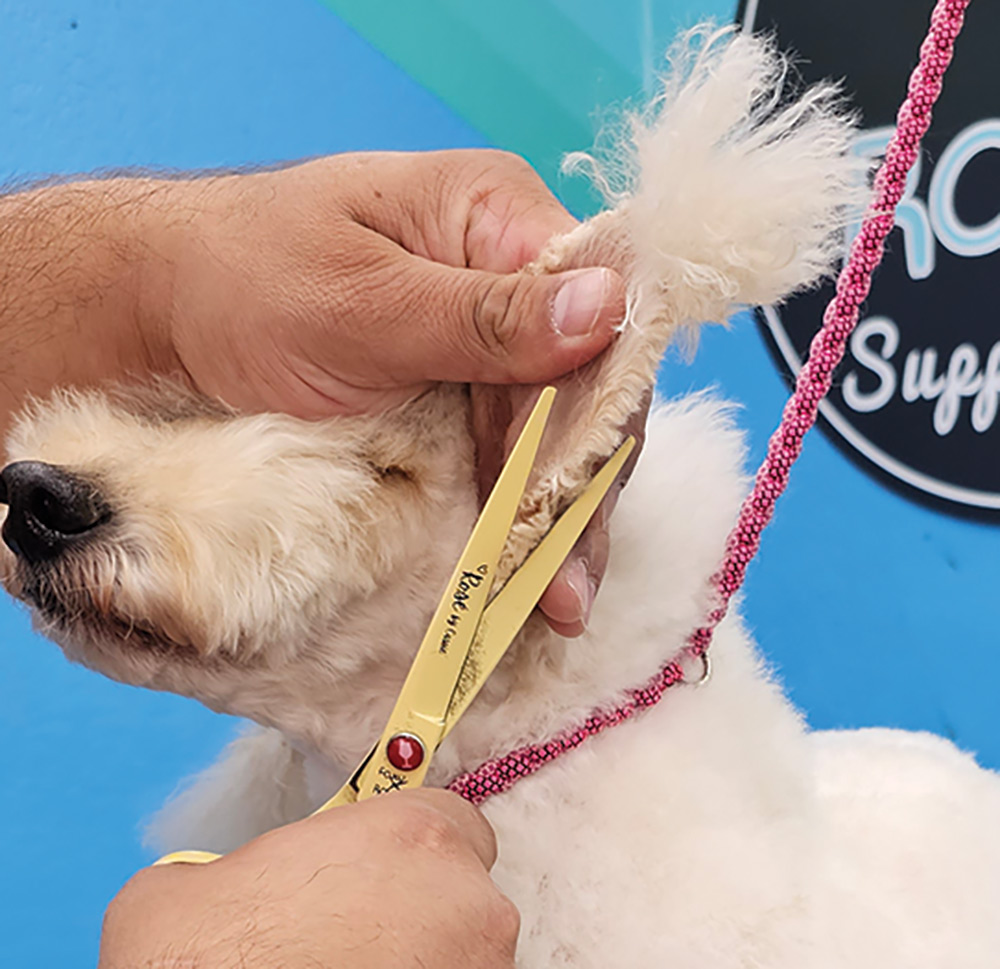

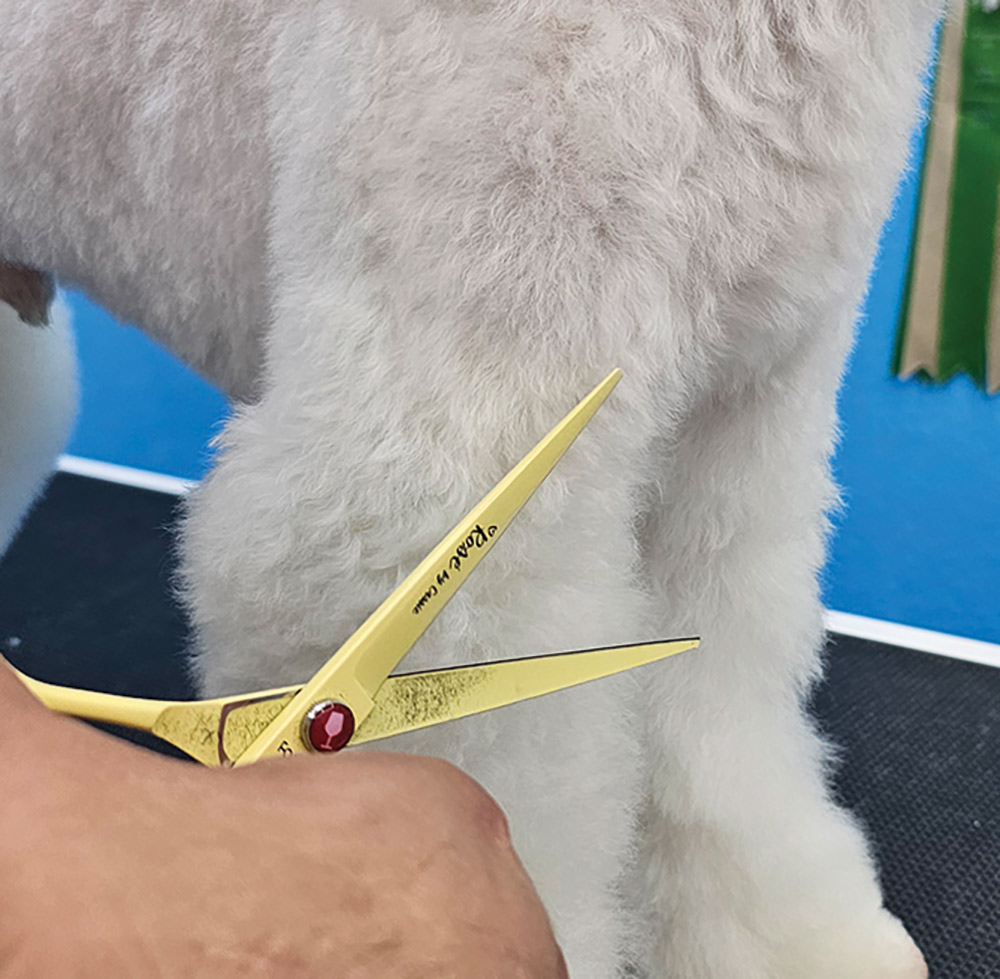
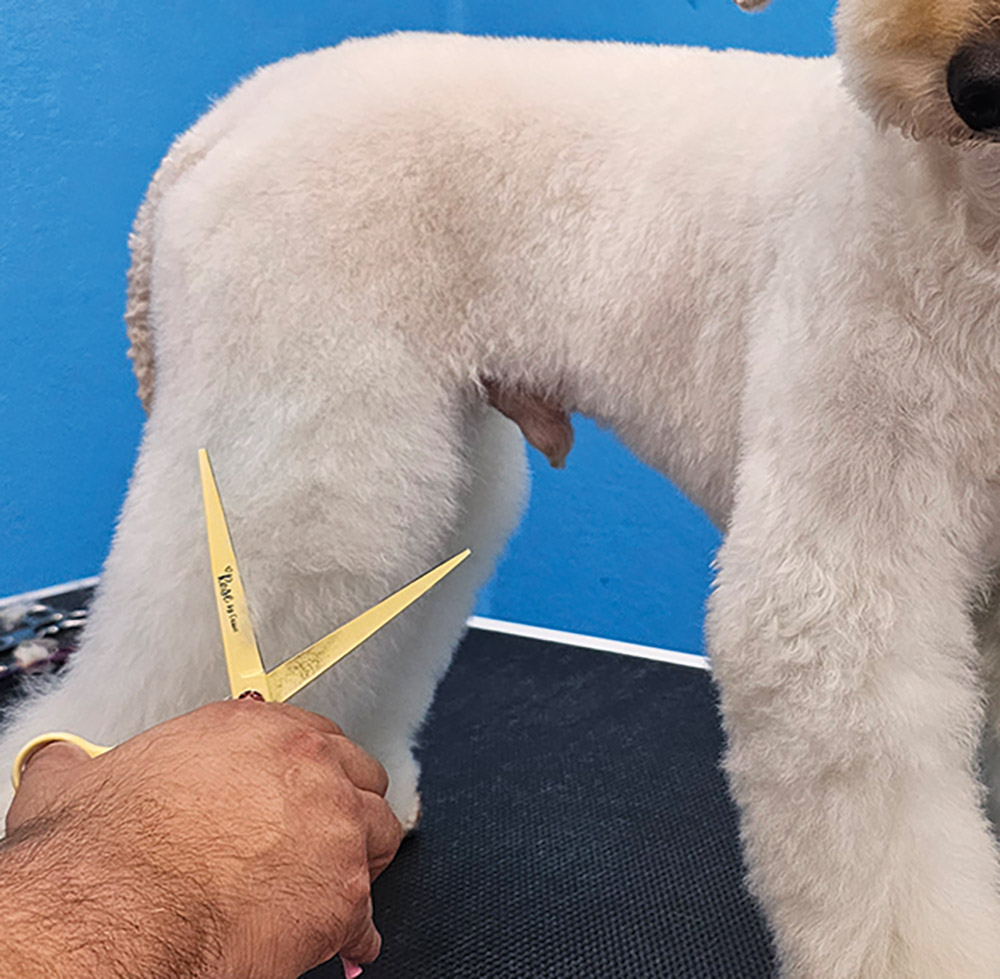

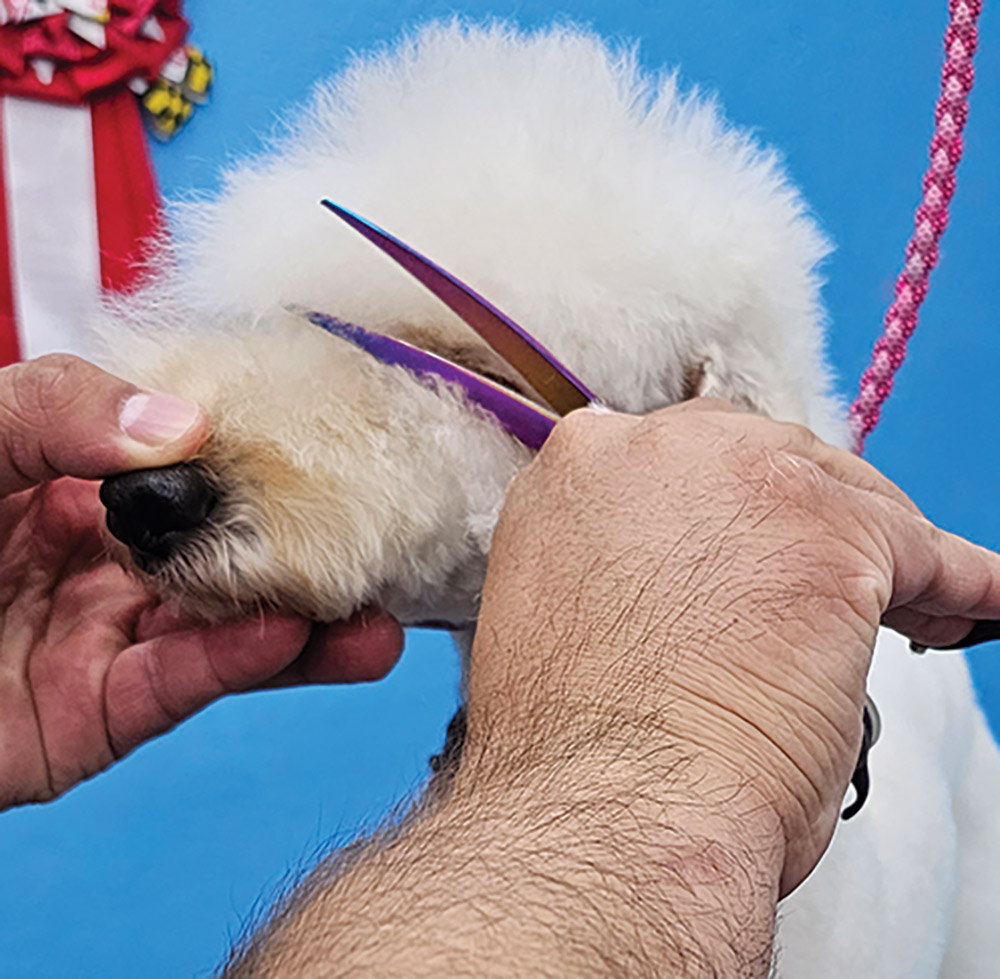
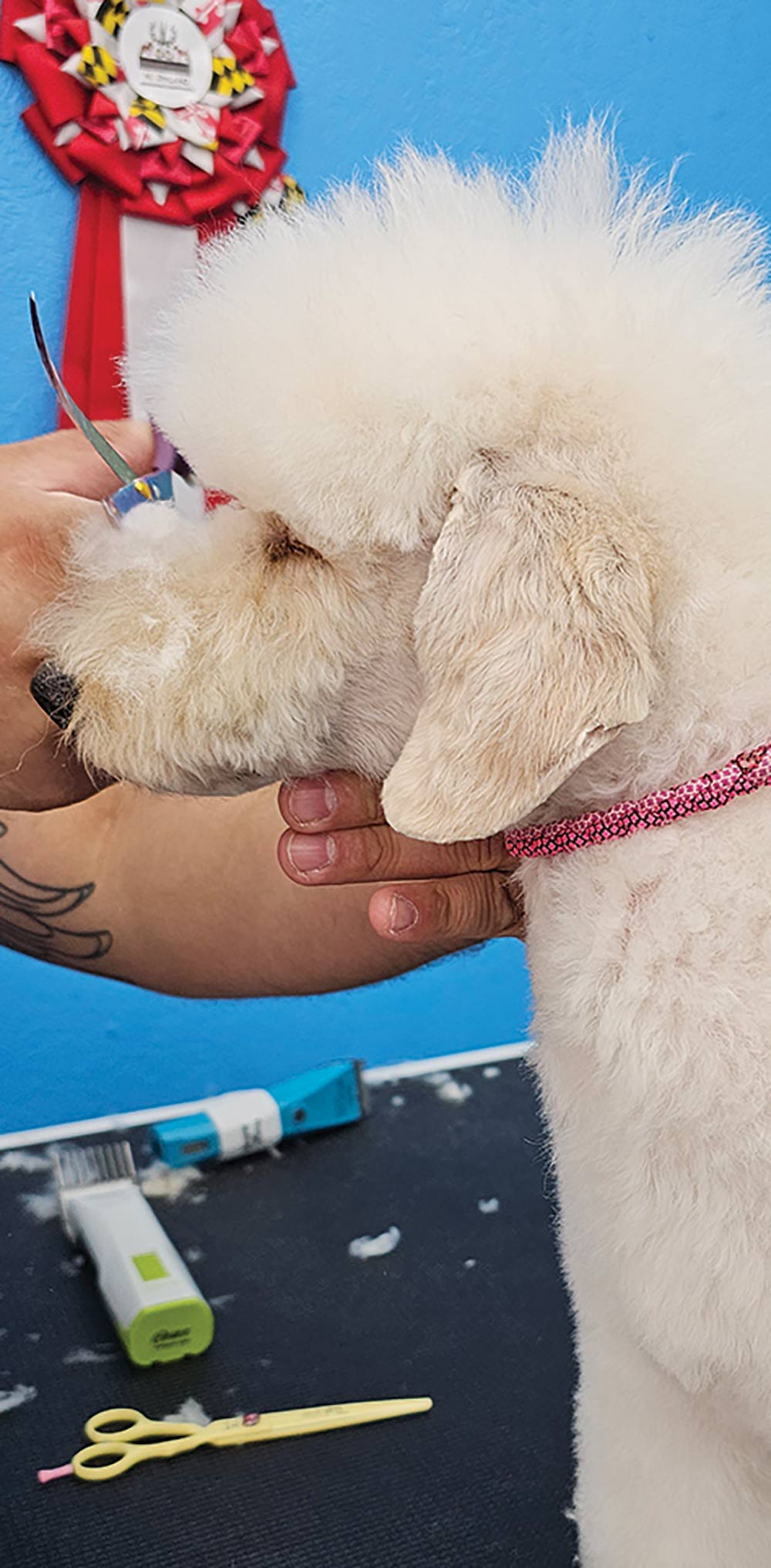

Photo by Anjie Coates
 inn is a Miniature Pinscher who has a reputation for biting everyone and anyone when he doesn’t get his way. However, his owners are rather shocked that he’s so compliant for most of his groom…
inn is a Miniature Pinscher who has a reputation for biting everyone and anyone when he doesn’t get his way. However, his owners are rather shocked that he’s so compliant for most of his groom… “Hi, Finn. You ready for a spa day?” I ask.
“Hi, Finn. You ready for a spa day?” I ask.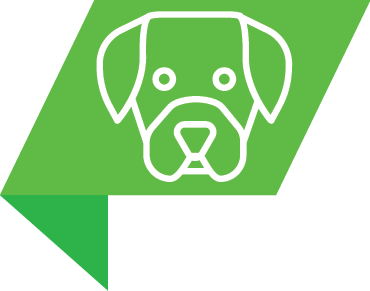 Finn gives me the side-eye and sighs as I scoop him off the floor, take his harness off and hand it to his Dad.
Finn gives me the side-eye and sighs as I scoop him off the floor, take his harness off and hand it to his Dad. “Aww c’mon, buddy, it’s not so bad. You need a bath, and you need those nails trimmed. Sometimes I wonder if you’re growing them into weapons, they grow so fast each month.” I say.
“Aww c’mon, buddy, it’s not so bad. You need a bath, and you need those nails trimmed. Sometimes I wonder if you’re growing them into weapons, they grow so fast each month.” I say. Finn: “Yeah, well I am. So you better watch it.”
Finn: “Yeah, well I am. So you better watch it.” “Are you done being a grouch? Can we skip to the good-boy part now please?” I ask.
“Are you done being a grouch? Can we skip to the good-boy part now please?” I ask. Finn: “I guess so. You’re kind of annoying though, you know.”
Finn: “I guess so. You’re kind of annoying though, you know.” “Oh, I know. But you need grooming,” I tell him.
“Oh, I know. But you need grooming,” I tell him. Finn: “Yeah, well, one of these days I’m going to bite you.”
Finn: “Yeah, well, one of these days I’m going to bite you.” “No, you’re not, buddy. Because just before you get there, you win the Amazomatic Bitestopper 1,000!” I tell him as I point to the basket muzzle that is always on hand for when he gets that look in his eye and chooses violence.
“No, you’re not, buddy. Because just before you get there, you win the Amazomatic Bitestopper 1,000!” I tell him as I point to the basket muzzle that is always on hand for when he gets that look in his eye and chooses violence. Finn scoffs but he knows I’m serious, because we’ve had to use it before.
Finn scoffs but he knows I’m serious, because we’ve had to use it before. “In all these years, and all these grooms, have I ever hurt you?” I ask.
“In all these years, and all these grooms, have I ever hurt you?” I ask.



 Finn: “Yes…You hurt my feelings!”
Finn: “Yes…You hurt my feelings!” “What? How?” I exclaim.
“What? How?” I exclaim. Finn: “You know I bite, but you aren’t afraid. I’m big, tough and strong, and you don’t even notice!
Finn: “You know I bite, but you aren’t afraid. I’m big, tough and strong, and you don’t even notice! “Oh, now that’s where you’re wrong, buddy. I notice. I’m not afraid of you though. I don’t do anything to cause you any pain, frighten you, or…well, OK…maybe the nail trimming is annoying, but it doesn’t hurt.” I say.
“Oh, now that’s where you’re wrong, buddy. I notice. I’m not afraid of you though. I don’t do anything to cause you any pain, frighten you, or…well, OK…maybe the nail trimming is annoying, but it doesn’t hurt.” I say. Finn: “It is annoying. You’re not going to buy me off with treats or head rubs either. I know your tricks and I’m not falling for it.”
Finn: “It is annoying. You’re not going to buy me off with treats or head rubs either. I know your tricks and I’m not falling for it.” “OK, good to know. Can you turn? I need to get your other side.” I ask.
“OK, good to know. Can you turn? I need to get your other side.” I ask. Finn dutifully turns, forgetting he’s supposed to be defiant.
Finn dutifully turns, forgetting he’s supposed to be defiant. “OK, let’s get you dried up, shall we?” I ask.
“OK, let’s get you dried up, shall we?” I ask. Finn: “Yeah, warm towel. It’s about time!”
Finn: “Yeah, warm towel. It’s about time!” I lift him out of the tub and carry him to my table. I call out for my assistant, Angie, as we walk down the hall.
I lift him out of the tub and carry him to my table. I call out for my assistant, Angie, as we walk down the hall.Angie walks in and grabs a Finn-sized muzzle as I take out the rotary tool.
 Finn: “I see what you’re doing. I’m not letting you. I’m not.”
Finn: “I see what you’re doing. I’m not letting you. I’m not.”


 “Relax, buddy. Take a deep breath and this will all be over super-fast,” I say.
“Relax, buddy. Take a deep breath and this will all be over super-fast,” I say.Angie begins rubbing under his ears and his eyes glaze over in happiness.
I quickly get his nails done, and on the last toenail of the last foot, the realization he’s been tricked again occurs.
 Finn: “Oh no, you didn’t!”
Finn: “Oh no, you didn’t!” “There, you made it through another nail trim.” I say.
“There, you made it through another nail trim.” I say. Finn is about to protest, but he realizes the time for it has passed as I’m brushing him out, which he loves.
Finn is about to protest, but he realizes the time for it has passed as I’m brushing him out, which he loves. Finn: “Good thing you finished when you did. I’d have bitten you for sure.”
Finn: “Good thing you finished when you did. I’d have bitten you for sure.” “Uh huh. I know. We’re almost done, buddy. After this, we’ll get your picture taken,” I tell him.
“Uh huh. I know. We’re almost done, buddy. After this, we’ll get your picture taken,” I tell him. Finn: “Any good costumes?”
Finn: “Any good costumes?” “I think you’ll find one you like,” I say.
“I think you’ll find one you like,” I say. Finn: “We’ll see…”
Finn: “We’ll see…” I finish him up and carry him to the picture room where I offer him a choice between two costumes. He snorts at the Wolfman costume and chooses the other.
I finish him up and carry him to the picture room where I offer him a choice between two costumes. He snorts at the Wolfman costume and chooses the other. Finn: “So, how does it look?”
Finn: “So, how does it look?” “I think your mom would call it oddly fitting,” I say.
“I think your mom would call it oddly fitting,” I say. Finn smiles for the camera.
Finn smiles for the camera. “You did really well today and I’m sorry if your feelings were hurt. I actually care about you, you know? I want you to be happy,” I tell him.
“You did really well today and I’m sorry if your feelings were hurt. I actually care about you, you know? I want you to be happy,” I tell him. Finn: “I know. I kinda like you too. Don’t tell anyone though, it’ll ruin my reputation. OK?”
Finn: “I know. I kinda like you too. Don’t tell anyone though, it’ll ruin my reputation. OK?” And I reply,
And I reply,
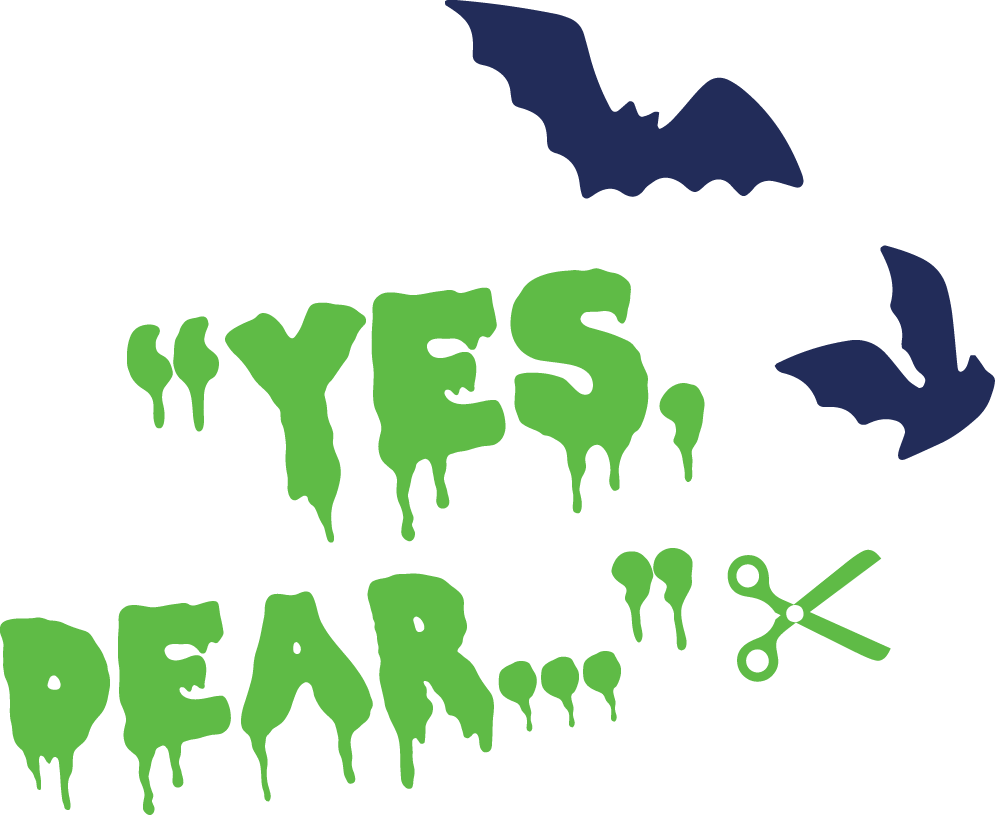
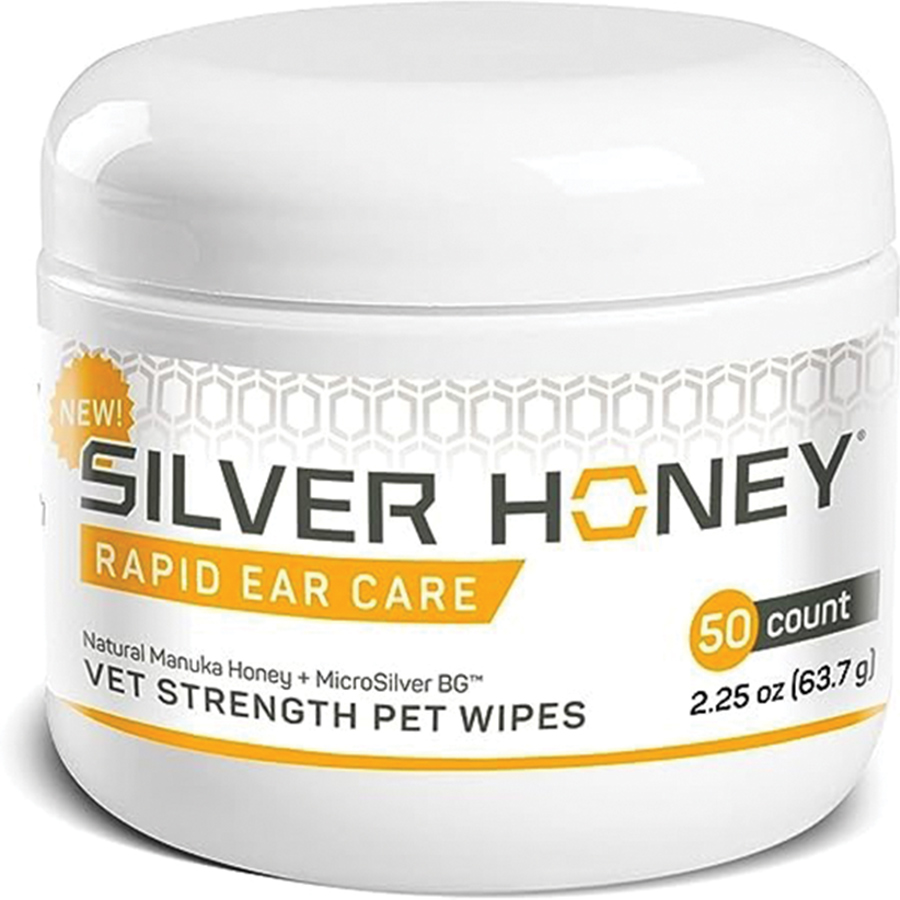

Rates: 25 words or less – $50.00 | Each additional word – $2.00 each
Classified ads must be prepaid | Call for issue deadlines.
Agency Discounts Do Not Apply.


